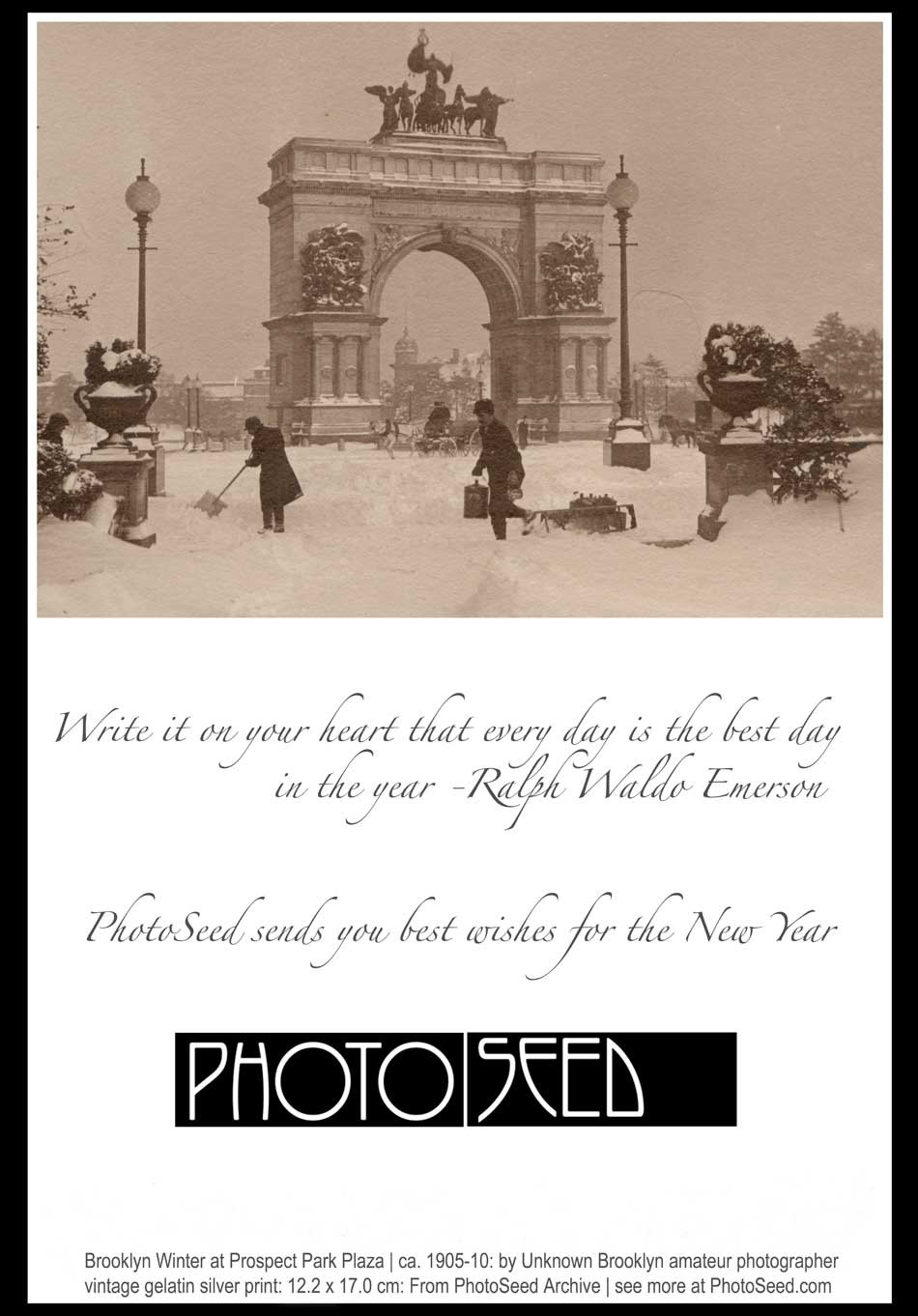Year
2016
5 entries in this year | view all years
Stages for Ages
Posted April 2016 in Exhibitions, History of Photography, New Additions, Publishing, Significant Photographers
All the world’s a stage, And all the men and women merely players: They have their exits and their entrances; And one man in his time plays many parts, His acts being seven ages.
-From As You Like It, Act II. Scene VII, Jaques’s speech
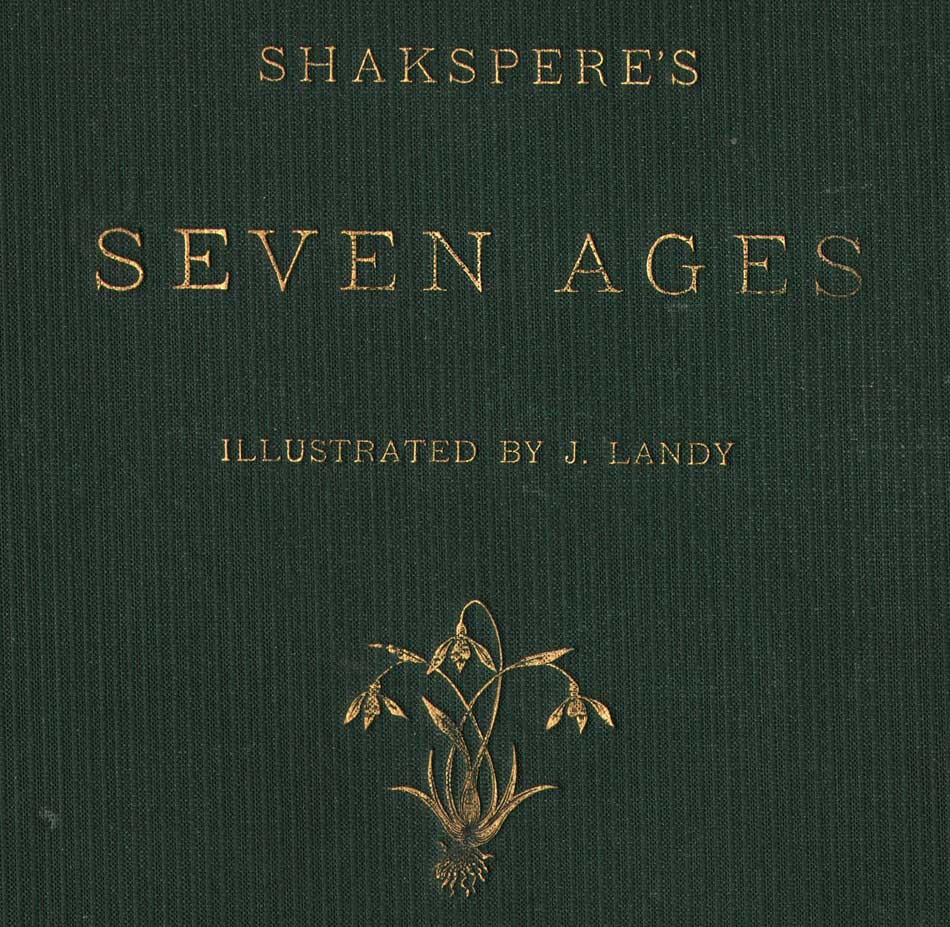 Detail: book cover: "Shakspere’s Seven Ages" Illustrated by J. Landy: Octavo with letterpress and seven individual pasted albumen portrait photographs by Landy: Cincinnati: Robert Clarke & Co., 1876: from: PhotoSeed Archive
Detail: book cover: "Shakspere’s Seven Ages" Illustrated by J. Landy: Octavo with letterpress and seven individual pasted albumen portrait photographs by Landy: Cincinnati: Robert Clarke & Co., 1876: from: PhotoSeed Archive
In life, Birthdays typically get all the attention. At least while your friends are around. Not so much death. But for certain souls long departed this mortal coil, it’s just as important. This is especially true for English playwright and poet William Shakespeare, whose passing on April 23, 1616 at 52 years of age- or 400 years ago today- seems like a perfectly good excuse to throw a party as well. Cincinnati portrait photographer James M. Landy (1838-1897) would have readily agreed, and he used the excuse of another anniversary-America’s first Centennial held in 1876 in Philadelphia- to showcase his new series of “character photographs” illustrating the Bard’s Seven Ages of Man from his play As You Like It . (1.)
Come along on a short photographic journey exploring these ages of the male species, according to Shakespeare. Have they changed with the passage of time?
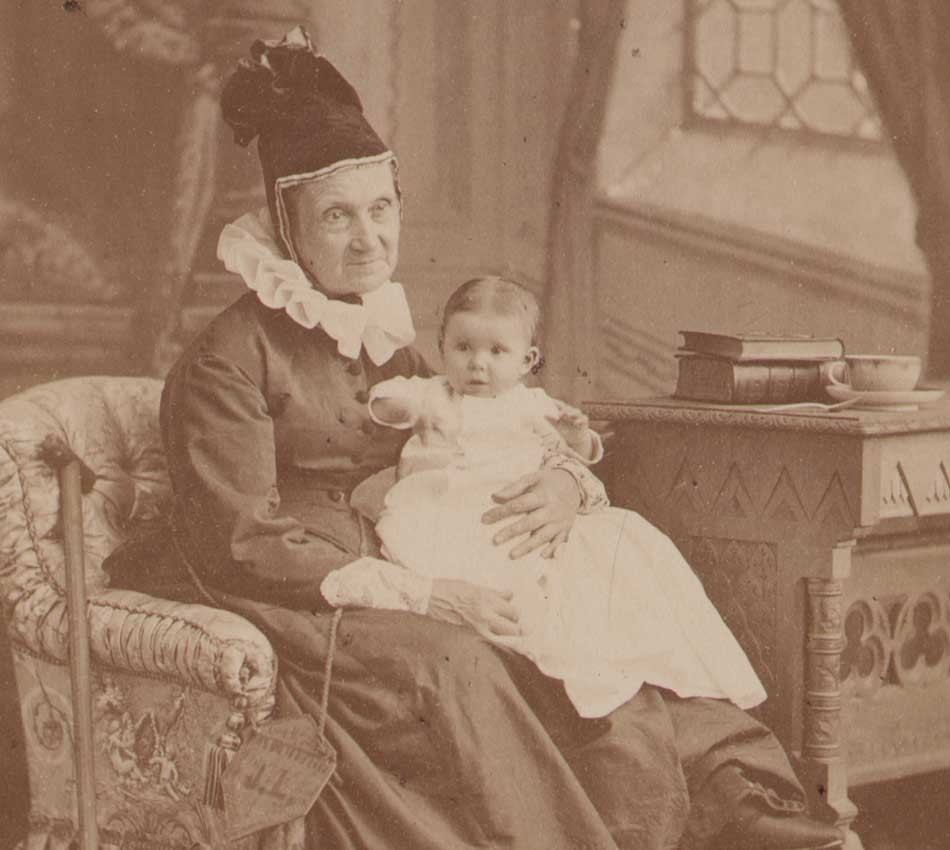 The First Age: Detail: "The Infant" : James M. Landy, American: 1876: pasted albumen print included in the volume "Shakspere’s Seven Ages": 14.0 x 9.9 | 24.7 x 19.0 cm: Cincinnati: Robert Clarke & Co., 1876. Captioned text opposite book plate: "At first the infant, Mewling and puking in the nurse’s arms.": From: PhotoSeed Archive
The First Age: Detail: "The Infant" : James M. Landy, American: 1876: pasted albumen print included in the volume "Shakspere’s Seven Ages": 14.0 x 9.9 | 24.7 x 19.0 cm: Cincinnati: Robert Clarke & Co., 1876. Captioned text opposite book plate: "At first the infant, Mewling and puking in the nurse’s arms.": From: PhotoSeed Archive
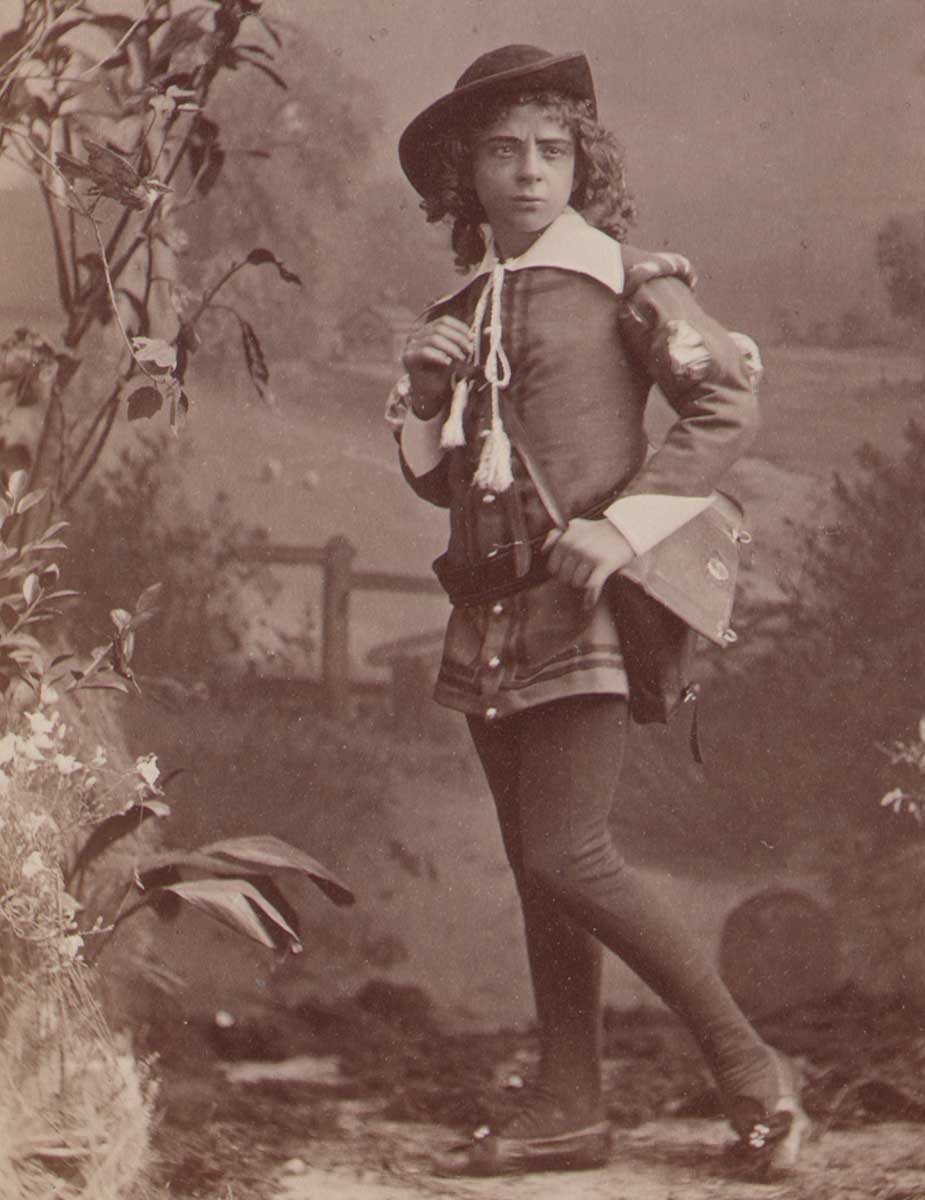 The Second Age: Detail: "The Schoolboy": James M. Landy, American: 1876: pasted albumen print included in the volume "Shakspere’s Seven Ages": 14.0 x 9.9 | 24.7 x 19.0 cm: Cincinnati: Robert Clarke & Co., 1876. Captioned text opposite book plate: "Then the whining school-boy, with his satchel, And shining morning face, creeping like snail Unwillingly to school." From: PhotoSeed Archive
The Second Age: Detail: "The Schoolboy": James M. Landy, American: 1876: pasted albumen print included in the volume "Shakspere’s Seven Ages": 14.0 x 9.9 | 24.7 x 19.0 cm: Cincinnati: Robert Clarke & Co., 1876. Captioned text opposite book plate: "Then the whining school-boy, with his satchel, And shining morning face, creeping like snail Unwillingly to school." From: PhotoSeed Archive
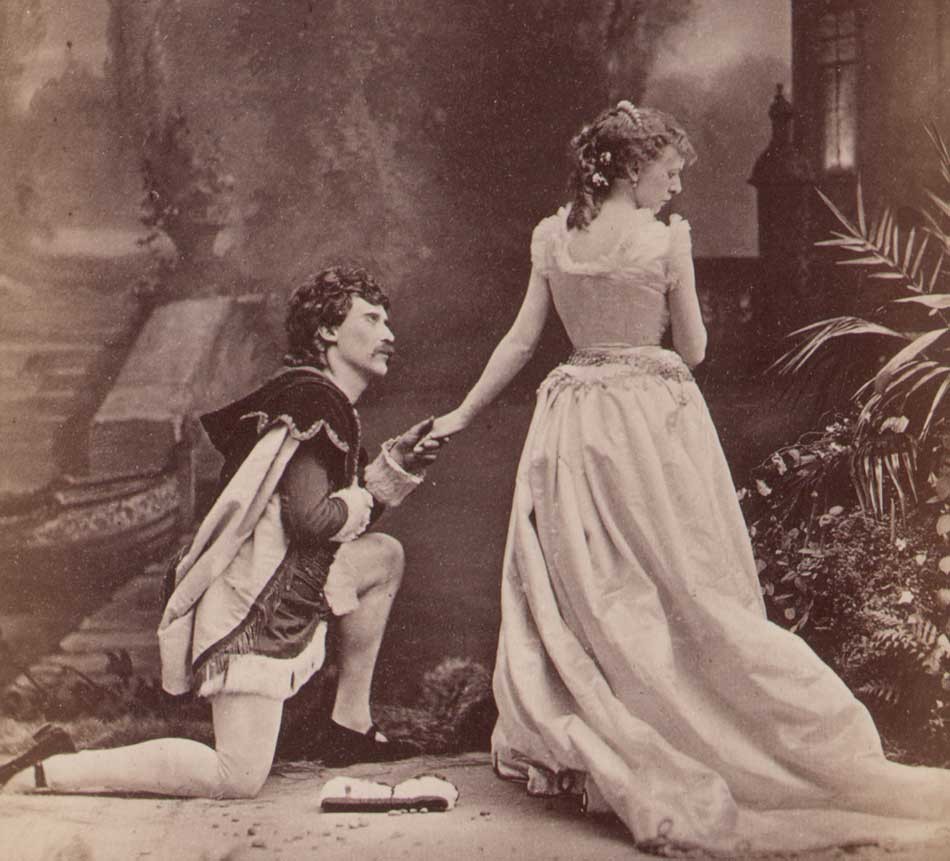 The Third Age: Detail: "The Lover": James M. Landy, American: 1876: pasted albumen print included in the volume "Shakspere’s Seven Ages": 14.3 x 9.9 | 24.7 x 19.0 cm: Cincinnati: Robert Clarke & Co., 1876. Captioned text opposite book plate: "And then the lover, Sighing like furnace, with a woful ballad Made to his mistress’ eyebrow." From: PhotoSeed Archive
The Third Age: Detail: "The Lover": James M. Landy, American: 1876: pasted albumen print included in the volume "Shakspere’s Seven Ages": 14.3 x 9.9 | 24.7 x 19.0 cm: Cincinnati: Robert Clarke & Co., 1876. Captioned text opposite book plate: "And then the lover, Sighing like furnace, with a woful ballad Made to his mistress’ eyebrow." From: PhotoSeed Archive
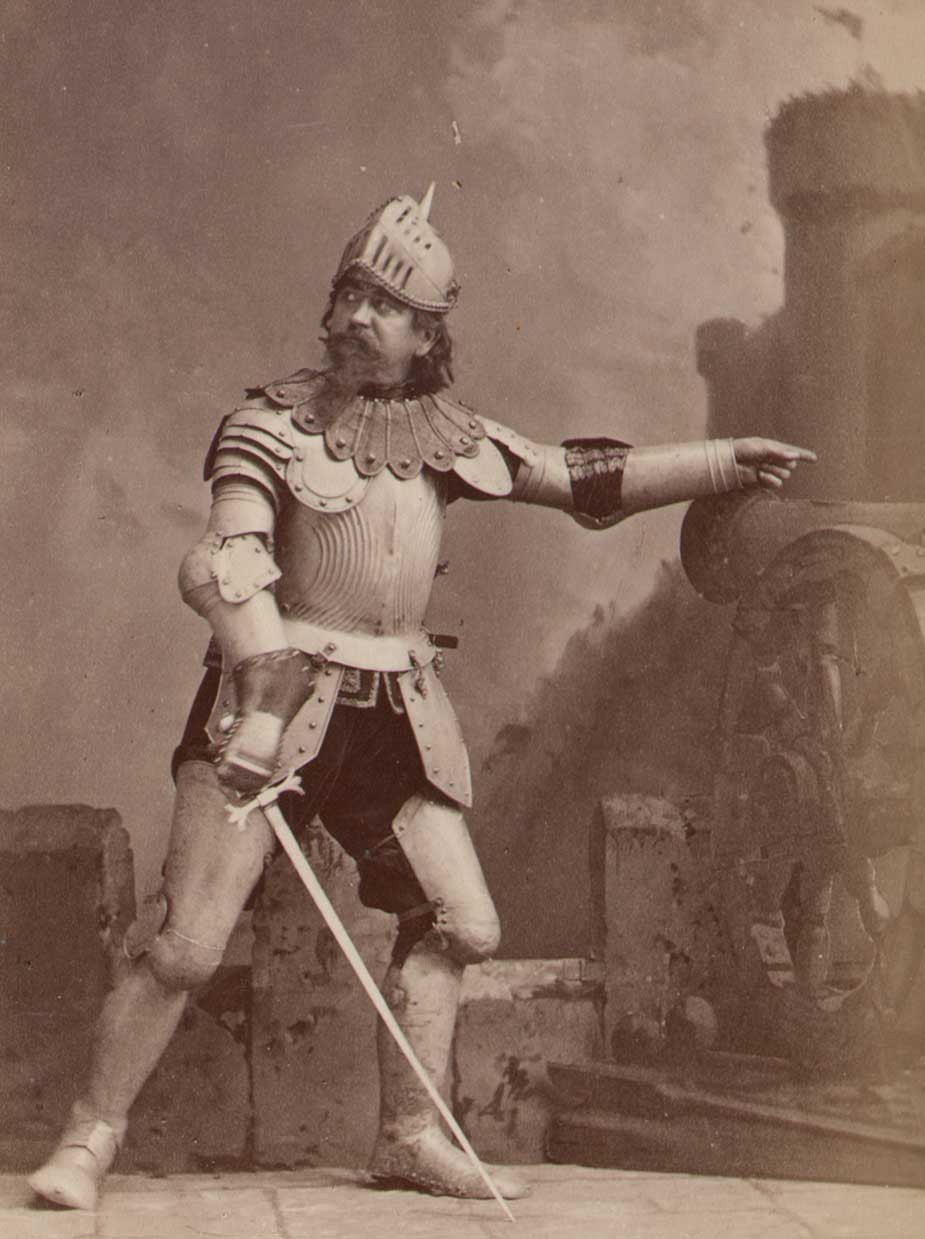 The Fourth Age: Detail: "The Soldier": James M. Landy, American: 1876: pasted albumen print included in the volume "Shakspere’s Seven Ages": 14.0 x 9.9 | 24.7 x 19.0 cm: Cincinnati: Robert Clarke & Co., 1876. Captioned text opposite book plate: "Then a soldier, Full of strange oaths, and bearded like the pard, Jealous in honor, sudden and quick in quarrel, Seeking the bubble reputation Even in the cannon’s mouth." From: PhotoSeed Archive
The Fourth Age: Detail: "The Soldier": James M. Landy, American: 1876: pasted albumen print included in the volume "Shakspere’s Seven Ages": 14.0 x 9.9 | 24.7 x 19.0 cm: Cincinnati: Robert Clarke & Co., 1876. Captioned text opposite book plate: "Then a soldier, Full of strange oaths, and bearded like the pard, Jealous in honor, sudden and quick in quarrel, Seeking the bubble reputation Even in the cannon’s mouth." From: PhotoSeed Archive
 The Fifth Age: "The Justice": James M. Landy, American: 1876: pasted albumen print included in the volume "Shakspere’s Seven Ages": 14.3 x 9.7 | 24.7 x 19.0 cm: Cincinnati: Robert Clarke & Co., 1876. Captioned text opposite book plate: "And then the Justice, In fair round belly, with good capon lin'd, With eyes severe, and beard of formal cut, Full of wise saws and modern instances; And so he plays his part." From: PhotoSeed Archive
The Fifth Age: "The Justice": James M. Landy, American: 1876: pasted albumen print included in the volume "Shakspere’s Seven Ages": 14.3 x 9.7 | 24.7 x 19.0 cm: Cincinnati: Robert Clarke & Co., 1876. Captioned text opposite book plate: "And then the Justice, In fair round belly, with good capon lin'd, With eyes severe, and beard of formal cut, Full of wise saws and modern instances; And so he plays his part." From: PhotoSeed Archive
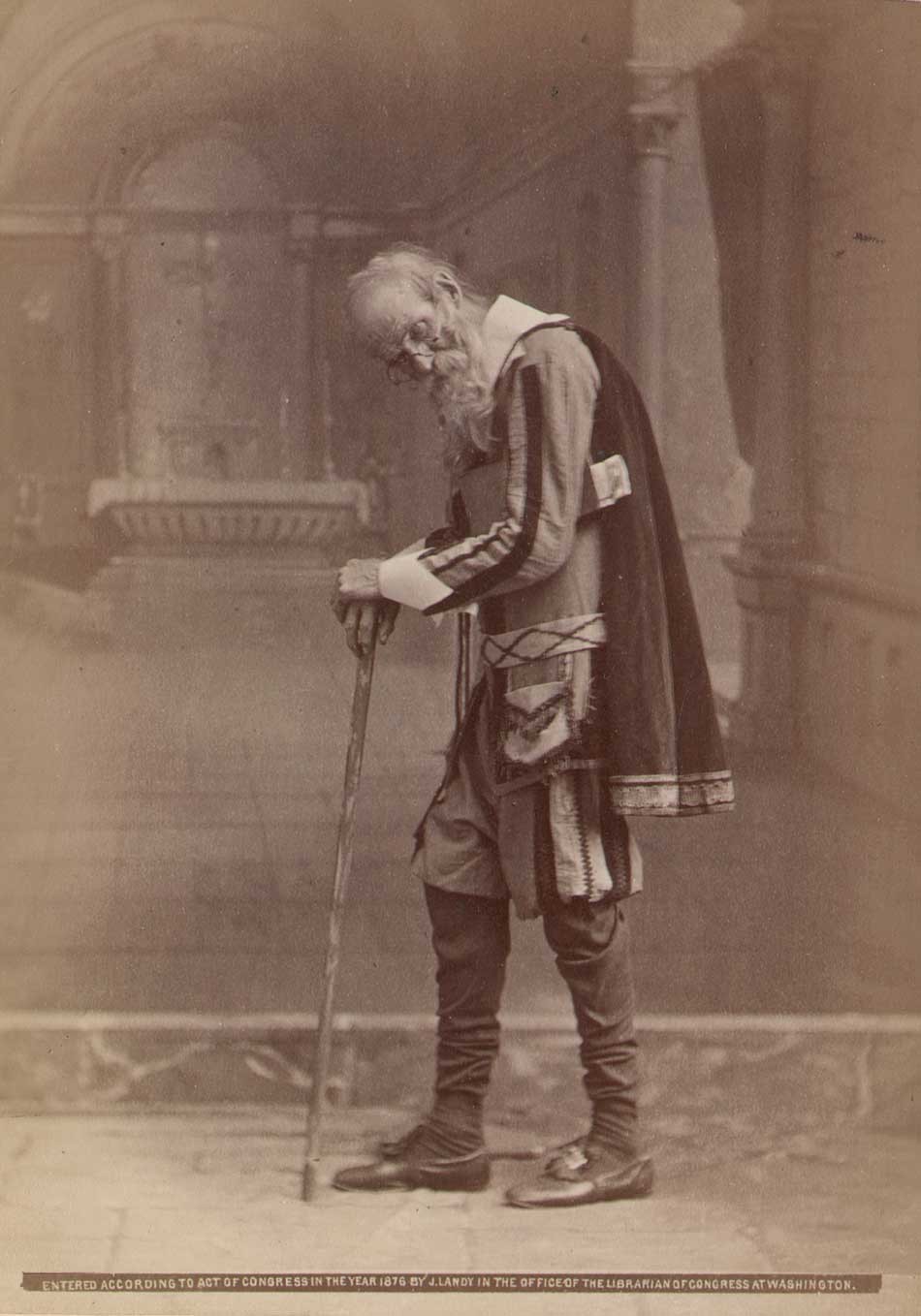 The Sixth Age: "The Lean and Slipper’d Pantaloon": James M. Landy, American: 1876: pasted albumen print included in the volume "Shakspere’s Seven Ages": 14.0 x 9.9 | 24.7 x 19.0 cm: Cincinnati: Robert Clarke & Co., 1876. Captioned text opposite book plate: "The sixth age shifts Into the lean and slipper’d pantaloon, With spectacles on nose and pouch on side, His youthful hose well saved, a world too wide For his shrunk shank; and his big manly voice, Turning again toward childish treble, pipes And whistles in his sound." From: PhotoSeed Archive
The Sixth Age: "The Lean and Slipper’d Pantaloon": James M. Landy, American: 1876: pasted albumen print included in the volume "Shakspere’s Seven Ages": 14.0 x 9.9 | 24.7 x 19.0 cm: Cincinnati: Robert Clarke & Co., 1876. Captioned text opposite book plate: "The sixth age shifts Into the lean and slipper’d pantaloon, With spectacles on nose and pouch on side, His youthful hose well saved, a world too wide For his shrunk shank; and his big manly voice, Turning again toward childish treble, pipes And whistles in his sound." From: PhotoSeed Archive
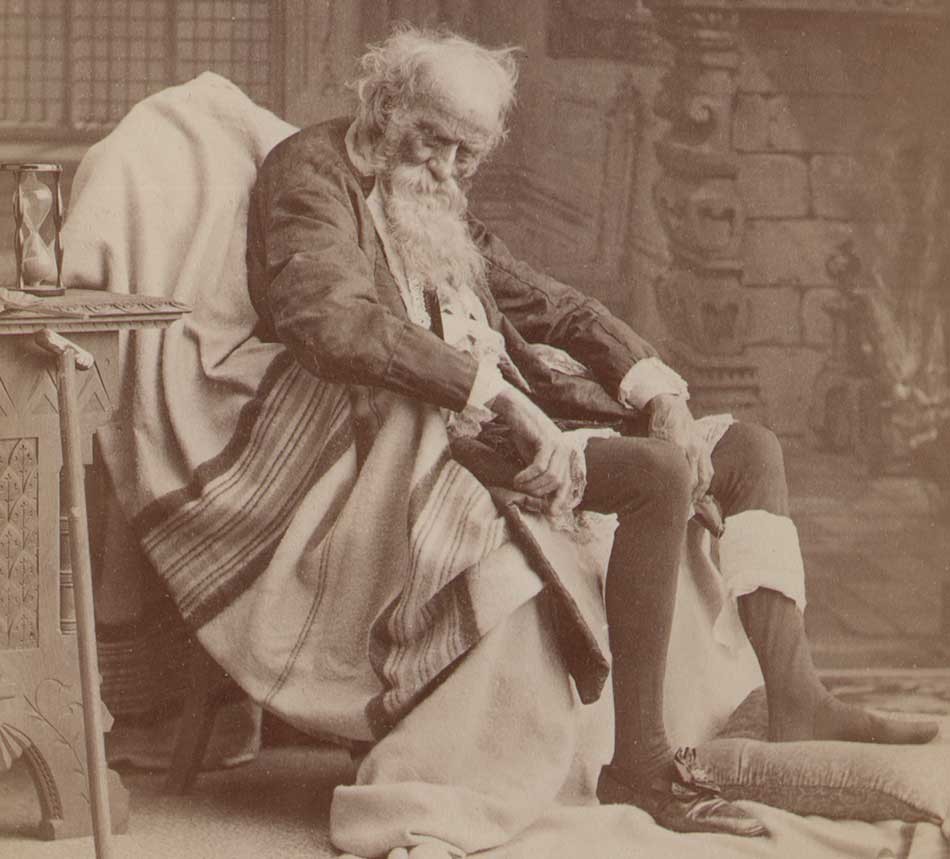 The Seventh Age: Detail: "Sans Teeth, Sans Eyes, Sans Taste, Sans Everything": James M. Landy, American: 1876: pasted albumen print included in the volume "Shakspere’s Seven Ages": 14.0 x 9.9 | 24.7 x 19.0 cm: Cincinnati: Robert Clarke & Co., 1876. Captioned text opposite book plate: "Last scene of all That ends this strange eventful history, Is second childishness and mere oblivion— Sans teeth, sans eyes, sans taste, sans everything.” From: PhotoSeed Archive
The Seventh Age: Detail: "Sans Teeth, Sans Eyes, Sans Taste, Sans Everything": James M. Landy, American: 1876: pasted albumen print included in the volume "Shakspere’s Seven Ages": 14.0 x 9.9 | 24.7 x 19.0 cm: Cincinnati: Robert Clarke & Co., 1876. Captioned text opposite book plate: "Last scene of all That ends this strange eventful history, Is second childishness and mere oblivion— Sans teeth, sans eyes, sans taste, sans everything.” From: PhotoSeed Archive
1. James Landy: from: Artists in Ohio, 1787-1900: A Biographical Dictionary, Mary Sayre Haverstock et al: Kent State University Press, 2000: p. 506
SpringSprung
Posted April 2016 in Alternate Processes, Color Photography, Fashion Photography, New Additions, Unknown Photographers
The Northern Hemisphere has once again thankfully undergone rebirth, becoming the season of spring and with it, all the hope it represents for the continuation of our natural and human worlds.
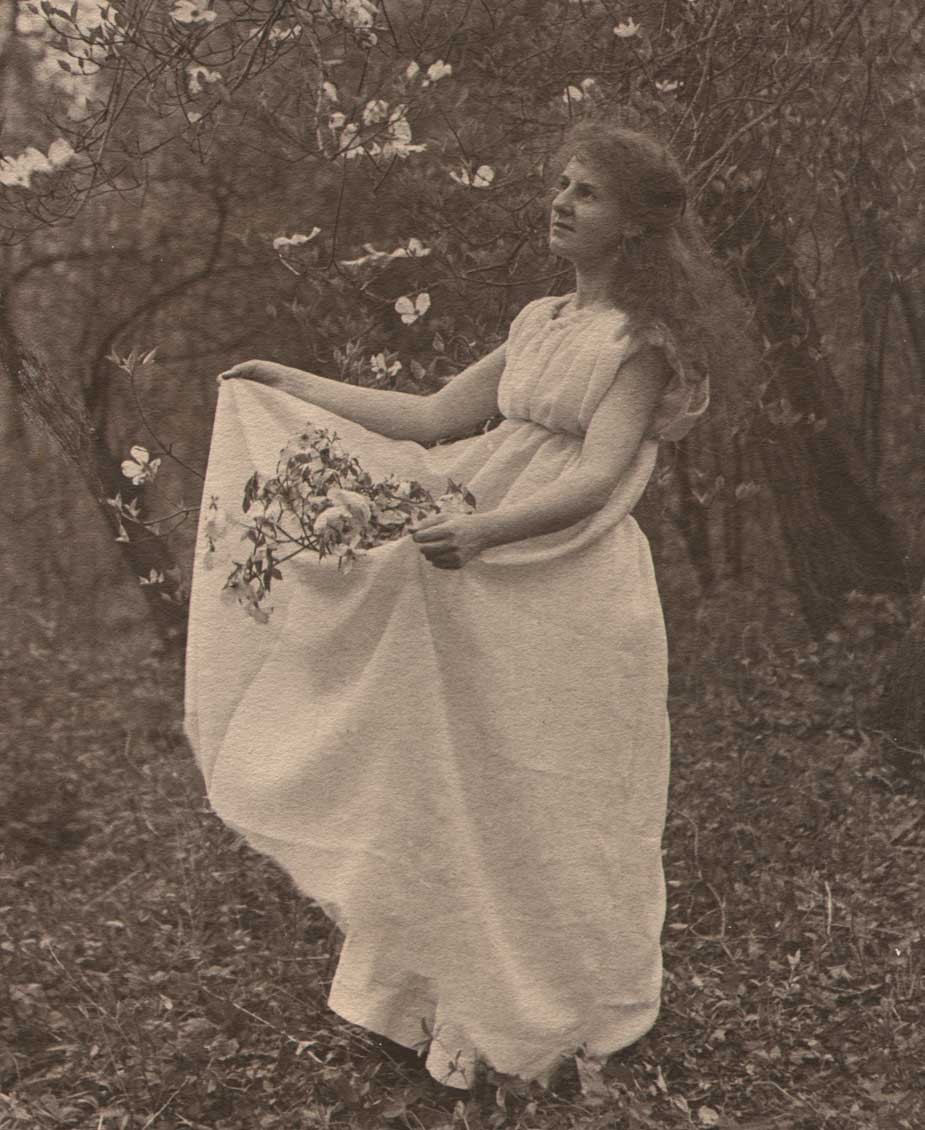 Detail: "Curtis High School Girl Gathering Dogwood Boughs": Charles Rollins Tucker: American: platinum: ca. 1910-15: 19.7 x 13.1 | 30.5 x 23.3 cm: A genre landscape study celebrating both spring and womanhood, the model is perhaps a thespian known to have attended Curtis High School on Staten Island in New York City, where photographer C.R. Tucker taught Physics at the time. From: PhotoSeed Archive
Detail: "Curtis High School Girl Gathering Dogwood Boughs": Charles Rollins Tucker: American: platinum: ca. 1910-15: 19.7 x 13.1 | 30.5 x 23.3 cm: A genre landscape study celebrating both spring and womanhood, the model is perhaps a thespian known to have attended Curtis High School on Staten Island in New York City, where photographer C.R. Tucker taught Physics at the time. From: PhotoSeed Archive
Photographically, with the exceptions of those open-minded enough to embrace the obvious-something Alfred Stieglitz seized upon in 1893 when winter proved more than suitable for subject matter- the majority of amateurs a bit later at the turn of the 20th century seemed interested in dusting off their cameras only when those first buds and flowers of the season awoke once more.
This abbreviated compilation of images spanning the 1890’s through about 1940 from the PhotoSeed Archive-no matter how dated they may appear from the mores of days long gone by- is a reaffirmation dedicated to you that spring’s beauty and potential might give us all a bit of hope towards the future betterment of our often fragmented, present-day world. David Spencer- April, 2016
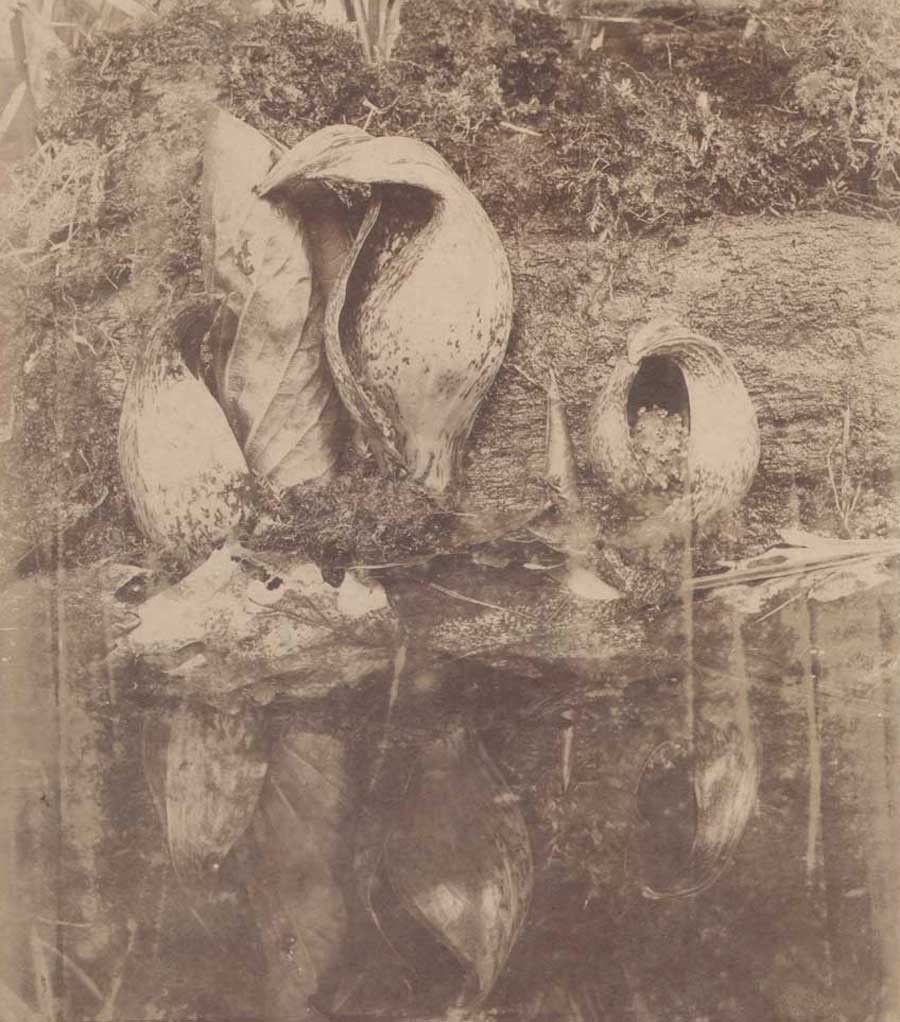 Detail: "Harbingers of Spring": Louise Birt Baynes: American: gelatin silver: 1904: 20.8 x 15.5 | 35.6 x 27.9 cm: This study of skunk cabbage growing in the spring time may have been taken using an artificial light source. Author Frank Roy Fraprie mentioned the work in his article on photographing wild flowers for the March, 1904 issue of Boston’s Photo-Era magazine: "The plant must be photographed in its surroundings, for it has no stem or leaves at this season, to make possible a graceful arrangement at home, even if one were inclined to extend it hospitality. Mrs. Baynes has conquered all these difficulties, and her picture, “Harbingers of Spring,” is interesting to both the naturalist and the artistic photographer, - to one for its fidelity and to the other for its good composition." From: PhotoSeed Archive
Detail: "Harbingers of Spring": Louise Birt Baynes: American: gelatin silver: 1904: 20.8 x 15.5 | 35.6 x 27.9 cm: This study of skunk cabbage growing in the spring time may have been taken using an artificial light source. Author Frank Roy Fraprie mentioned the work in his article on photographing wild flowers for the March, 1904 issue of Boston’s Photo-Era magazine: "The plant must be photographed in its surroundings, for it has no stem or leaves at this season, to make possible a graceful arrangement at home, even if one were inclined to extend it hospitality. Mrs. Baynes has conquered all these difficulties, and her picture, “Harbingers of Spring,” is interesting to both the naturalist and the artistic photographer, - to one for its fidelity and to the other for its good composition." From: PhotoSeed Archive
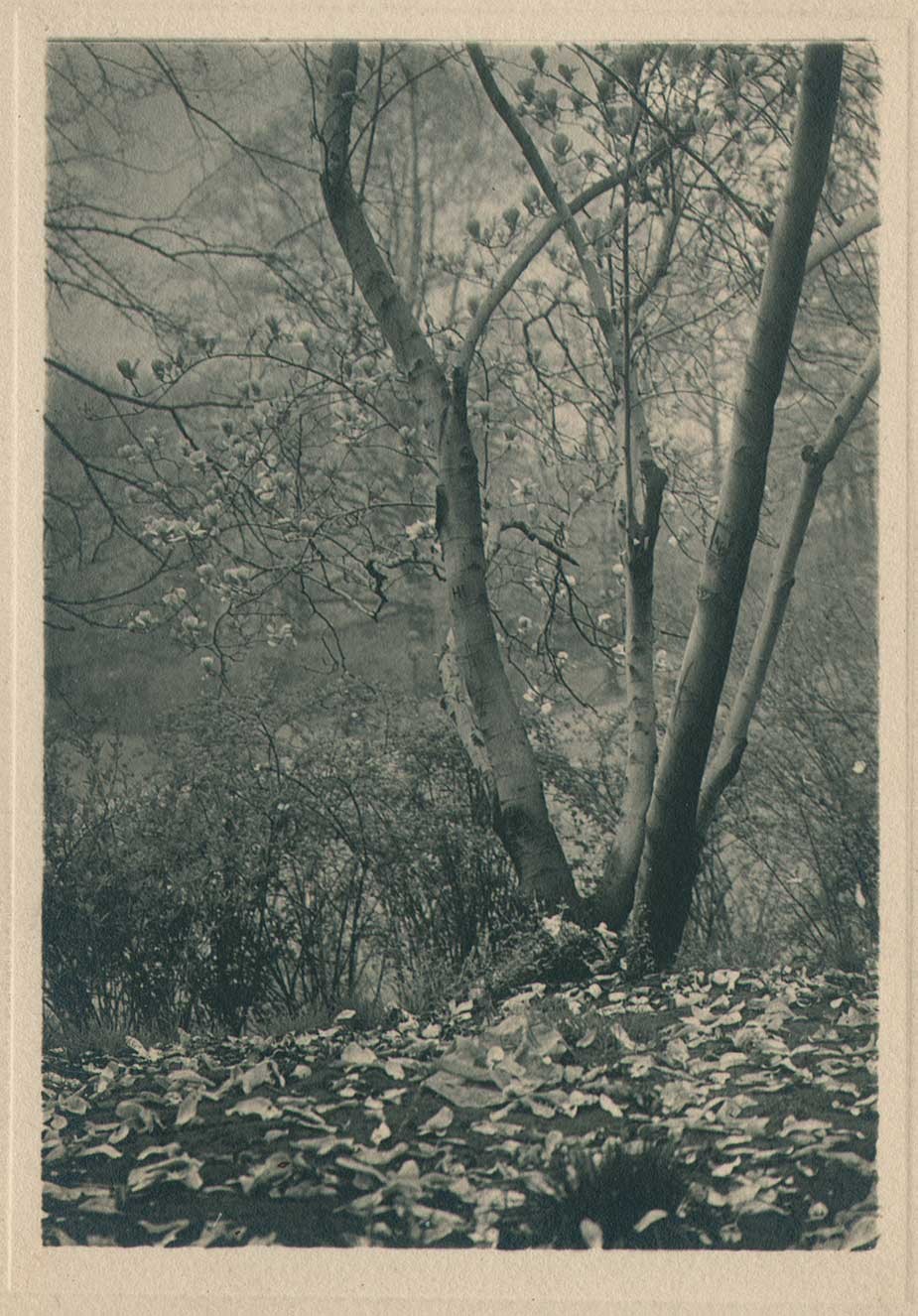 "Spring Vista with Fallen Leaves": by Unknown Brooklyn (photographer) : American: carbon?: ca. 1905-10: 11.9 x 8.2 | 17.8 x 12.1 cm: What are believed to be Magnolia tree blossoms litter the ground in the foreground of this spring landscape study featuring a blooming Magnolia in the background, with the setting believed to be Brooklyn's Prospect Park as many known examples of this location were taken by this photographer. This photograph, with title supplied by this archive, is by an Unknown Brooklyn amateur photographer whose surviving work was discovered in a trunk in the American South. Background can be found by searching for this site's 2015 blog post: "No Junk in Trunk". From: PhotoSeed Archive
"Spring Vista with Fallen Leaves": by Unknown Brooklyn (photographer) : American: carbon?: ca. 1905-10: 11.9 x 8.2 | 17.8 x 12.1 cm: What are believed to be Magnolia tree blossoms litter the ground in the foreground of this spring landscape study featuring a blooming Magnolia in the background, with the setting believed to be Brooklyn's Prospect Park as many known examples of this location were taken by this photographer. This photograph, with title supplied by this archive, is by an Unknown Brooklyn amateur photographer whose surviving work was discovered in a trunk in the American South. Background can be found by searching for this site's 2015 blog post: "No Junk in Trunk". From: PhotoSeed Archive
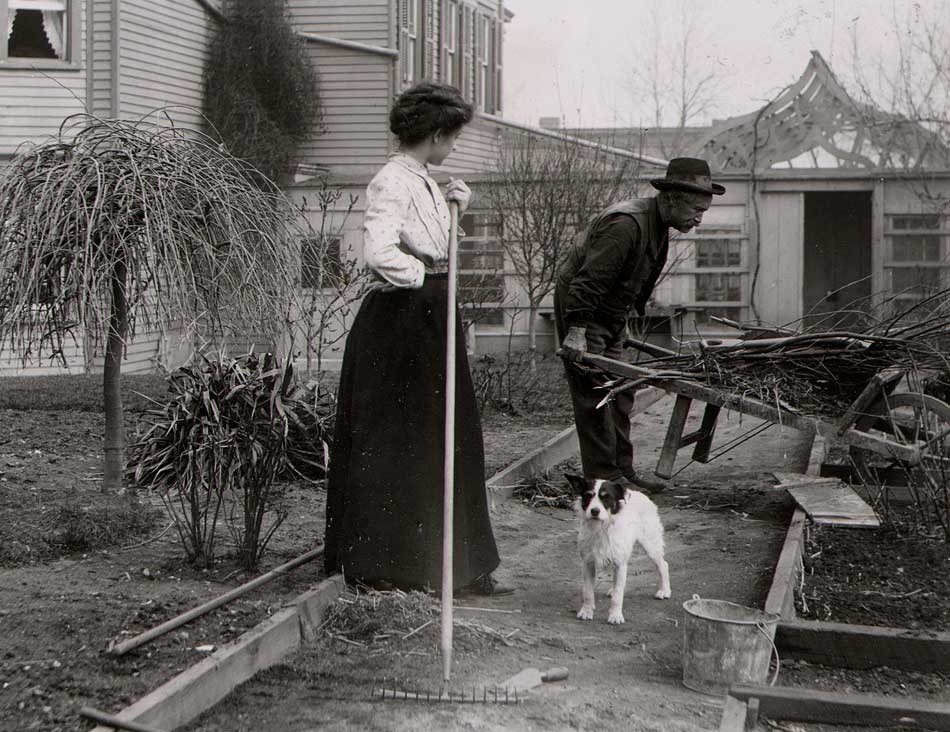 Detail: "Cleaning up the Yard in Spring": c. 1900-05 by Jeanette Bernard: American, born Germany: (1855-1941) gelatin silver print c. 1935-40 from original glass plate negative acquired by Culver Service : 15.4 x 13.9 cm: alternate title: "Woman and Man Gardening"-George Eastman House NEG: 40724: 83:2640:0025: A spring cleaning study in a garden shows the photographer's daughter with pet terrier dog at her feet watching as a gentleman (perhaps a hired man) prepares to move a collection of dead branches using a wheelbarrow. From: PhotoSeed Archive
Detail: "Cleaning up the Yard in Spring": c. 1900-05 by Jeanette Bernard: American, born Germany: (1855-1941) gelatin silver print c. 1935-40 from original glass plate negative acquired by Culver Service : 15.4 x 13.9 cm: alternate title: "Woman and Man Gardening"-George Eastman House NEG: 40724: 83:2640:0025: A spring cleaning study in a garden shows the photographer's daughter with pet terrier dog at her feet watching as a gentleman (perhaps a hired man) prepares to move a collection of dead branches using a wheelbarrow. From: PhotoSeed Archive
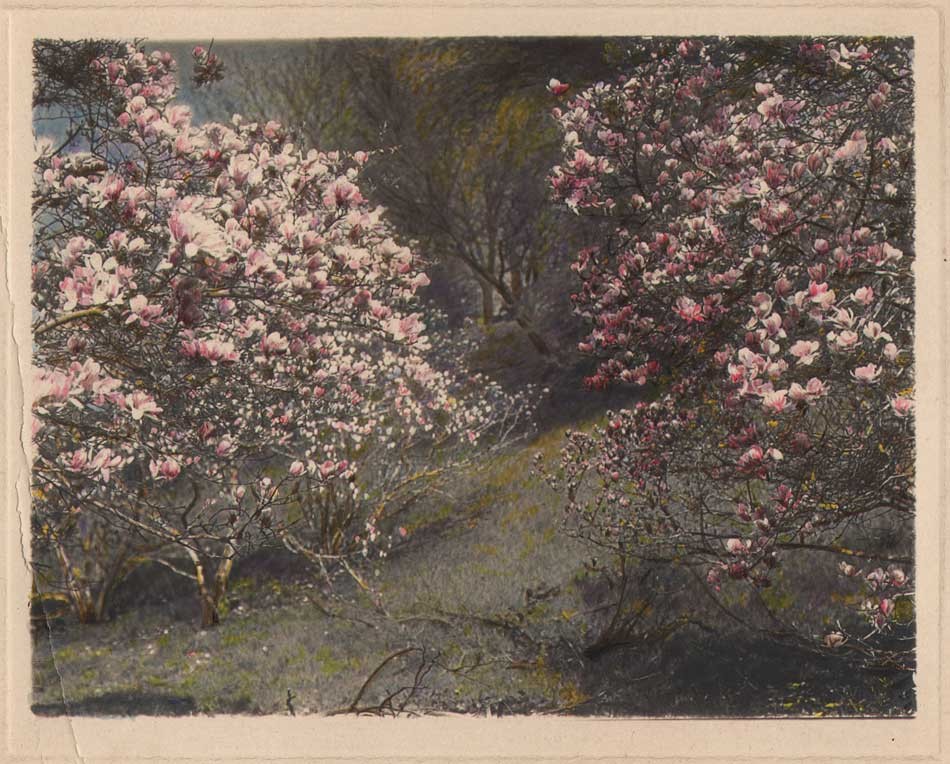 "Magnolia Trees Blooming in Spring": by Unknown Brooklyn (photographer) : American: gelatin silver (hand-colored) from copy print: ca. 1910-15: 9.0 x 11.6 | 12.4 x 16.4 cm: This hand-colored landscape study showing several blooming Magnolia trees is believed to have been taken at Brooklyn's Prospect Park as many known examples of this location were taken by this photographer. This photograph, with title supplied by this archive, is by an Unknown Brooklyn amateur photographer whose surviving work was discovered in a trunk in the American South. Background can be found by searching for this site's 2015 blog post: "No Junk in Trunk". From: PhotoSeed Archive
"Magnolia Trees Blooming in Spring": by Unknown Brooklyn (photographer) : American: gelatin silver (hand-colored) from copy print: ca. 1910-15: 9.0 x 11.6 | 12.4 x 16.4 cm: This hand-colored landscape study showing several blooming Magnolia trees is believed to have been taken at Brooklyn's Prospect Park as many known examples of this location were taken by this photographer. This photograph, with title supplied by this archive, is by an Unknown Brooklyn amateur photographer whose surviving work was discovered in a trunk in the American South. Background can be found by searching for this site's 2015 blog post: "No Junk in Trunk". From: PhotoSeed Archive
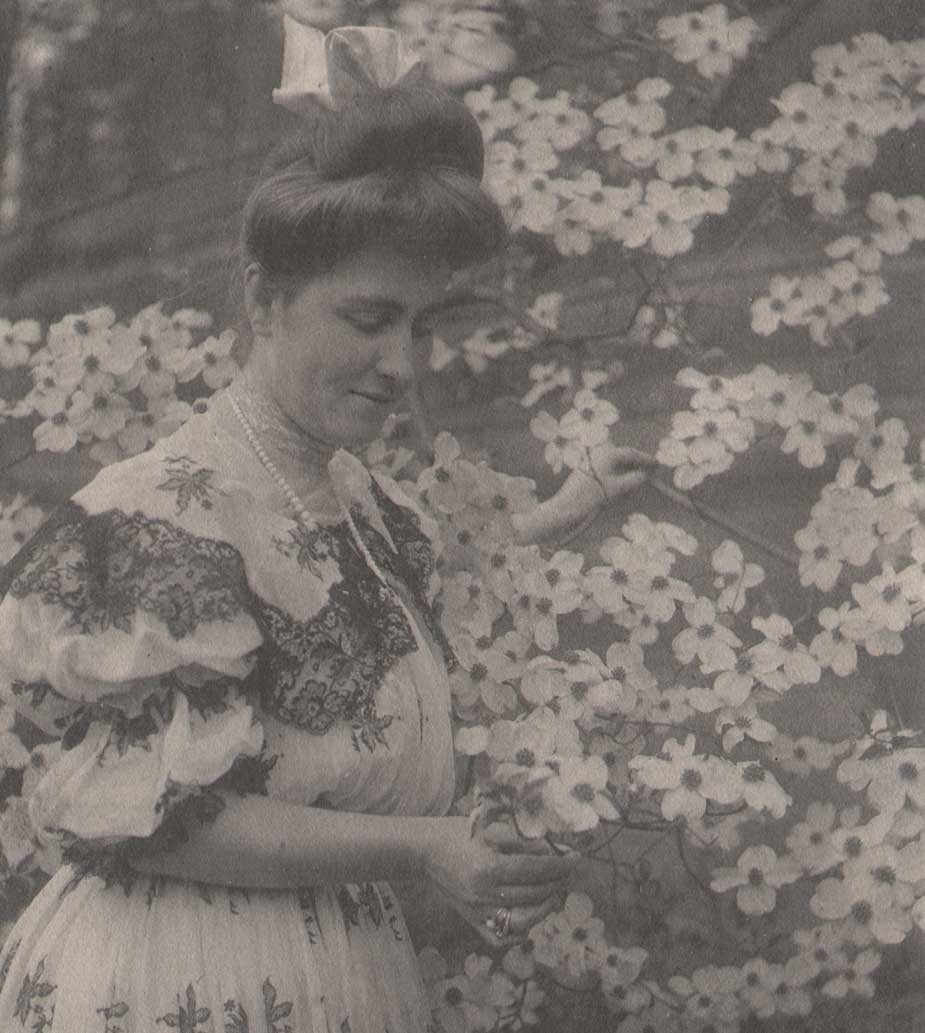 Detail: "Clare Shipman with Dogwood Blossoms": C.M. Shipman: American: platinum: 1904 or before: 17.5 x 11.8 cm | 27.9 x 36.0 cm tipped to black art-paper leaf from album: Born ca. 1880, Clare Cressey Shipman, spouse of amateur photographer Charles Melville Shipman, (1874-1947) examines a cluster of dogwood blossoms, most likely taken in the borough of Richmond on Staten Island, New York City, where the couple lived at the time. The photograph was included with other mostly naturalistic studies compiled in an album by the photographer with the final photograph signed and dated 1904. From: PhotoSeed Archive
Detail: "Clare Shipman with Dogwood Blossoms": C.M. Shipman: American: platinum: 1904 or before: 17.5 x 11.8 cm | 27.9 x 36.0 cm tipped to black art-paper leaf from album: Born ca. 1880, Clare Cressey Shipman, spouse of amateur photographer Charles Melville Shipman, (1874-1947) examines a cluster of dogwood blossoms, most likely taken in the borough of Richmond on Staten Island, New York City, where the couple lived at the time. The photograph was included with other mostly naturalistic studies compiled in an album by the photographer with the final photograph signed and dated 1904. From: PhotoSeed Archive
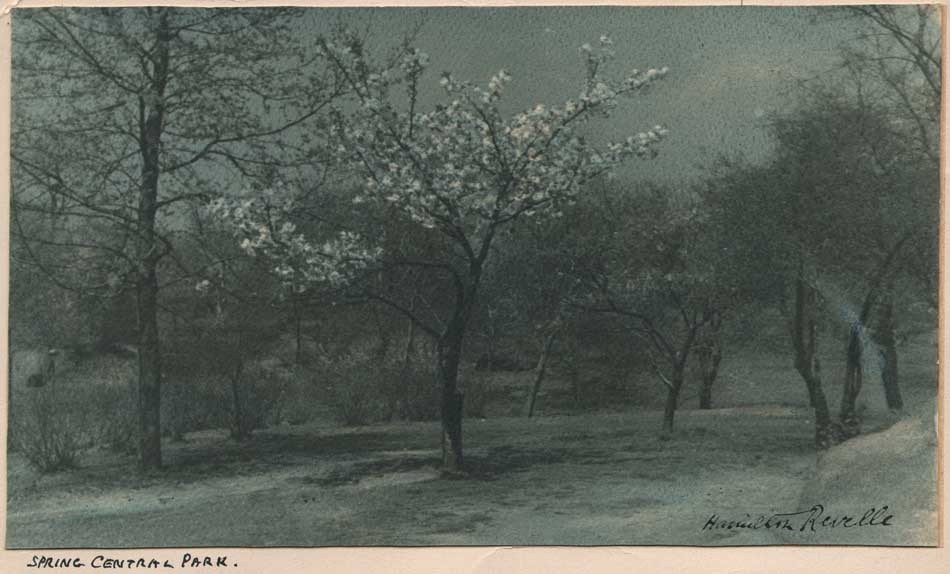 "Spring Central Park": Hamilton Revelle, (1872-1958) English, born Gibraltar: bromoil (hand-colored) ca. 1930-40: 10.2 x 18.5 | 14.3 x 22.4 cm: This delicate hand-colored, blue hued study of a blooming tree in springtime in New York City's Central Park was probably done in the early 1930's along with another landscape study shown with this post. A British born stage and screen actor and consummate amateur photography on the side, he later specialized in the bromoil-transfer process after mastering other processes. The Broadway Photographs website includes a short bio: "Revelle's intense interest in photography perhaps derived from the art's capacity to arrest beauty in timeless perfection. He began carrying his camera equipment with him everywhere and spent his days, before going to the theater in early evening, perfecting his technical mastery of the medium, in platinum, silver, and autochrome. He was an avid experimenter with various printing papers and popularized the print of works on parchment. His portraits were displayed in international salons regularly during the first decade of the 20th century. The Royal Photographic Society of London awarded him its gold medal for excellence in portraiture." From: PhotoSeed Archive
"Spring Central Park": Hamilton Revelle, (1872-1958) English, born Gibraltar: bromoil (hand-colored) ca. 1930-40: 10.2 x 18.5 | 14.3 x 22.4 cm: This delicate hand-colored, blue hued study of a blooming tree in springtime in New York City's Central Park was probably done in the early 1930's along with another landscape study shown with this post. A British born stage and screen actor and consummate amateur photography on the side, he later specialized in the bromoil-transfer process after mastering other processes. The Broadway Photographs website includes a short bio: "Revelle's intense interest in photography perhaps derived from the art's capacity to arrest beauty in timeless perfection. He began carrying his camera equipment with him everywhere and spent his days, before going to the theater in early evening, perfecting his technical mastery of the medium, in platinum, silver, and autochrome. He was an avid experimenter with various printing papers and popularized the print of works on parchment. His portraits were displayed in international salons regularly during the first decade of the 20th century. The Royal Photographic Society of London awarded him its gold medal for excellence in portraiture." From: PhotoSeed Archive
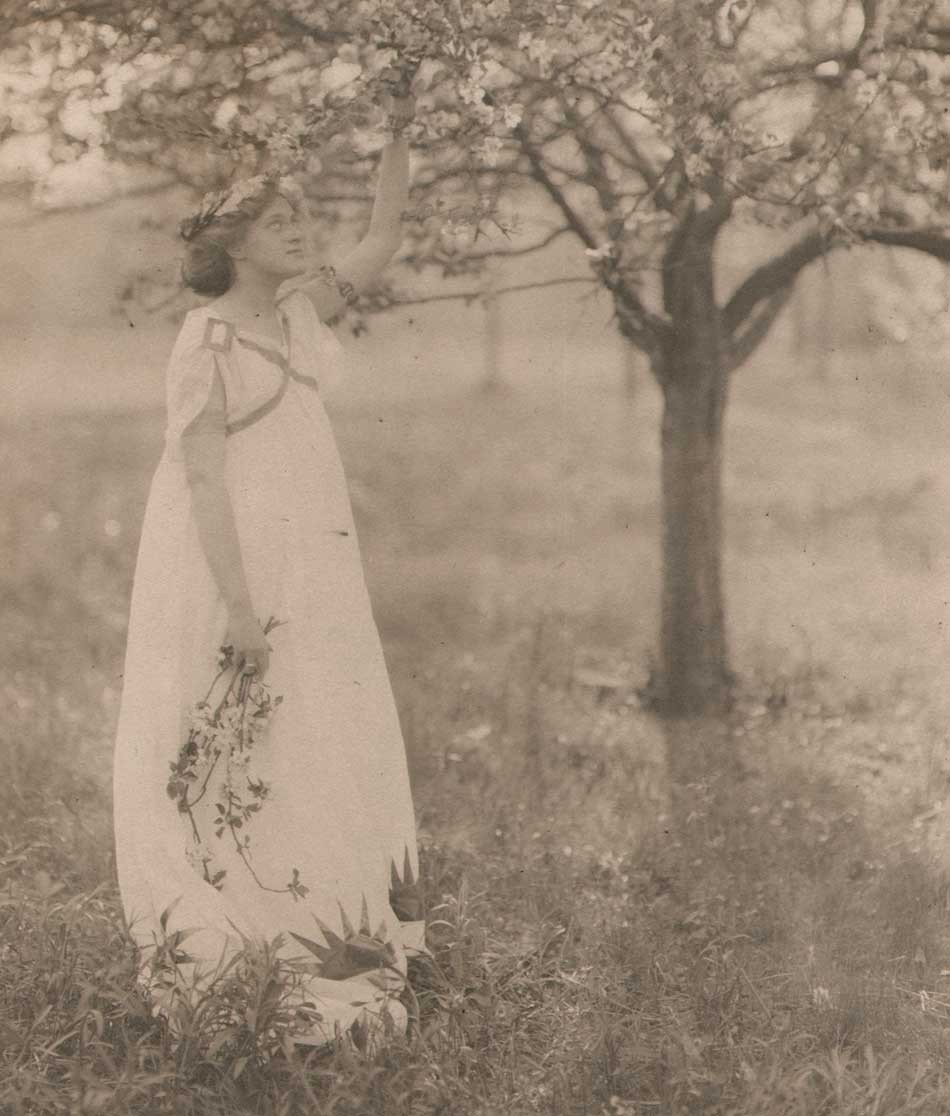 Detail: "Apple Blossoms": Charles Rollins Tucker: American: platinum: ca. 1905-10: 20.3 x 14.7 | 32.7 x 25.5 cm: A genre landscape study celebrating both spring and womanhood, (notice the sunbursts at the bottom of her dress) the model is perhaps a thespian who most likely attended Curtis High School on Staten Island in New York City, where photographer C.R. Tucker taught Physics at the time. From: PhotoSeed Archive
Detail: "Apple Blossoms": Charles Rollins Tucker: American: platinum: ca. 1905-10: 20.3 x 14.7 | 32.7 x 25.5 cm: A genre landscape study celebrating both spring and womanhood, (notice the sunbursts at the bottom of her dress) the model is perhaps a thespian who most likely attended Curtis High School on Staten Island in New York City, where photographer C.R. Tucker taught Physics at the time. From: PhotoSeed Archive
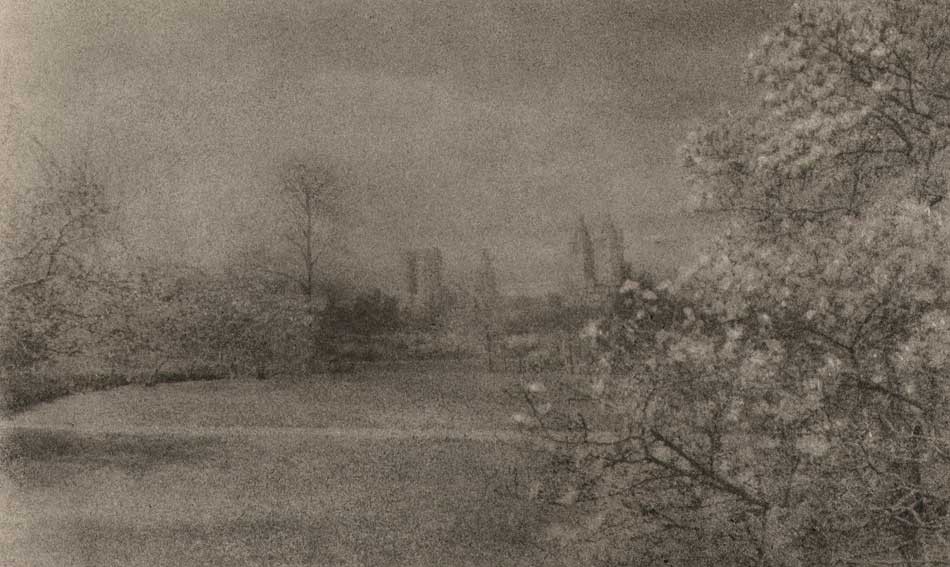 "Central Park Spring with Eldorado": Hamilton Revelle, (1872-1958) English, born Gibraltar: bromoil: ca. 1935-40: 11.5 x 18.5 | 17.6 x 27.8 cm: This bromoil landscape study taken in New York City's Central Park includes a few hints of the Manhattan skyline, including the luxury twin-spired Eldorado apartment building opened in 1931, seen just to the left of the blooming tree on the right side of frame. A British born stage and screen actor and consummate amateur photographer, Revelle later specialized in the bromoil-transfer process after mastering other photographic processes. From: PhotoSeed Archive
"Central Park Spring with Eldorado": Hamilton Revelle, (1872-1958) English, born Gibraltar: bromoil: ca. 1935-40: 11.5 x 18.5 | 17.6 x 27.8 cm: This bromoil landscape study taken in New York City's Central Park includes a few hints of the Manhattan skyline, including the luxury twin-spired Eldorado apartment building opened in 1931, seen just to the left of the blooming tree on the right side of frame. A British born stage and screen actor and consummate amateur photographer, Revelle later specialized in the bromoil-transfer process after mastering other photographic processes. From: PhotoSeed Archive
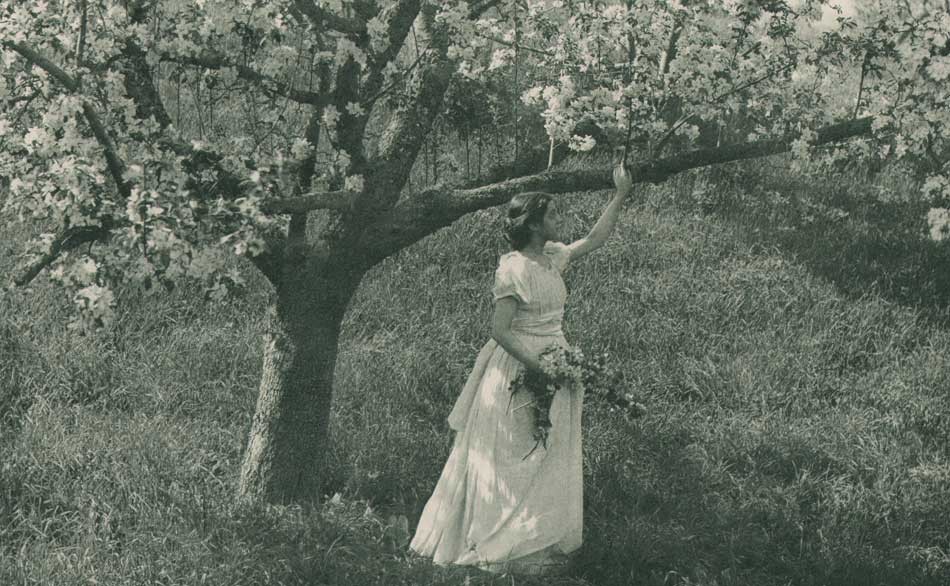 Detail: "Apple Blossoms": Emma Justine Farsworth, American: hand-pulled photogravure published in periodical "Sun & Shade" New York: June, 1893: whole #58: N.Y. Photogravure Co.: 17.0 x 21.7 cm | 27.5 x 34.7 cm: From: PhotoSeed Archive
Detail: "Apple Blossoms": Emma Justine Farsworth, American: hand-pulled photogravure published in periodical "Sun & Shade" New York: June, 1893: whole #58: N.Y. Photogravure Co.: 17.0 x 21.7 cm | 27.5 x 34.7 cm: From: PhotoSeed Archive
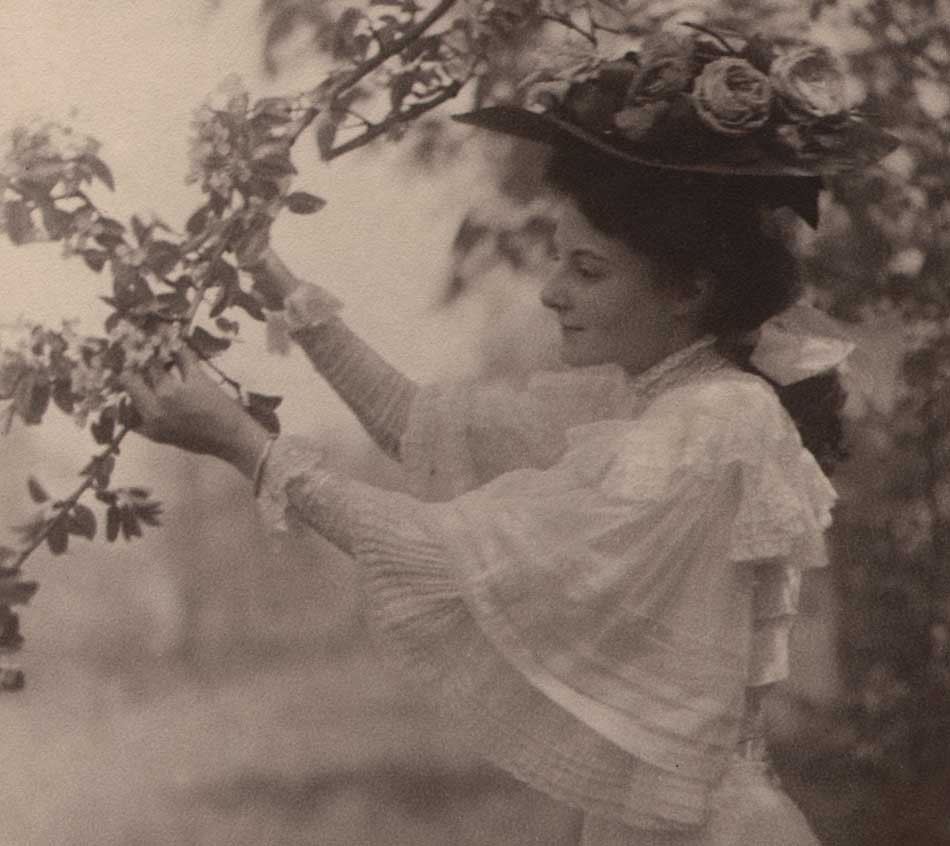 Detail: "Mary Tucker with Apple Blossoms": Charles Rollins Tucker: American: platinum: ca. 1905-10: 26.1 x 19.2 | 30.0 x 22.0 cm: Mary (Carruthers) Tucker, (1870-1940) spouse of amateur photographer C.R. Tucker, holds a bough of blossoms from an apple tree while wearing a hat adorned with flowers in this classic genre study celebrating womanhood in early spring. From: PhotoSeed Archive
Detail: "Mary Tucker with Apple Blossoms": Charles Rollins Tucker: American: platinum: ca. 1905-10: 26.1 x 19.2 | 30.0 x 22.0 cm: Mary (Carruthers) Tucker, (1870-1940) spouse of amateur photographer C.R. Tucker, holds a bough of blossoms from an apple tree while wearing a hat adorned with flowers in this classic genre study celebrating womanhood in early spring. From: PhotoSeed Archive
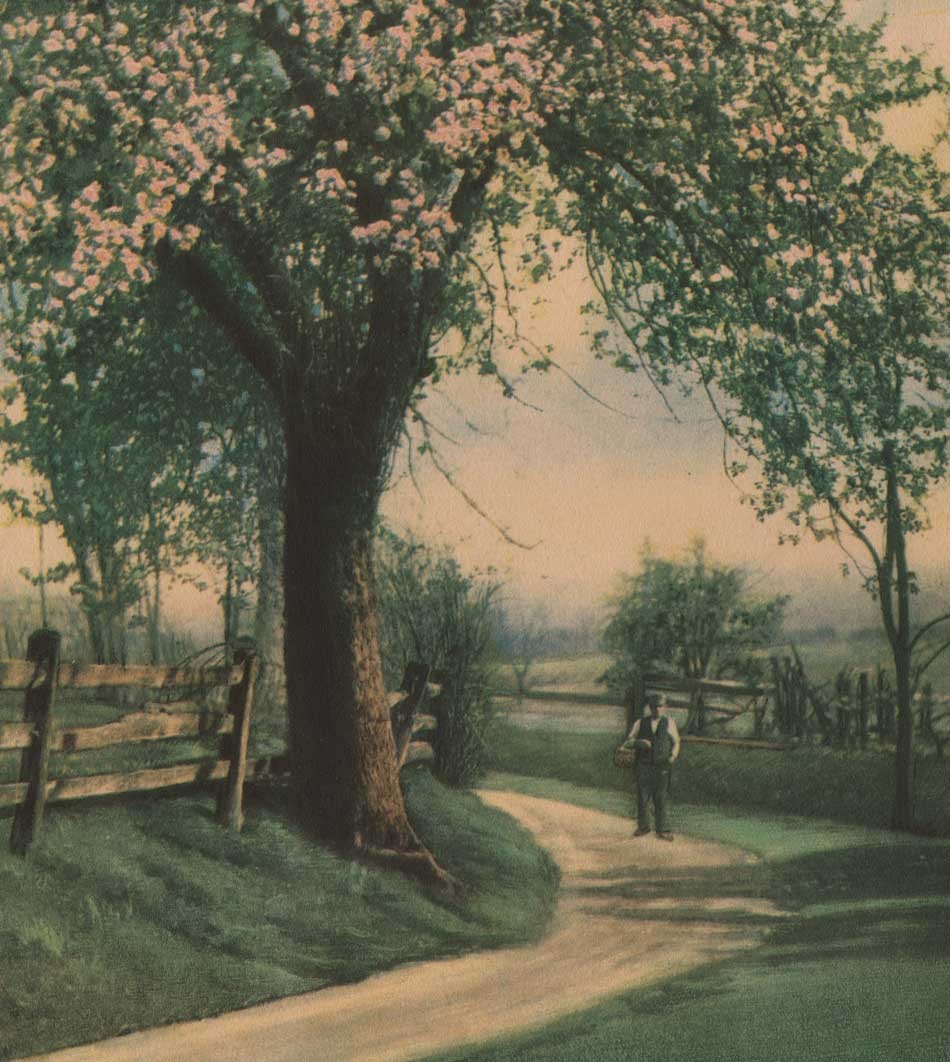 Detail: "In Apple Blossom Time": Henry Troth: American: lithograph, four-color: ca. 1915: 24.7 x 20.3: paperboard mount remnants with following additional details: Negative by Henry Troth; Artist Proof Fac-Simile; Published by the Henry Heininger Co NY.: This landscape study of a gentleman holding a basket in a roadway by Henry Troth shows a large flowering apple tree in the foreground. The Heininger firm, founded in 1885, marketed art reproductions and published postcards in addition to larger works like this. Metropostcard.com states this firm's "Fac-Simile Hand painted Nature Views were of course not hand colored but reproduced hand colored work in four color lithography through the use of paper grains. These cards also have a false plate mark." Another reference included in the publishing trade journal Geyer's Stationer from 1915 when this work is believed to have been produced stated: "The Heininger Co. are famed as well for their extensive line of artist proof facsimile nature pictures so perfectly executed that they readily pass for the high-priced hand-colored photoprints that command such generous prices on the market. The popular prices at which these art subjects are offered should command the instant attention of buyers, who already know the good value of their Abelart line, a complete display of which will be on view." Another Troth spring landscape, "The Hill Road" also appeared in 1915 produced by this firm. From: PhotoSeed Archive
Detail: "In Apple Blossom Time": Henry Troth: American: lithograph, four-color: ca. 1915: 24.7 x 20.3: paperboard mount remnants with following additional details: Negative by Henry Troth; Artist Proof Fac-Simile; Published by the Henry Heininger Co NY.: This landscape study of a gentleman holding a basket in a roadway by Henry Troth shows a large flowering apple tree in the foreground. The Heininger firm, founded in 1885, marketed art reproductions and published postcards in addition to larger works like this. Metropostcard.com states this firm's "Fac-Simile Hand painted Nature Views were of course not hand colored but reproduced hand colored work in four color lithography through the use of paper grains. These cards also have a false plate mark." Another reference included in the publishing trade journal Geyer's Stationer from 1915 when this work is believed to have been produced stated: "The Heininger Co. are famed as well for their extensive line of artist proof facsimile nature pictures so perfectly executed that they readily pass for the high-priced hand-colored photoprints that command such generous prices on the market. The popular prices at which these art subjects are offered should command the instant attention of buyers, who already know the good value of their Abelart line, a complete display of which will be on view." Another Troth spring landscape, "The Hill Road" also appeared in 1915 produced by this firm. From: PhotoSeed Archive
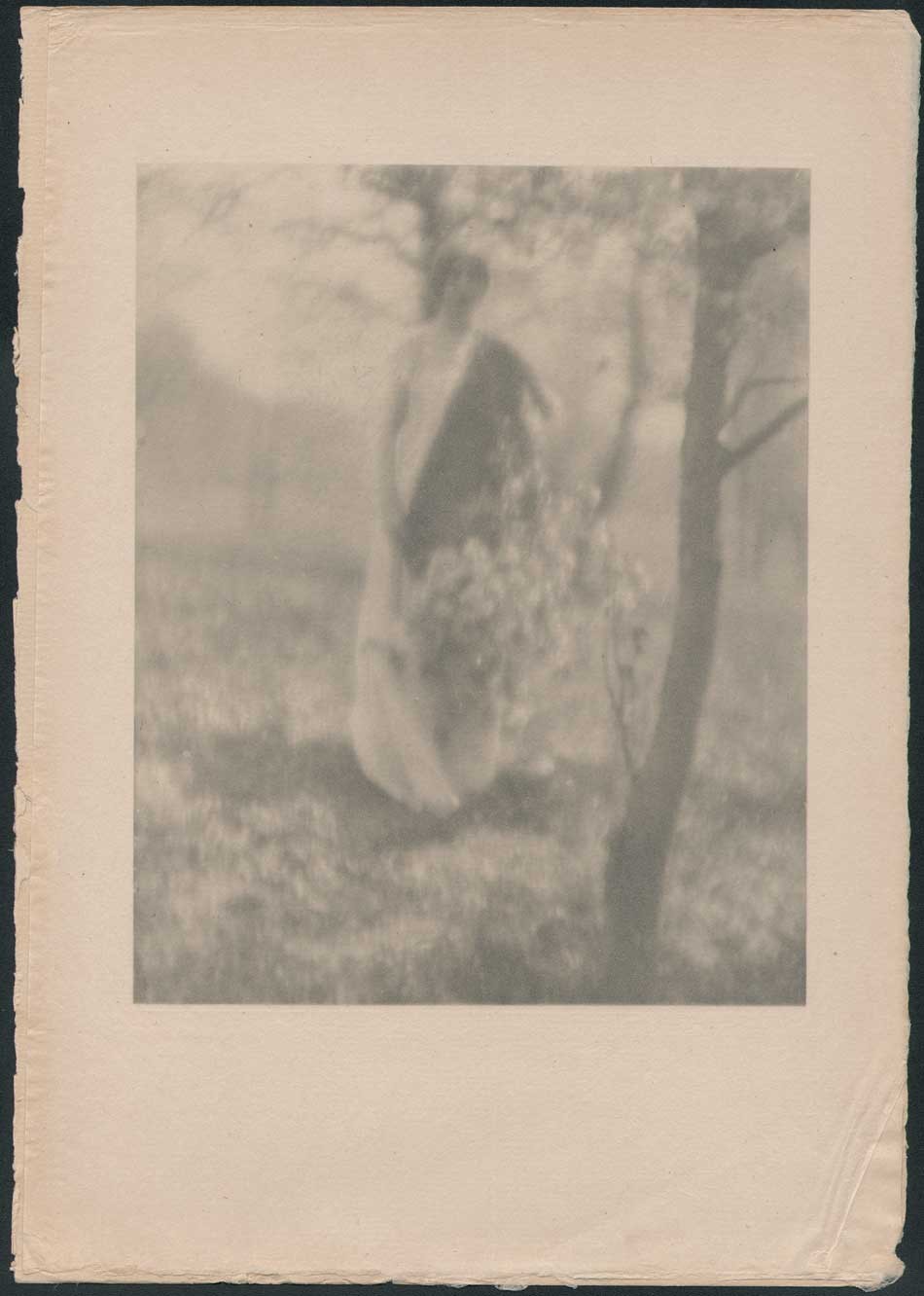 "Spring": George H. Seeley, American: hand-pulled Japan-paper tissue photogravure by the Manhattan Photogravure Co. included with Camera Work issue XXIX, January 1910: 19.7 x 15.8 | 29.7 x 20.6 cm | 30.0 x 21.0 cm- Enfield 1887 watermarked laid paper mount: A review in the February 25, 1910 issue of The British Journal of Photography discusses the ten photogravure plates by Seeley included with CW 29, and singles out this spring study with female model at the critique's conclusion: "Of the plates, the ten photogravures after photographs, by George H. Seeley, are remarkably rich examples of that idle sort of decorative toying with photography which “Camera Work" has always fostered. Mr. Seeley’s technical powers are very considerable. He is master enough to take great liberties with focussing, and does so with impunity; but the greatest enthusiast in art for art’s sake must admit that the subject-matter of Mr. Seeley's work is trivial and tiresome. "Girl with Bowl” is well designed and of exquisite quality. “Autumn" introduces a tambourine and bulrushes, with an inexplicable pose of the model. “The White Screen" shows the lady out of doors, dappled with the shadow from a tree. This is a charming study in tones. Next follow two subjects introducing an artist's palette—the first ridiculous and the next mystifying. Then comes a male nude of no attractions. “White Trees" and “Spring,” by their lightness and delicacy of tones, and the beauty of their suggestion, are, in our opinion, the best pictures of all. In the last two, the photographer’s title resources give out, and he contents himself with calling them No. 347 and No. 356. They do not suffer thereby. No. 356 is truly decorative, and shows us that Mr. Seeley has imbibed good ideas from the classics in painting."(p. 147: there is confusion as to the above numbers: a flysheet includes the pagination as plates VII (White Trees.) & VIII (Spring.): From: PhotoSeed Archive
"Spring": George H. Seeley, American: hand-pulled Japan-paper tissue photogravure by the Manhattan Photogravure Co. included with Camera Work issue XXIX, January 1910: 19.7 x 15.8 | 29.7 x 20.6 cm | 30.0 x 21.0 cm- Enfield 1887 watermarked laid paper mount: A review in the February 25, 1910 issue of The British Journal of Photography discusses the ten photogravure plates by Seeley included with CW 29, and singles out this spring study with female model at the critique's conclusion: "Of the plates, the ten photogravures after photographs, by George H. Seeley, are remarkably rich examples of that idle sort of decorative toying with photography which “Camera Work" has always fostered. Mr. Seeley’s technical powers are very considerable. He is master enough to take great liberties with focussing, and does so with impunity; but the greatest enthusiast in art for art’s sake must admit that the subject-matter of Mr. Seeley's work is trivial and tiresome. "Girl with Bowl” is well designed and of exquisite quality. “Autumn" introduces a tambourine and bulrushes, with an inexplicable pose of the model. “The White Screen" shows the lady out of doors, dappled with the shadow from a tree. This is a charming study in tones. Next follow two subjects introducing an artist's palette—the first ridiculous and the next mystifying. Then comes a male nude of no attractions. “White Trees" and “Spring,” by their lightness and delicacy of tones, and the beauty of their suggestion, are, in our opinion, the best pictures of all. In the last two, the photographer’s title resources give out, and he contents himself with calling them No. 347 and No. 356. They do not suffer thereby. No. 356 is truly decorative, and shows us that Mr. Seeley has imbibed good ideas from the classics in painting."(p. 147: there is confusion as to the above numbers: a flysheet includes the pagination as plates VII (White Trees.) & VIII (Spring.): From: PhotoSeed Archive
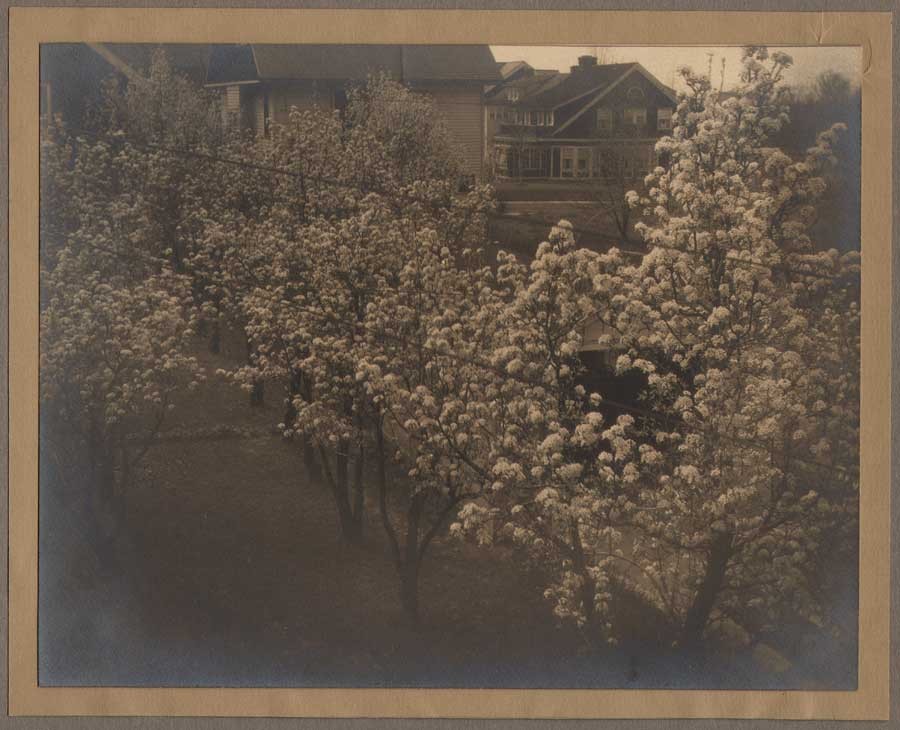 "Backyard Apple Trees Blossoming": Leo Kraft, (1885-1927) American: gelatin silver print, ca. 1915-20: 19.0 24.3 | 21.0 26.1 | 33.0 x 39.3 cm. This photograph most likely picture's the backyard area of the photographer's Lakewood, Ohio home outside Cleveland showing a double-line of flowering apple or crabapple trees. The print is believed to be printed on Kodak's P. M. C. Bromide (double weight) paper like other known examples by Kraft in this archive.: From: PhotoSeed Archive
"Backyard Apple Trees Blossoming": Leo Kraft, (1885-1927) American: gelatin silver print, ca. 1915-20: 19.0 24.3 | 21.0 26.1 | 33.0 x 39.3 cm. This photograph most likely picture's the backyard area of the photographer's Lakewood, Ohio home outside Cleveland showing a double-line of flowering apple or crabapple trees. The print is believed to be printed on Kodak's P. M. C. Bromide (double weight) paper like other known examples by Kraft in this archive.: From: PhotoSeed Archive
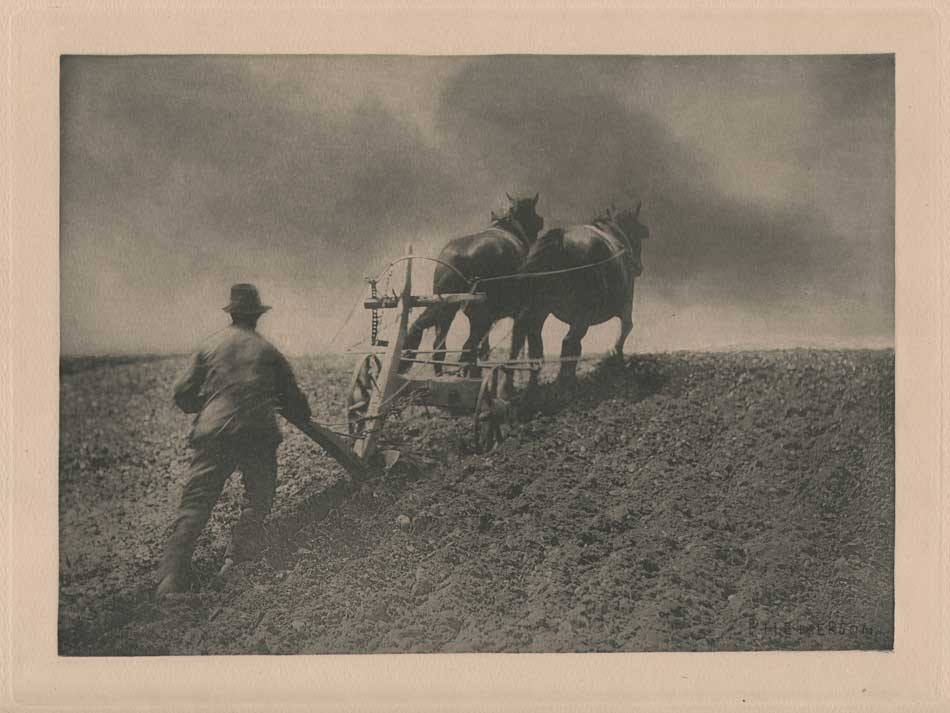 "A Stiff Pull": Peter Henry Emerson: British, born Cuba: hand-pulled photogravure by the photographer included in his limited, second-edition portfolio "Pictures of East Anglian Life": 1890: 20.7 x 28.8 | 34.1 x 42.6 cm: A farmer guides a plow behind a team of two horses as he tills the earth in the English spring countryside. England's Victoria & Albert Museum notes of this work included with this portfolio: "In 1889 Emerson published his controversial book 'Naturalistic Photography for Students of the Art' without images. 'Naturalistic Photography' examined his purist approach to photography, derived from his fascination with Naturalism in art, and attacked the prevailing artificial aesthetic in art photography. After its publication Emerson felt that his opponents had misunderstood his ideas. So, in 1890 he selected 10 plates from his book 'Pictures of East Anglian Life' (1888) that best illustrated his theories, and presented them loose in a portfolio dedicated to the ‘photographic student’, with the same title and cover of the book. He then donated copies of this portfolio to every photographic society in the country." Included in the work as plate III, "A Stiff Pull" is also reproduced as a line engraving on the oversized canvas board folio, but with the odd inclusion of the ocean with sailboats and gulls flying overhead on the horizon. From: PhotoSeed Archive
"A Stiff Pull": Peter Henry Emerson: British, born Cuba: hand-pulled photogravure by the photographer included in his limited, second-edition portfolio "Pictures of East Anglian Life": 1890: 20.7 x 28.8 | 34.1 x 42.6 cm: A farmer guides a plow behind a team of two horses as he tills the earth in the English spring countryside. England's Victoria & Albert Museum notes of this work included with this portfolio: "In 1889 Emerson published his controversial book 'Naturalistic Photography for Students of the Art' without images. 'Naturalistic Photography' examined his purist approach to photography, derived from his fascination with Naturalism in art, and attacked the prevailing artificial aesthetic in art photography. After its publication Emerson felt that his opponents had misunderstood his ideas. So, in 1890 he selected 10 plates from his book 'Pictures of East Anglian Life' (1888) that best illustrated his theories, and presented them loose in a portfolio dedicated to the ‘photographic student’, with the same title and cover of the book. He then donated copies of this portfolio to every photographic society in the country." Included in the work as plate III, "A Stiff Pull" is also reproduced as a line engraving on the oversized canvas board folio, but with the odd inclusion of the ocean with sailboats and gulls flying overhead on the horizon. From: PhotoSeed Archive
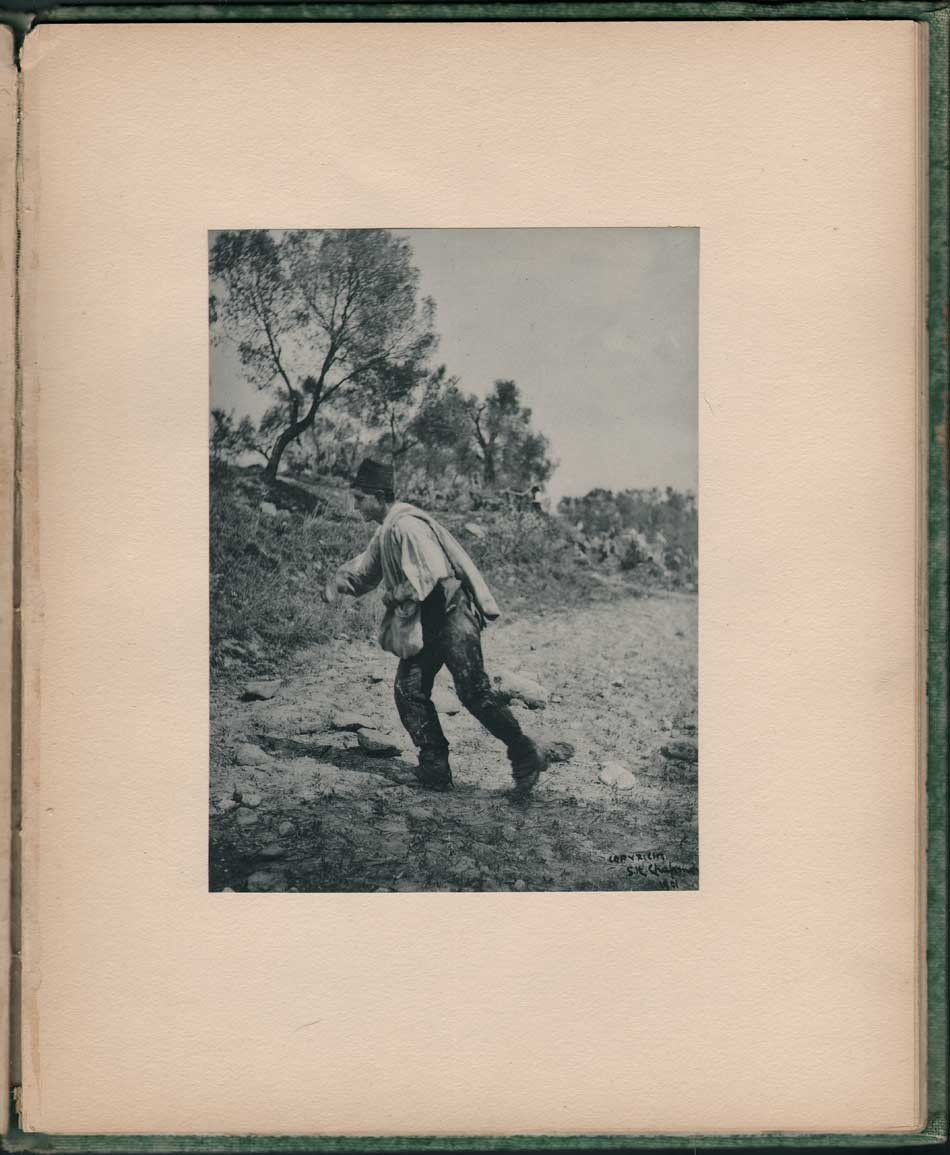 "Some fell upon Stony Places,…": Samuel Hudson Chapman, American (1857-1931): platinum print included in his self-published volume: "The Parable of the Sower, Illustrated From Life, With The Series of Pictures Awarded The Allison Silver Cup of the Photographic Society of Philadelphia For the Year 1900: S.H. & H. Chapman 1348 Pine Street, 1901: 18.8 x 13.9 corner-glued | 31.5 x 25.4 cm: A dealer in rare coins along with his brother Henry, Philadelphia resident Samuel Hudson Chapman was also an accomplished photographer and president of the Photographic Society of Philadelphia at the time he published this volume which included this photograph in 1901. Showing a farmhand sowing seeds in the springtime, most likely done in the Italian countryside, the following copy accompanies the work opposite, from the King James Version of the Bible's Book of Matthew: "Some fell upon Stony Places, where they had not much earth: and forthwith they sprung up, because they had no deepness of earth; and when the sun was up, they were scorched; and because they had no root, they withered away." From: PhotoSeed Archive
"Some fell upon Stony Places,…": Samuel Hudson Chapman, American (1857-1931): platinum print included in his self-published volume: "The Parable of the Sower, Illustrated From Life, With The Series of Pictures Awarded The Allison Silver Cup of the Photographic Society of Philadelphia For the Year 1900: S.H. & H. Chapman 1348 Pine Street, 1901: 18.8 x 13.9 corner-glued | 31.5 x 25.4 cm: A dealer in rare coins along with his brother Henry, Philadelphia resident Samuel Hudson Chapman was also an accomplished photographer and president of the Photographic Society of Philadelphia at the time he published this volume which included this photograph in 1901. Showing a farmhand sowing seeds in the springtime, most likely done in the Italian countryside, the following copy accompanies the work opposite, from the King James Version of the Bible's Book of Matthew: "Some fell upon Stony Places, where they had not much earth: and forthwith they sprung up, because they had no deepness of earth; and when the sun was up, they were scorched; and because they had no root, they withered away." From: PhotoSeed Archive
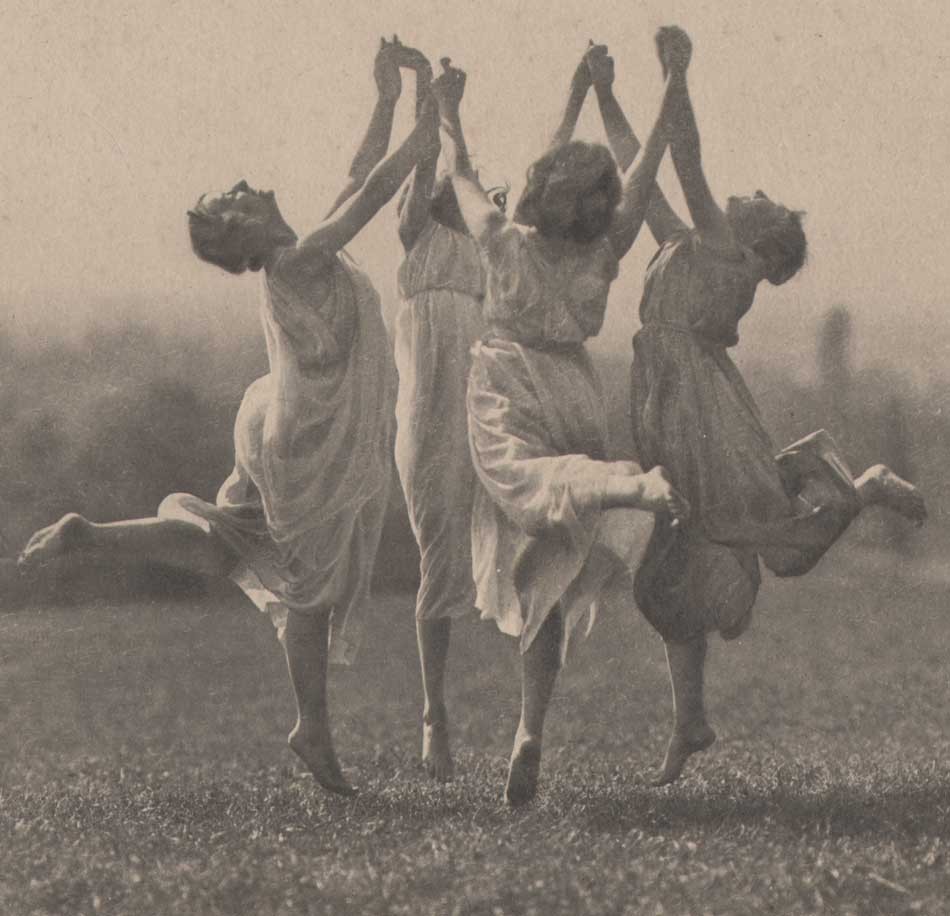 Detail: "Vers L'Idéal, Jeunes Filles Dansant : "Towards the Ideal, Young Girls Dancing" : Frederick Boissonnas, Swiss (1858-1946): hand-pulled photogravure by Munich's Verlagsanstalt F. Bruckmann A.-G. : 1911: 21.2 x 29.2 | 26.3 x 36.6 cm: Suggestive of an exuberant ritual acknowledging rebirth in spring, this photographic study of four female dancers can be dated to around 1911, when it was titled Vers L'Ideal "Towards the Ideal" and exhibited as part of the London Salon of Photography, where it was shown cropped to the central figures. These dancers were students attending a school teaching the "Dalcroze Method" of music pedagogy in Hellerau, Germany, now part of Dresden. The school was founded in 1910 by the Swiss composer, musician and music educator Émile Jaques-Dalcroze. (1865-1950) From: PhotoSeed Archive
Detail: "Vers L'Idéal, Jeunes Filles Dansant : "Towards the Ideal, Young Girls Dancing" : Frederick Boissonnas, Swiss (1858-1946): hand-pulled photogravure by Munich's Verlagsanstalt F. Bruckmann A.-G. : 1911: 21.2 x 29.2 | 26.3 x 36.6 cm: Suggestive of an exuberant ritual acknowledging rebirth in spring, this photographic study of four female dancers can be dated to around 1911, when it was titled Vers L'Ideal "Towards the Ideal" and exhibited as part of the London Salon of Photography, where it was shown cropped to the central figures. These dancers were students attending a school teaching the "Dalcroze Method" of music pedagogy in Hellerau, Germany, now part of Dresden. The school was founded in 1910 by the Swiss composer, musician and music educator Émile Jaques-Dalcroze. (1865-1950) From: PhotoSeed Archive
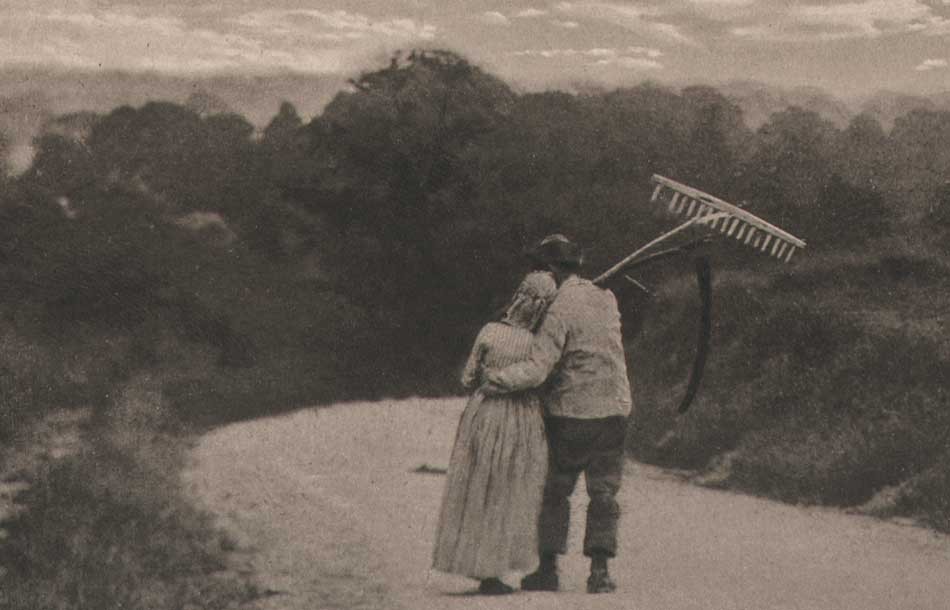 Detail: "Sweet Springtime" : Ralph Winwood-Robinson, English (1862-1942): hand-pulled, Chine-collé edition photogravure from limited-edition portfolio "Amateur-Kunst: 37 Photogravuren Nach Naturaufnahmen" (Amateur Art: 37 photo Engravings after nature Photographs) published by Richard Paulussen at Vienna's Gesellschaft für Vervielfältigende Kunst: 1891: 20.6 x 26.8 | 35.6 x 48.2 cm: Titled "Sweet Springtime", this romantic landscape genre study showing a couple walking together (please see this website for uncropped version) down a road past a windmill was taken by the son of renowned English photographer Henry Peach Robinson. It was exhibited in Vienna during the groundbreaking 1891 "Internationale Ausstellung Künstlerischer Photographien" (International Exhibition of Art Photographers) organized by the Club of Amateur Photographers in Austria (Club der Amateur Photographen in Wien) the same year.: From: PhotoSeed Archive
Detail: "Sweet Springtime" : Ralph Winwood-Robinson, English (1862-1942): hand-pulled, Chine-collé edition photogravure from limited-edition portfolio "Amateur-Kunst: 37 Photogravuren Nach Naturaufnahmen" (Amateur Art: 37 photo Engravings after nature Photographs) published by Richard Paulussen at Vienna's Gesellschaft für Vervielfältigende Kunst: 1891: 20.6 x 26.8 | 35.6 x 48.2 cm: Titled "Sweet Springtime", this romantic landscape genre study showing a couple walking together (please see this website for uncropped version) down a road past a windmill was taken by the son of renowned English photographer Henry Peach Robinson. It was exhibited in Vienna during the groundbreaking 1891 "Internationale Ausstellung Künstlerischer Photographien" (International Exhibition of Art Photographers) organized by the Club of Amateur Photographers in Austria (Club der Amateur Photographen in Wien) the same year.: From: PhotoSeed Archive
Blue Prince
Posted March 2016 in Alternate Processes, Childhood Photography, Exhibitions, History of Photography, Unknown Photographers, Unknown Photographs
Discovering a needle in a haystack, with apologies to this farmhand happily lounging atop a salt marsh haystack before the turn of the 20th century, is the proverbial sensation one beholds when encountering a fine blueprint, or cyanotype photograph, for the first time.
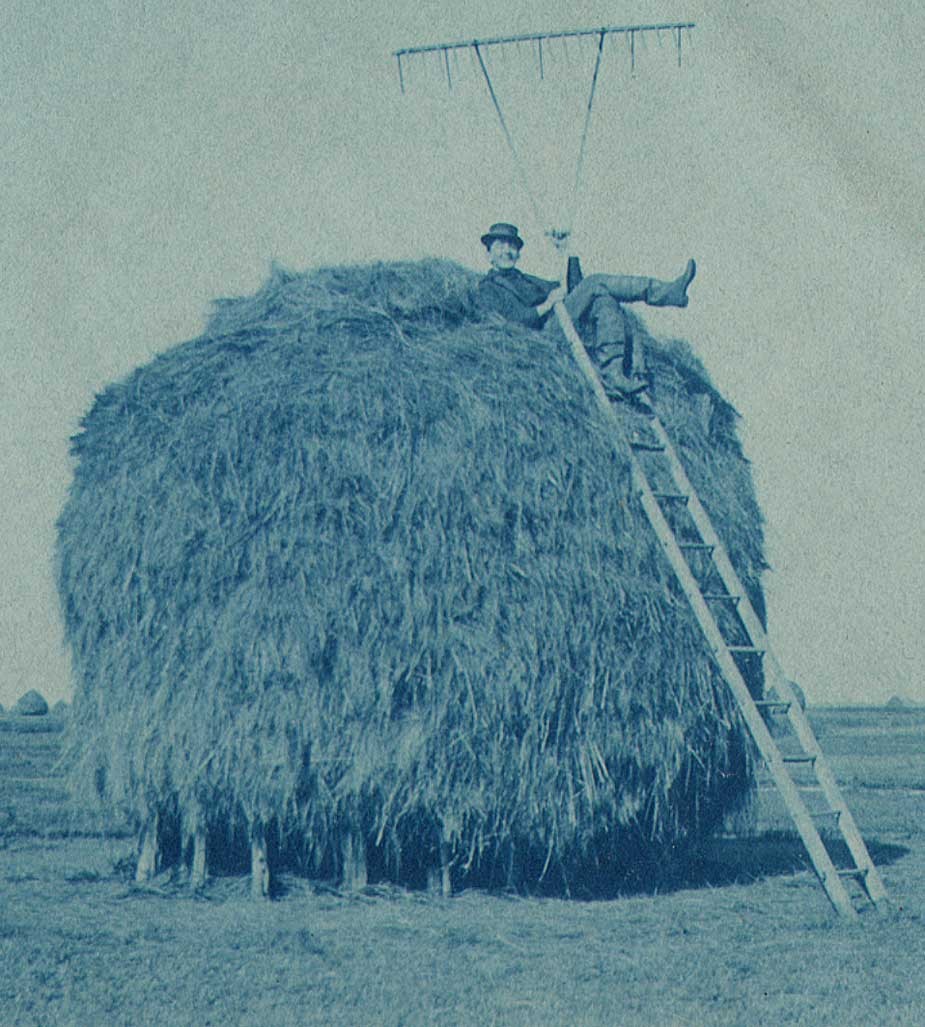 Detail: "Farmhand atop Salt Marsh Haystack" : anonymous American photographer: cyanotype: 1895-1900: 8.7 x 12.0 cm: The location of this photograph has been determined to be Plum Island in Newburyport, Mass, on Boston's North Shore. The marshes, in a tidal zone on the Atlantic ocean, is where salt marsh hay grows and then harvested. The farmhand would first use the wooden drag rake to collect the cut hay into piles. It would then be gathered and piled into layers above a platform (seen at bottom of photo) made from cedar wood staddles. This form of haystack making dates from the 17th Century is still practiced in the area in the present day. From: PhotoSeed Archive
Detail: "Farmhand atop Salt Marsh Haystack" : anonymous American photographer: cyanotype: 1895-1900: 8.7 x 12.0 cm: The location of this photograph has been determined to be Plum Island in Newburyport, Mass, on Boston's North Shore. The marshes, in a tidal zone on the Atlantic ocean, is where salt marsh hay grows and then harvested. The farmhand would first use the wooden drag rake to collect the cut hay into piles. It would then be gathered and piled into layers above a platform (seen at bottom of photo) made from cedar wood staddles. This form of haystack making dates from the 17th Century is still practiced in the area in the present day. From: PhotoSeed Archive
Given the excuse the Worcester Art Museum in Massachusetts is devoting significant wall space to their current exhibit: Cyanotypes: Photography’s Blue Period, (through April 24, 2016-publication here.) all while keeping with this institution’s admirable mission of presenting photography as an art form to the public since 1904, I’m mounting my own mini-exhibition of vintage cyanotypes from the PhotoSeed archive here with the added bonus of several photographs that literally embrace and further the definition of “blue print”. So like our “prince” above, whose raking abilities are indeed most impressive, here’s hoping your own photographic gatherings include finding the unique beauty these gems in blue offer.
-David Spencer, February, 2016
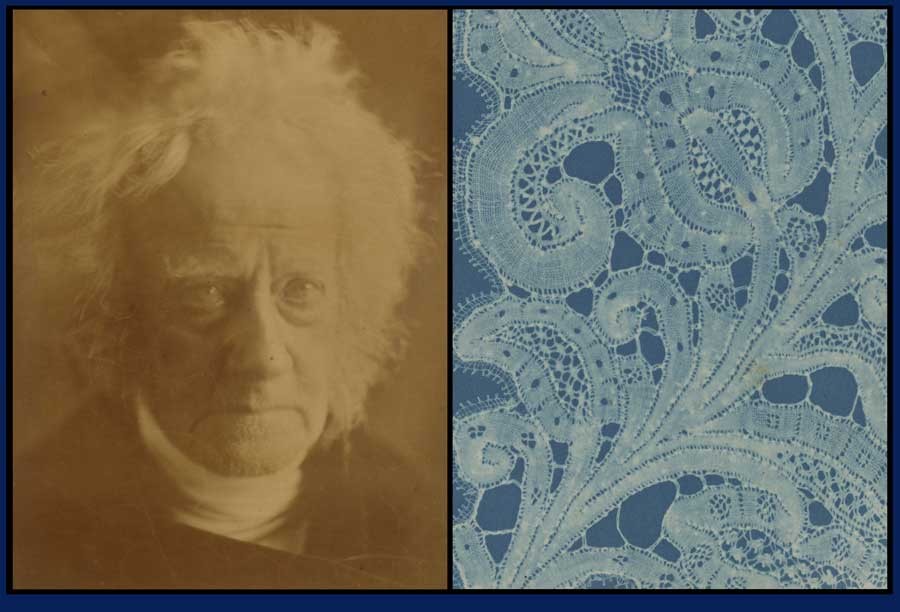 Left: Detail: "John Frederick William Herschel"(1792-1871): Julia Margaret Cameron: British: Albumen print: 1867: image: 35.5 x 27.1 cm (sight): The Cyanotype, or blueprint process, was first invented by John Herschel in 1842. It involves first exposing a negative, oftentimes through the contact print method with paper (or even cloth or another matrix) first treated with ammonium ferric citrate. In daylight, the matrix is then developed using a solution of potassium ferricyanide. The resulting print reveals itself as a brilliant blue hue known as Prussian blue. (ferric iron compounds being changed into ferrous iron). From: PhotoSeed Archive. Right: Detail: "Braid and Thread Lace": Julia Herschel: British : (1842-1933 ) : cyanotype: 1869 or before. It's intriguing to know the inventors daughter used the process herself (John Herschel was known to only use his blueprint process to reproduce notes and diagrams) to create artistic statements, like this original photograph bound with the volume: A Handbook for Greek and Roman Lace Making published in London in 1869 and printed by R. Barrett and Sons. From: Spencer Collection, The New York Public Library. "A handbook for Greek and Roman lace making" The New York Public Library Digital Collections. 1869. http://digitalcollections.nypl.org/items/7dd58e00-0898-0133-038f-58d385a7bbd0
Left: Detail: "John Frederick William Herschel"(1792-1871): Julia Margaret Cameron: British: Albumen print: 1867: image: 35.5 x 27.1 cm (sight): The Cyanotype, or blueprint process, was first invented by John Herschel in 1842. It involves first exposing a negative, oftentimes through the contact print method with paper (or even cloth or another matrix) first treated with ammonium ferric citrate. In daylight, the matrix is then developed using a solution of potassium ferricyanide. The resulting print reveals itself as a brilliant blue hue known as Prussian blue. (ferric iron compounds being changed into ferrous iron). From: PhotoSeed Archive. Right: Detail: "Braid and Thread Lace": Julia Herschel: British : (1842-1933 ) : cyanotype: 1869 or before. It's intriguing to know the inventors daughter used the process herself (John Herschel was known to only use his blueprint process to reproduce notes and diagrams) to create artistic statements, like this original photograph bound with the volume: A Handbook for Greek and Roman Lace Making published in London in 1869 and printed by R. Barrett and Sons. From: Spencer Collection, The New York Public Library. "A handbook for Greek and Roman lace making" The New York Public Library Digital Collections. 1869. http://digitalcollections.nypl.org/items/7dd58e00-0898-0133-038f-58d385a7bbd0
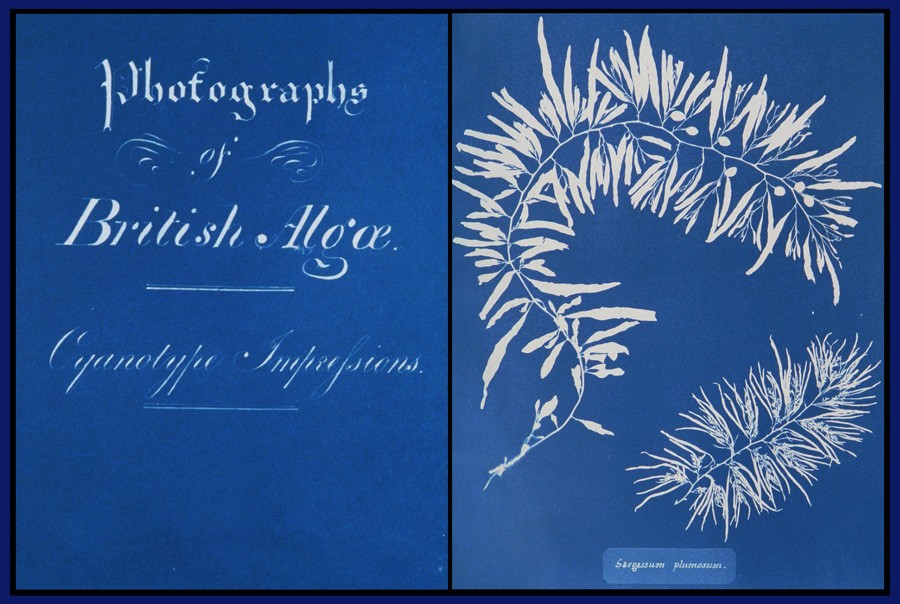 Left: Detail: "Title Page": from: Photographs of British Algae: Cyanotype Impressions: Anna Atkins: British: (1799-1871) : cyanotype: 1843-1853. This title page in the author's own hand is part of a multi-part volume of 231 original cyanotypes featuring contact prints of British seaweed specimens first copied on individual glass sheets by William Henry Fox Talbot's photogenic drawing method by Atkins and then reproduced by John Herschel's newly invented cyanotype or blueprinting process. The importance of the work is summed up by The New York Public Library, which owns this rare volume formerly in the library of Herschel: "Photographs of British Algae is a landmark in the histories both of photography and of publishing: the first photographic work by a woman, and the first book produced entirely by photographic means." From: Spencer Collection, The New York Public Library. "Titlepage." The New York Public Library Digital Collections. 1843 - 1853. http://digitalcollections.nypl.org/items/510d47d9-4af4-a3d9-e040-e00a18064a99. Right: Detail: "Sargassum plumosum":from: Photographs of British Algae: Cyanotype Impressions: Anna Atkins: British: (1799-1871) : cyanotype: 1843-1853. These beautiful seaweed specimens was the second plate in the pagination for Vol. 1 of "British Algae". From: Spencer Collection, The New York Public Library. "Sargassum plumosum." The New York Public Library Digital Collections. 1843 - 1853. http://digitalcollections.nypl.org/items/510d47d9-4af6-a3d9-e040-e00a18064a99
Left: Detail: "Title Page": from: Photographs of British Algae: Cyanotype Impressions: Anna Atkins: British: (1799-1871) : cyanotype: 1843-1853. This title page in the author's own hand is part of a multi-part volume of 231 original cyanotypes featuring contact prints of British seaweed specimens first copied on individual glass sheets by William Henry Fox Talbot's photogenic drawing method by Atkins and then reproduced by John Herschel's newly invented cyanotype or blueprinting process. The importance of the work is summed up by The New York Public Library, which owns this rare volume formerly in the library of Herschel: "Photographs of British Algae is a landmark in the histories both of photography and of publishing: the first photographic work by a woman, and the first book produced entirely by photographic means." From: Spencer Collection, The New York Public Library. "Titlepage." The New York Public Library Digital Collections. 1843 - 1853. http://digitalcollections.nypl.org/items/510d47d9-4af4-a3d9-e040-e00a18064a99. Right: Detail: "Sargassum plumosum":from: Photographs of British Algae: Cyanotype Impressions: Anna Atkins: British: (1799-1871) : cyanotype: 1843-1853. These beautiful seaweed specimens was the second plate in the pagination for Vol. 1 of "British Algae". From: Spencer Collection, The New York Public Library. "Sargassum plumosum." The New York Public Library Digital Collections. 1843 - 1853. http://digitalcollections.nypl.org/items/510d47d9-4af6-a3d9-e040-e00a18064a99
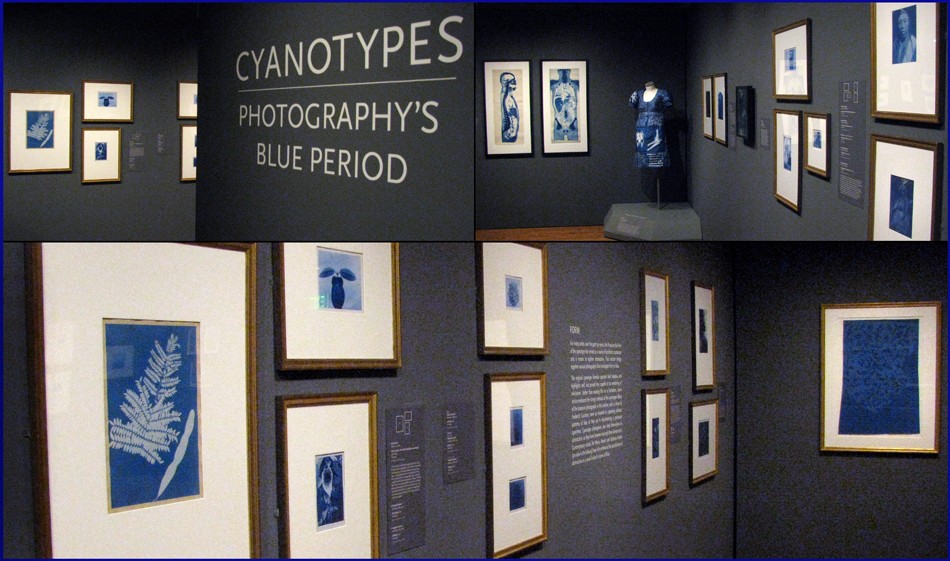 Composite: April, 2016 installation photographs from exhibit: "Cyanotypes: Photography's Blue Period" at the Worcester Art Museum in Worcester, MA. Running from January 16-April 24, 2016, the show was the first comprehensive exhibit on the medium of cyanotype ever held in the United States. Vintage examples from the museum's own holdings as well as loans from other institutions and private individuals spanned the period from the 1850's to the first decade of the 21st Century. The exhibit was curated by Nancy Kathryn Burns, Assistant Curator of Prints, Drawings, and Photographs at the museum & Kristina Wilson, Associate Professor of Art History, Clark University. Both additionally edited the volume: "Cyanotypes: Photography's Blue Period" published by the museum: ISBN# 978-0-936042-06-0. Installation photographs by David Spencer for PhotoSeed Archive
Composite: April, 2016 installation photographs from exhibit: "Cyanotypes: Photography's Blue Period" at the Worcester Art Museum in Worcester, MA. Running from January 16-April 24, 2016, the show was the first comprehensive exhibit on the medium of cyanotype ever held in the United States. Vintage examples from the museum's own holdings as well as loans from other institutions and private individuals spanned the period from the 1850's to the first decade of the 21st Century. The exhibit was curated by Nancy Kathryn Burns, Assistant Curator of Prints, Drawings, and Photographs at the museum & Kristina Wilson, Associate Professor of Art History, Clark University. Both additionally edited the volume: "Cyanotypes: Photography's Blue Period" published by the museum: ISBN# 978-0-936042-06-0. Installation photographs by David Spencer for PhotoSeed Archive
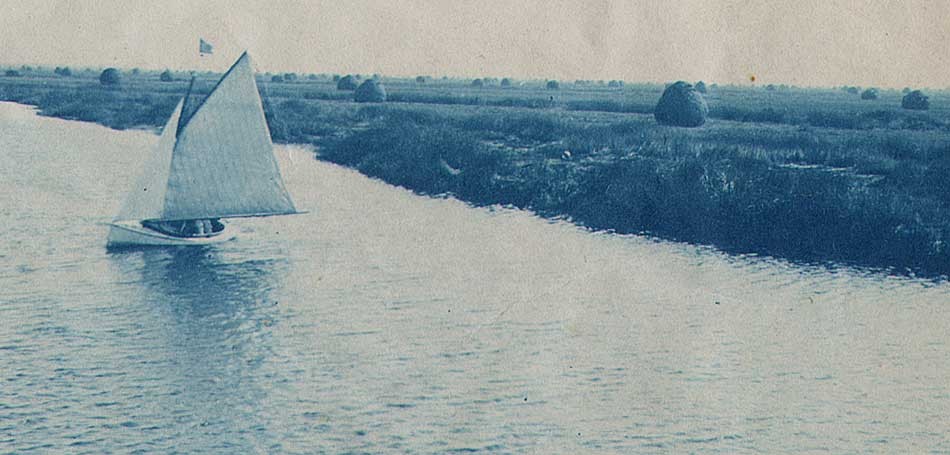 Detail: "Sailboat near Plum Island" : anonymous American photographer: cyanotype: 1895-1900: 9.2 x 12.5 cm: The location of this photograph has been determined to be Plum Island Sound (the Parker River) in Newburyport, Mass, on Boston's North Shore. In the distance can be seen many salt marsh haystacks. From: PhotoSeed Archive
Detail: "Sailboat near Plum Island" : anonymous American photographer: cyanotype: 1895-1900: 9.2 x 12.5 cm: The location of this photograph has been determined to be Plum Island Sound (the Parker River) in Newburyport, Mass, on Boston's North Shore. In the distance can be seen many salt marsh haystacks. From: PhotoSeed Archive
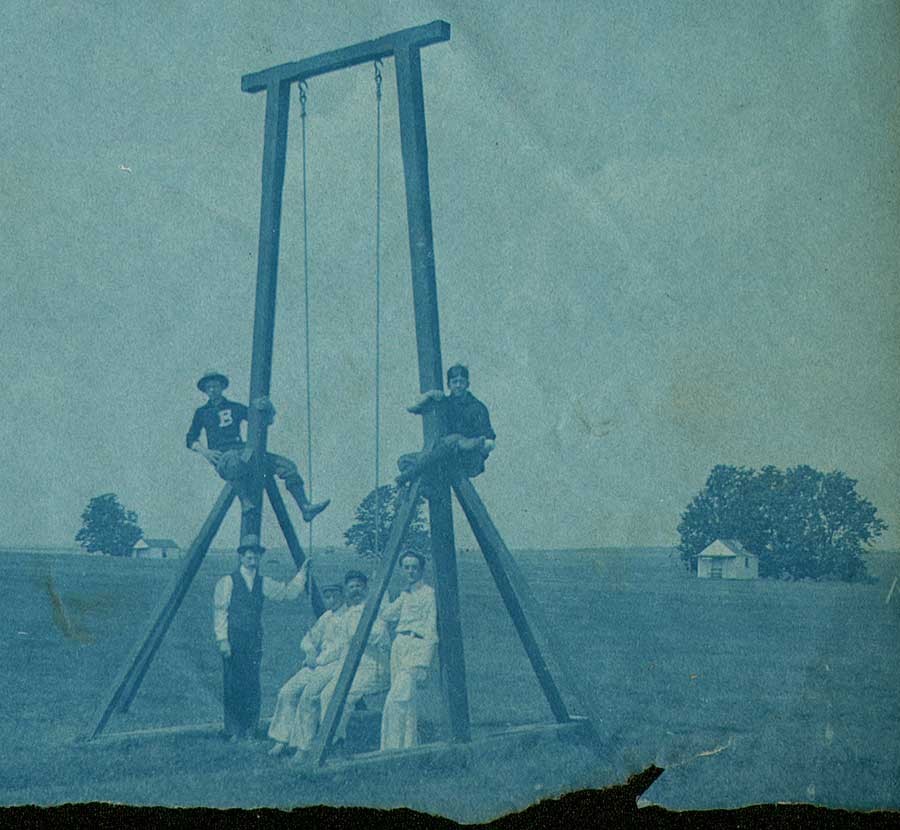 Detail: "Portrait Grouping with Tall Wooden Swing" : anonymous American photographer: cyanotype: 1895-1900: 8.5 x 11.5 cm: Most likely taken within the Plum Island area of Newburyport, Mass., (by the same photographer as it was included in small album of views as previous post photographs) this intriguing photograph shows an oversized wooden swing within a mowed field. One theory for the size of this swing would be because tidal changes could submerge the structure. Note lower margin of photograph where it was torn to fit a pre-cut window within a small album. From: PhotoSeed Archive
Detail: "Portrait Grouping with Tall Wooden Swing" : anonymous American photographer: cyanotype: 1895-1900: 8.5 x 11.5 cm: Most likely taken within the Plum Island area of Newburyport, Mass., (by the same photographer as it was included in small album of views as previous post photographs) this intriguing photograph shows an oversized wooden swing within a mowed field. One theory for the size of this swing would be because tidal changes could submerge the structure. Note lower margin of photograph where it was torn to fit a pre-cut window within a small album. From: PhotoSeed Archive
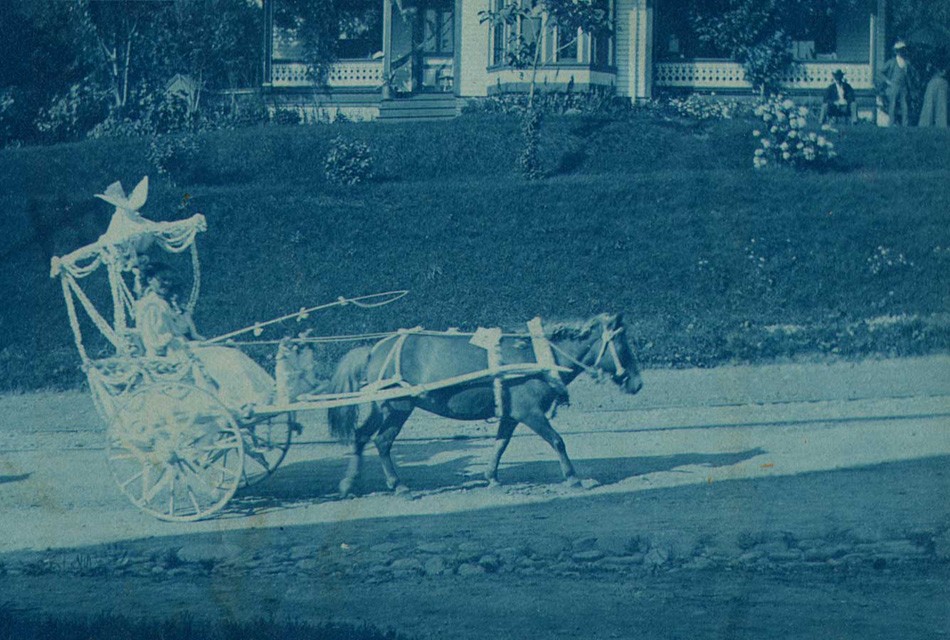 Detail: "Pony Cart in Parade" : anonymous American photographer: cyanotype: 1895-1900: 8.8 x 11.4 cm: Most likely taken in or near Newburyport, Mass., (by the same photographer as it was included in small album of views as previous post photographs) this slice of small-town American life shows a pony pulling a floral-decorated cart guided by a young lady traveling down a dirt road, perhaps on Memorial Day. Above can be seen a Victorian home with three parade watchers who stand at upper right. A set of trolley tracks can be seen in road beyond horse. From: PhotoSeed Archive
Detail: "Pony Cart in Parade" : anonymous American photographer: cyanotype: 1895-1900: 8.8 x 11.4 cm: Most likely taken in or near Newburyport, Mass., (by the same photographer as it was included in small album of views as previous post photographs) this slice of small-town American life shows a pony pulling a floral-decorated cart guided by a young lady traveling down a dirt road, perhaps on Memorial Day. Above can be seen a Victorian home with three parade watchers who stand at upper right. A set of trolley tracks can be seen in road beyond horse. From: PhotoSeed Archive
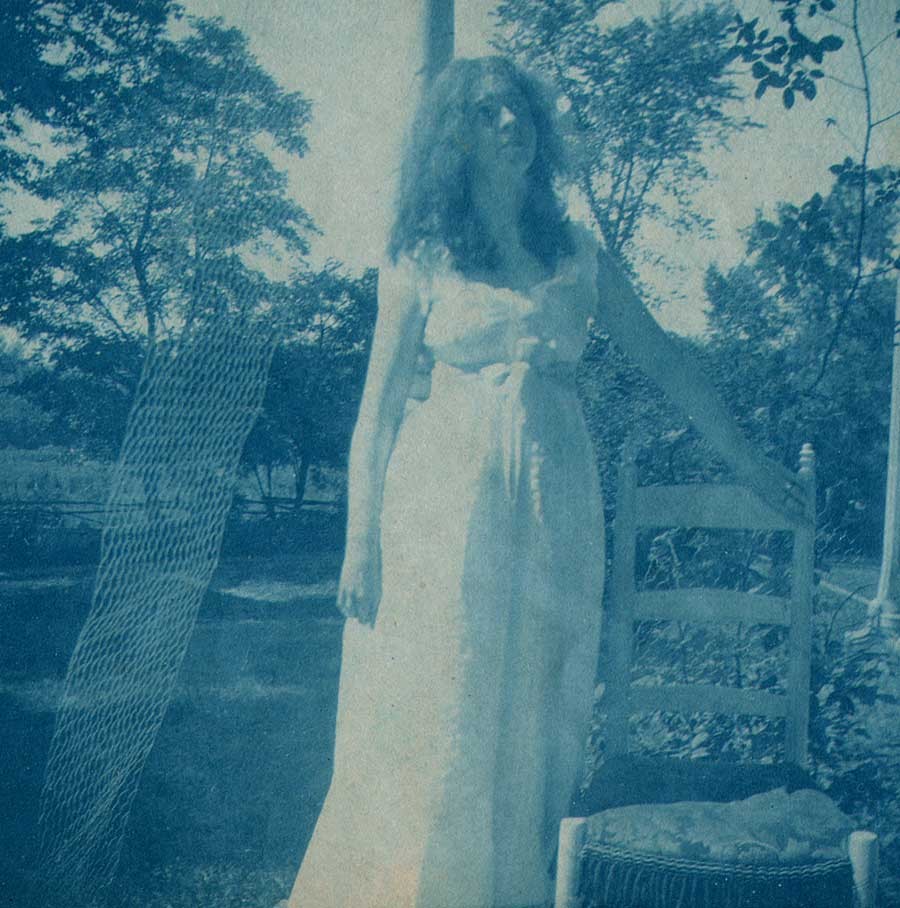 Detail: "Woman in White Dress Standing next to Chair" : anonymous American photographer: cyanotype: 1895-1900: 8.3 x 8.5 cm: Her name perhaps lost to history, a young woman wearing a white dress stands on a porch and looks away from the camera: a most unusual genre pose indicating she may have been playing a role of some type: for a play? or as an honored guest who had taken part in the parade depicted in the previous photograph? This view also likely taken in or near Newburyport, Mass. (and was included in the same small album of views as previous post photographs) From: PhotoSeed Archive
Detail: "Woman in White Dress Standing next to Chair" : anonymous American photographer: cyanotype: 1895-1900: 8.3 x 8.5 cm: Her name perhaps lost to history, a young woman wearing a white dress stands on a porch and looks away from the camera: a most unusual genre pose indicating she may have been playing a role of some type: for a play? or as an honored guest who had taken part in the parade depicted in the previous photograph? This view also likely taken in or near Newburyport, Mass. (and was included in the same small album of views as previous post photographs) From: PhotoSeed Archive
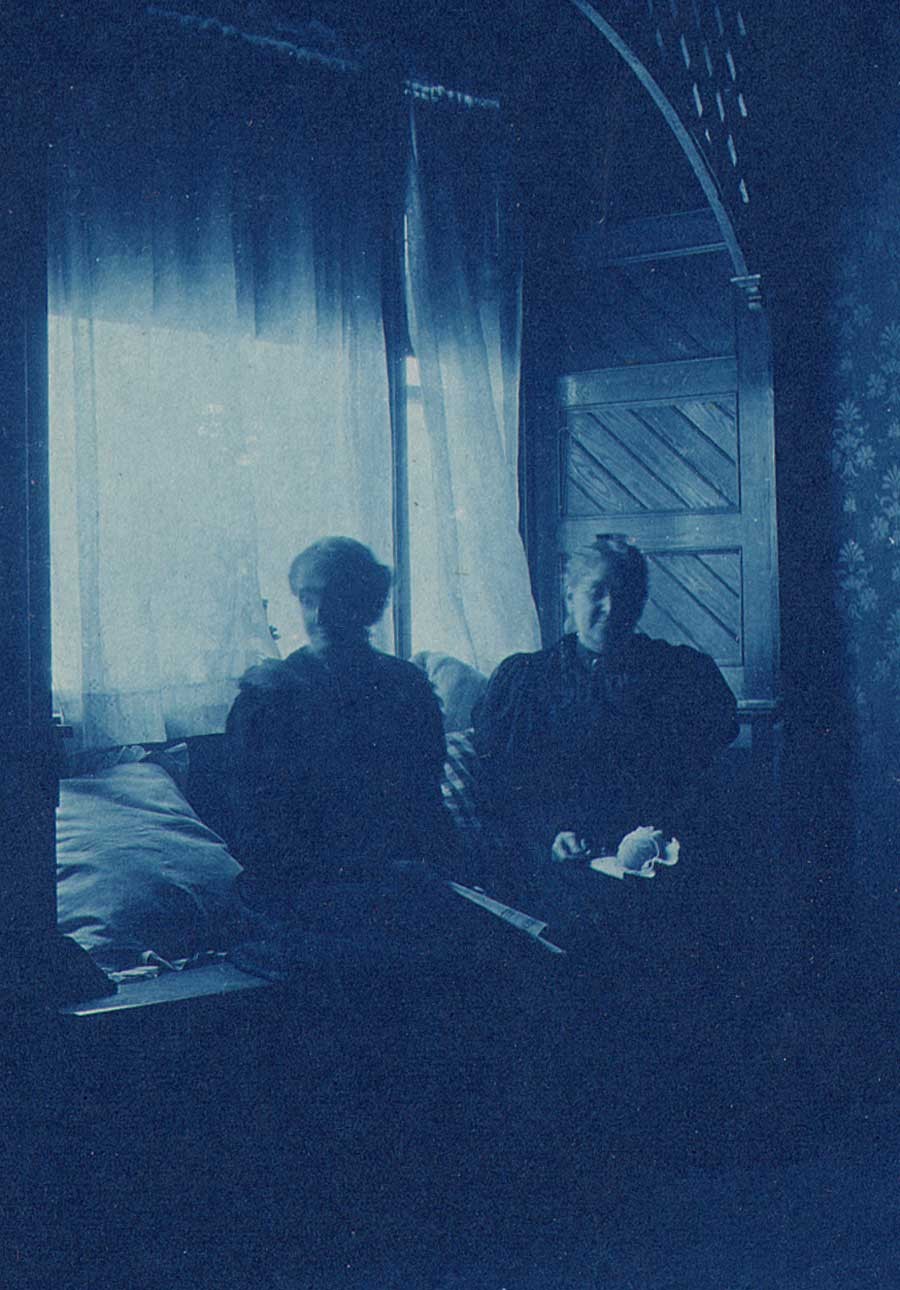 Detail: "Portrait Study near Window" : anonymous American photographer: cyanotype: 1899: 9.7 x 6.3 cm: Most likely sisters, this moody interior portrait is unusual for amateur work of the period because the photographer instructed his subjects to avert their gaze to the camera. The woman at left holds what is believed to be a folded fan while her companion holds a ball of yarn in her lap. Photograph may have been additionally printed on commercially available presensitized Venus paper manufactured by the Peerless Blue Print Co., as it was included in a cardboard box of this brand with an expiration date of 1899. Location for this image may have been the midwestern United States, as it was included in this Peerless box of loose cyanotypes purchased from an Indiana seller. From: PhotoSeed Archive
Detail: "Portrait Study near Window" : anonymous American photographer: cyanotype: 1899: 9.7 x 6.3 cm: Most likely sisters, this moody interior portrait is unusual for amateur work of the period because the photographer instructed his subjects to avert their gaze to the camera. The woman at left holds what is believed to be a folded fan while her companion holds a ball of yarn in her lap. Photograph may have been additionally printed on commercially available presensitized Venus paper manufactured by the Peerless Blue Print Co., as it was included in a cardboard box of this brand with an expiration date of 1899. Location for this image may have been the midwestern United States, as it was included in this Peerless box of loose cyanotypes purchased from an Indiana seller. From: PhotoSeed Archive
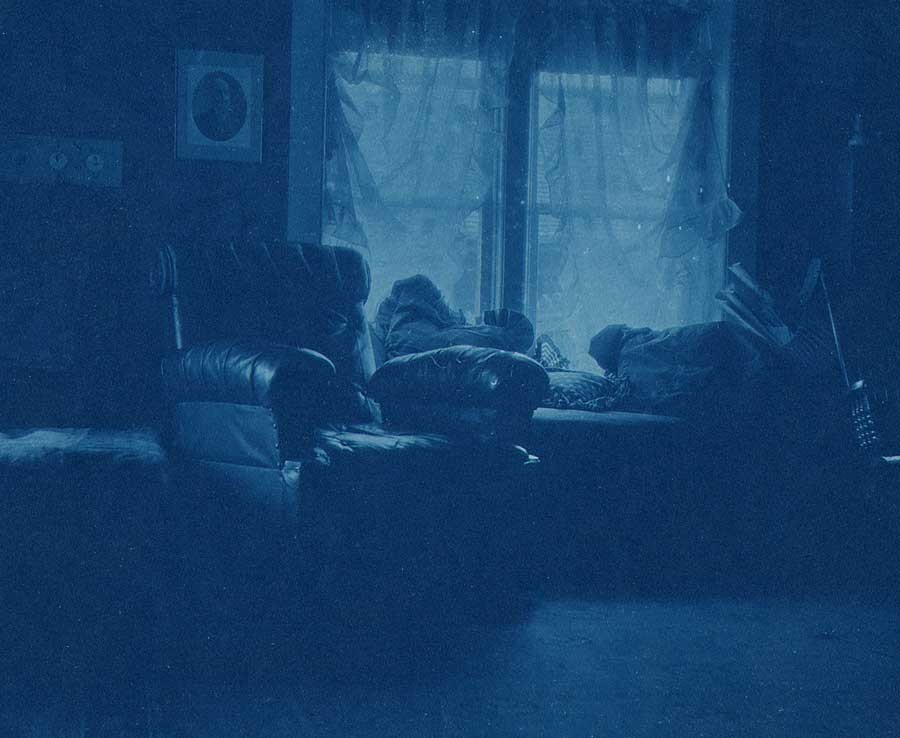 Detail: "Favorite Chair near Window" : anonymous American photographer: cyanotype: 1899: 9.4 x 12.0 cm: Another moody interior portrait, this time absent of any human subjects, is nonetheless interesting due to the feeling it evokes with the framed portrait of the bearded gentleman on the wall above what might be or was his favorite living room cushioned chair. Photograph may have been additionally printed on commercially available presensitized Venus paper manufactured by the Peerless Blue Print Co., as it was included in a cardboard box of this brand with an expiration date of 1899. Location for this image may have been the midwestern United States, as it was included in this Peerless box of loose cyanotypes purchased from an Indiana seller. From: PhotoSeed Archive
Detail: "Favorite Chair near Window" : anonymous American photographer: cyanotype: 1899: 9.4 x 12.0 cm: Another moody interior portrait, this time absent of any human subjects, is nonetheless interesting due to the feeling it evokes with the framed portrait of the bearded gentleman on the wall above what might be or was his favorite living room cushioned chair. Photograph may have been additionally printed on commercially available presensitized Venus paper manufactured by the Peerless Blue Print Co., as it was included in a cardboard box of this brand with an expiration date of 1899. Location for this image may have been the midwestern United States, as it was included in this Peerless box of loose cyanotypes purchased from an Indiana seller. From: PhotoSeed Archive
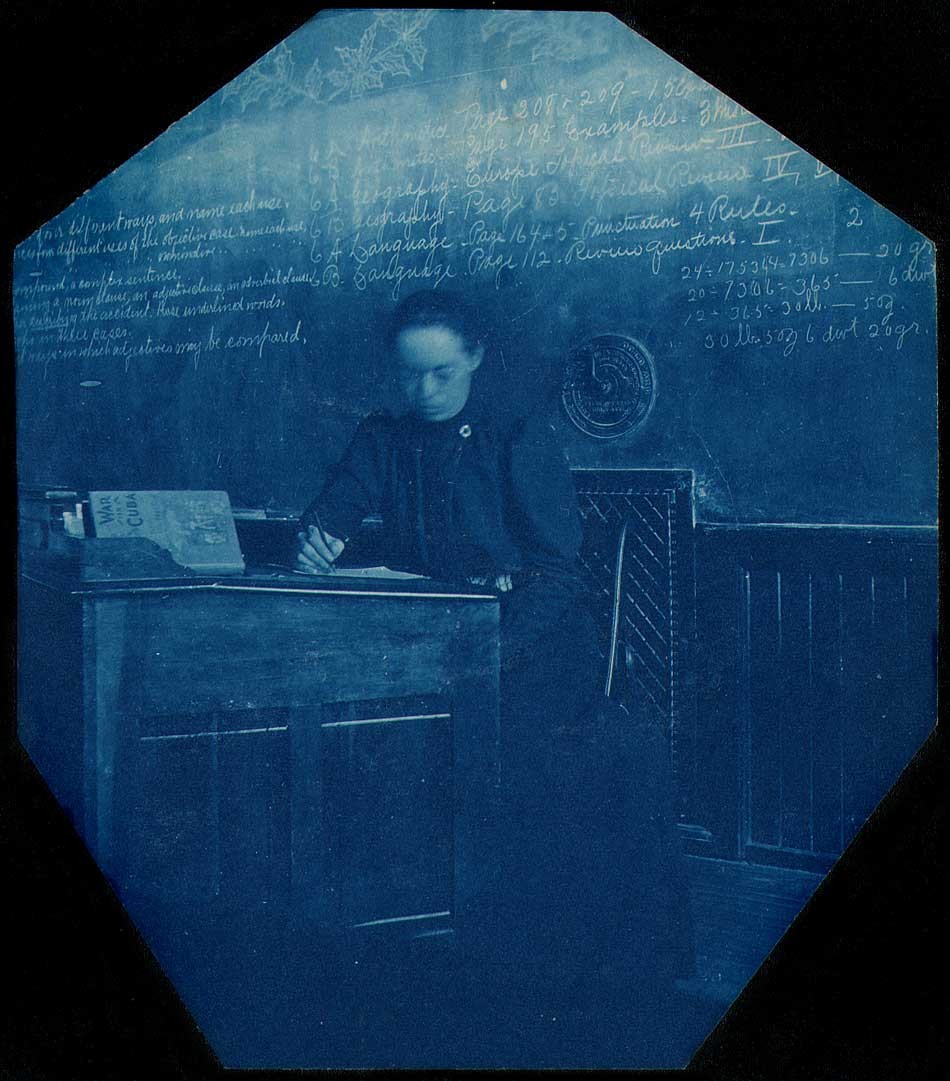 "Schoolteacher at Desk" : anonymous American photographer: cyanotype: 1899 or before: 10.5 x 9.1 cm: With slight motion blur seen in her face, a schoolteacher holding a pencil works on papers at her desk in front of a large blackboard listing student lesson plans including Arithmetic, Geography (Europe topical review) and Language, (Punctuation-4 rules) with additional lesson plans at left outlining sentence structures. The 1896 volume: The War in Cuba, Being a Full Account of Her Great Struggle for Freedom can be seen on the desk at left. A chalk drawing of holly leaves is at very top of blackboard, so view may date to the Christmas holiday of 1898. Photograph may have been additionally printed on commercially available presensitized Venus paper manufactured by the Peerless Blue Print Co., as it was included in a cardboard box of this brand with an expiration date of 1899. Location may have been the midwestern U.S., as it was purchased with other cyanotypes from an Indiana seller. From: PhotoSeed Archive
"Schoolteacher at Desk" : anonymous American photographer: cyanotype: 1899 or before: 10.5 x 9.1 cm: With slight motion blur seen in her face, a schoolteacher holding a pencil works on papers at her desk in front of a large blackboard listing student lesson plans including Arithmetic, Geography (Europe topical review) and Language, (Punctuation-4 rules) with additional lesson plans at left outlining sentence structures. The 1896 volume: The War in Cuba, Being a Full Account of Her Great Struggle for Freedom can be seen on the desk at left. A chalk drawing of holly leaves is at very top of blackboard, so view may date to the Christmas holiday of 1898. Photograph may have been additionally printed on commercially available presensitized Venus paper manufactured by the Peerless Blue Print Co., as it was included in a cardboard box of this brand with an expiration date of 1899. Location may have been the midwestern U.S., as it was purchased with other cyanotypes from an Indiana seller. From: PhotoSeed Archive
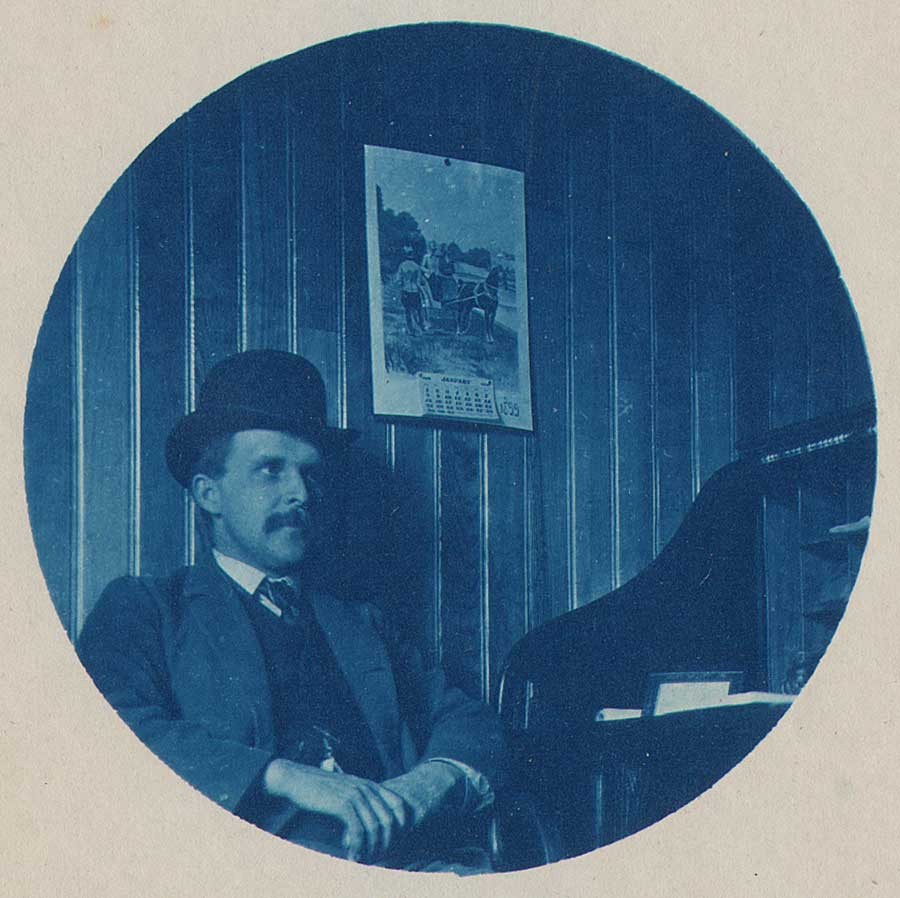 "Man with Bowler hat at Desk": : anonymous American photographer: cyanotype: 1899: 6.5 cm round | 11.3 x 8.8 cm: Possibly a self-portrait, a man wearing a bowler hat seated next to a desk stares away from the camera. A calendar featuring artwork of a horse preparing to pull a two-wheel cart dated January, 1899 hangs on the wall. Photograph may have been additionally printed on commercially available presensitized Venus paper manufactured by the Peerless Blue Print Co., as it was included in a cardboard box of this brand with an expiration date of 1899. Location may have been the midwestern U.S., as it was purchased with other cyanotypes from an Indiana seller. From: PhotoSeed Archive
"Man with Bowler hat at Desk": : anonymous American photographer: cyanotype: 1899: 6.5 cm round | 11.3 x 8.8 cm: Possibly a self-portrait, a man wearing a bowler hat seated next to a desk stares away from the camera. A calendar featuring artwork of a horse preparing to pull a two-wheel cart dated January, 1899 hangs on the wall. Photograph may have been additionally printed on commercially available presensitized Venus paper manufactured by the Peerless Blue Print Co., as it was included in a cardboard box of this brand with an expiration date of 1899. Location may have been the midwestern U.S., as it was purchased with other cyanotypes from an Indiana seller. From: PhotoSeed Archive
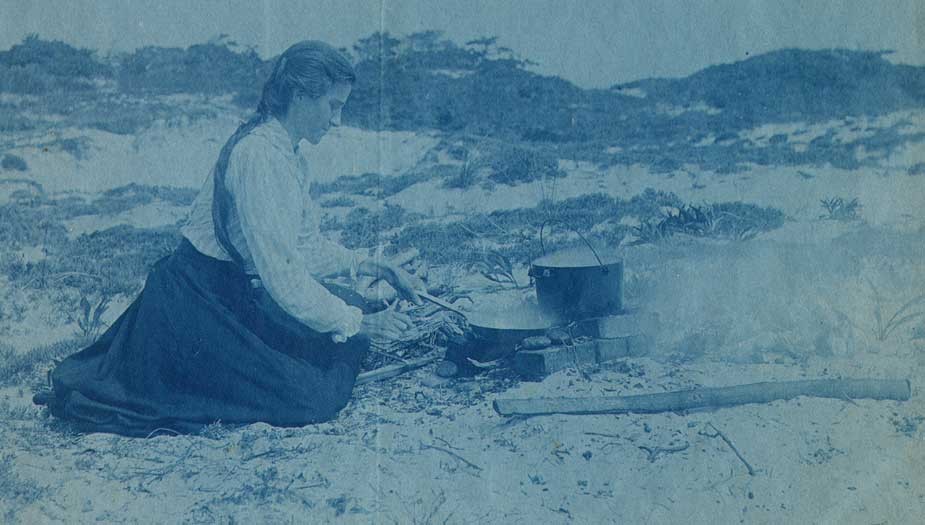 Detail: "Mother cooks at Point O' Woods LI": Charles Rollins Tucker: American: cyanotype: 1899: 12.5 x 17.3 cm: Mary (Carruthers) Tucker,(1870-1940) the spouse of amateur photographer C.R. Tucker, cooks on the beach at Point O'Woods. Wikipedia states this private retreat-even today- may have been the first settlement on Fire Island in Long Island Sound, and was originally organized in 1894 for religious retreats, some from the Chautauqua assemblies before ownership passed to the present-day Point O' Woods Association in 1898 after the first group went bankrupt. From: PhotoSeed Archive
Detail: "Mother cooks at Point O' Woods LI": Charles Rollins Tucker: American: cyanotype: 1899: 12.5 x 17.3 cm: Mary (Carruthers) Tucker,(1870-1940) the spouse of amateur photographer C.R. Tucker, cooks on the beach at Point O'Woods. Wikipedia states this private retreat-even today- may have been the first settlement on Fire Island in Long Island Sound, and was originally organized in 1894 for religious retreats, some from the Chautauqua assemblies before ownership passed to the present-day Point O' Woods Association in 1898 after the first group went bankrupt. From: PhotoSeed Archive
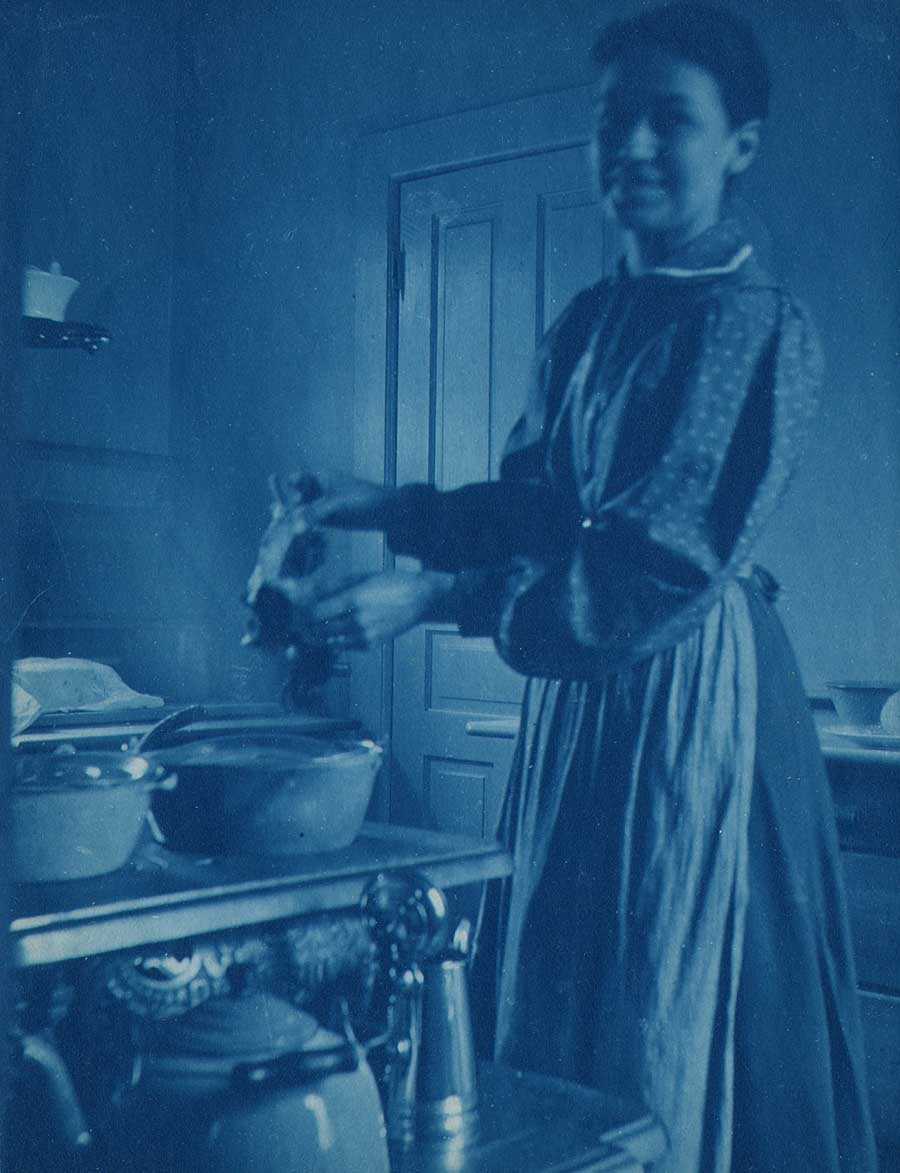 "Woman working in Kitchen" : anonymous American photographer: cyanotype: 1899: 11.9 x 9.2 cm: Wearing an apron and looking towards the camera, a woman prepares to place some type of food into a pot on a shelf above a stove while working in a home kitchen. Photograph may have been additionally printed on commercially available presensitized Venus paper manufactured by the Peerless Blue Print Co., as it was included in a cardboard box of this brand with an expiration date of 1899. Location may have been the midwestern U.S., as it was purchased with other cyanotypes from an Indiana seller. From: PhotoSeed Archive
"Woman working in Kitchen" : anonymous American photographer: cyanotype: 1899: 11.9 x 9.2 cm: Wearing an apron and looking towards the camera, a woman prepares to place some type of food into a pot on a shelf above a stove while working in a home kitchen. Photograph may have been additionally printed on commercially available presensitized Venus paper manufactured by the Peerless Blue Print Co., as it was included in a cardboard box of this brand with an expiration date of 1899. Location may have been the midwestern U.S., as it was purchased with other cyanotypes from an Indiana seller. From: PhotoSeed Archive
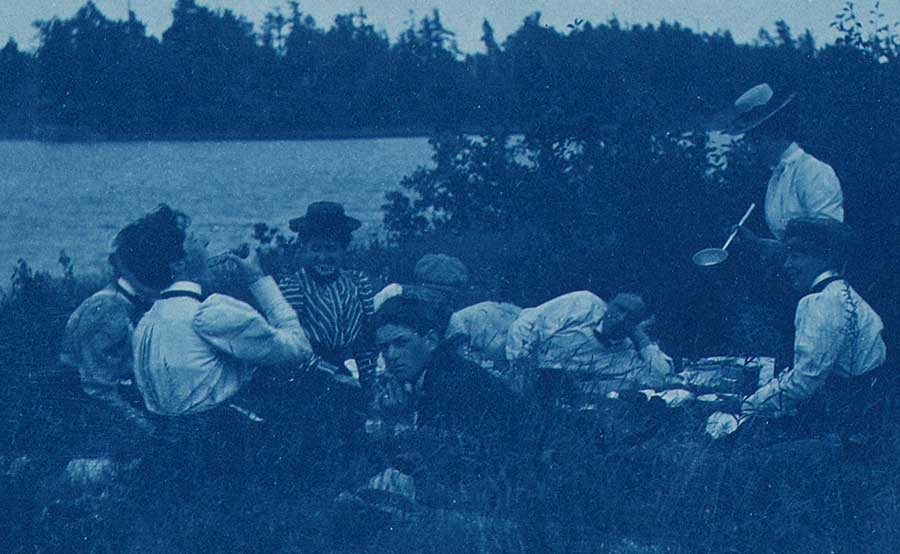 Detail: "Picnickers enjoy a Meal": anonymous American photographer: cyanotype: 1899: 8.0 x 10.6 | 9.9 x 12.5 cm: A party of seven fashionably-dressed men and women enjoy a picnic outing next to a lake. Photograph may have been additionally printed on commercially available presensitized Venus paper manufactured by the Peerless Blue Print Co., as it was included in a cardboard box of this brand with an expiration date of 1899. Location may have been the midwestern U.S., as it was purchased with other cyanotypes from an Indiana seller. From: PhotoSeed Archive
Detail: "Picnickers enjoy a Meal": anonymous American photographer: cyanotype: 1899: 8.0 x 10.6 | 9.9 x 12.5 cm: A party of seven fashionably-dressed men and women enjoy a picnic outing next to a lake. Photograph may have been additionally printed on commercially available presensitized Venus paper manufactured by the Peerless Blue Print Co., as it was included in a cardboard box of this brand with an expiration date of 1899. Location may have been the midwestern U.S., as it was purchased with other cyanotypes from an Indiana seller. From: PhotoSeed Archive
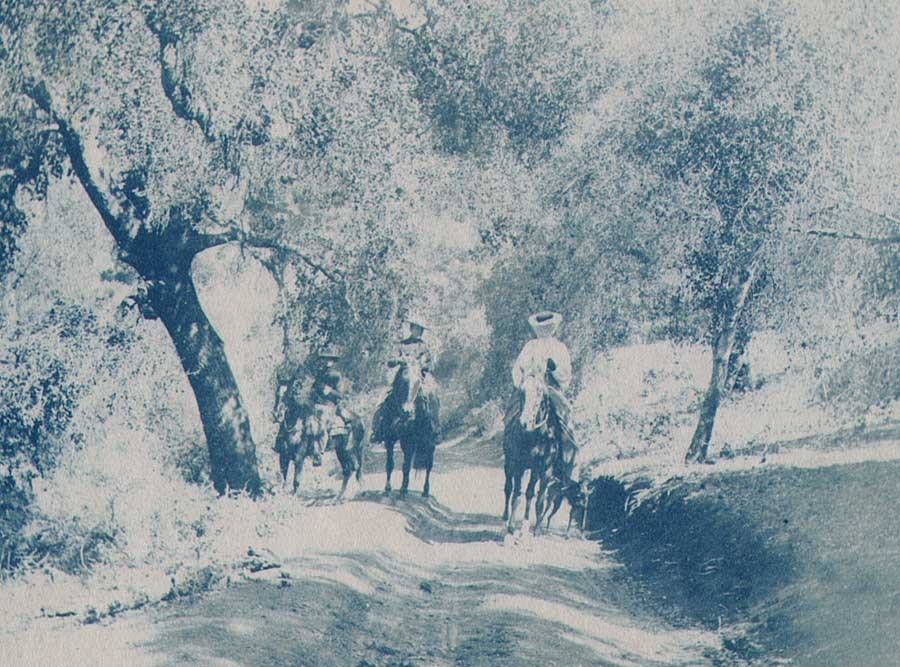 Detail: "Horseback Trail Ride": anonymous American photographer: cyanotype: 1899: 9.0 x 11.2 cm: Two men on horseback, who appear to be in military uniform at left, and a woman rider wearing mosquito netting over her hat and accompanied by a canine Whippet, stop for a moment in sunlight on a rural forest riding trail. Photograph may have been additionally printed on commercially available presensitized Venus paper manufactured by the Peerless Blue Print Co., as it was included in a cardboard box of this brand with an expiration date of 1899. Location may have been the midwestern U.S., as it was purchased with other cyanotypes from an Indiana seller. From: PhotoSeed Archive
Detail: "Horseback Trail Ride": anonymous American photographer: cyanotype: 1899: 9.0 x 11.2 cm: Two men on horseback, who appear to be in military uniform at left, and a woman rider wearing mosquito netting over her hat and accompanied by a canine Whippet, stop for a moment in sunlight on a rural forest riding trail. Photograph may have been additionally printed on commercially available presensitized Venus paper manufactured by the Peerless Blue Print Co., as it was included in a cardboard box of this brand with an expiration date of 1899. Location may have been the midwestern U.S., as it was purchased with other cyanotypes from an Indiana seller. From: PhotoSeed Archive
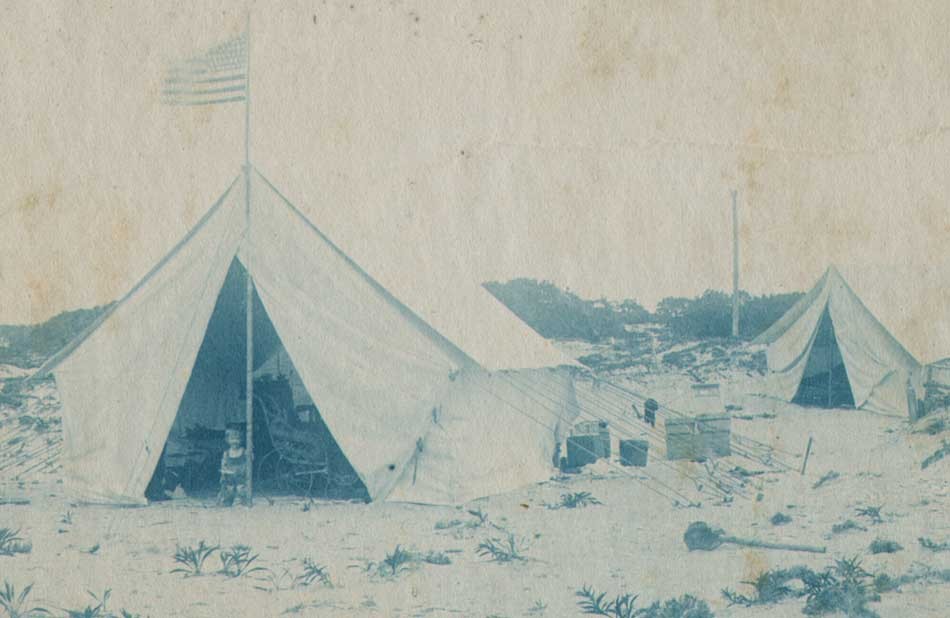 Detail: "Dorothy Tucker at Point O' Woods Beach Camp": Charles Rollins Tucker: American: cyanotype: 1901: 11.5 x 17.5 cm: Dorothy Tucker, (1899-1986) who appears to be no older than two years old, the young daughter of amateur photographer C.R. Tucker, stands at the entrance to a large canvas tent with American flag flying overhead on the beach at Point O' Woods. Wikipedia states this private retreat-even today- may have been the first settlement on Fire Island in Long Island Sound, and was originally organized in 1894 for religious retreats, some from the Chautauqua assemblies before ownership passed to the present-day Point O' Woods Association in 1898 after the first group went bankrupt. From: PhotoSeed Archive
Detail: "Dorothy Tucker at Point O' Woods Beach Camp": Charles Rollins Tucker: American: cyanotype: 1901: 11.5 x 17.5 cm: Dorothy Tucker, (1899-1986) who appears to be no older than two years old, the young daughter of amateur photographer C.R. Tucker, stands at the entrance to a large canvas tent with American flag flying overhead on the beach at Point O' Woods. Wikipedia states this private retreat-even today- may have been the first settlement on Fire Island in Long Island Sound, and was originally organized in 1894 for religious retreats, some from the Chautauqua assemblies before ownership passed to the present-day Point O' Woods Association in 1898 after the first group went bankrupt. From: PhotoSeed Archive
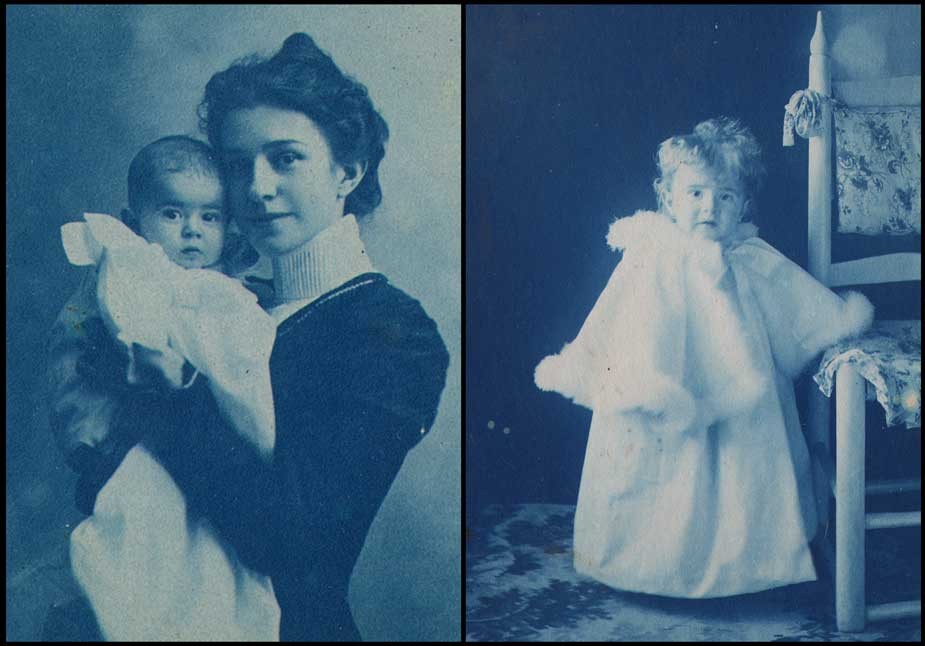 Left: Detail: "Baby Dorothy Tucker with Mother": Charles Rollins Tucker: American: cyanotype: 1899: 7.0 x 5.4 cm: Right: "Dorothy Tucker dressed in Fur-Trimmed Coat Next to Chair": Charles Rollins Tucker: American: cyanotype: 1900: 12.2 x 8.6 cm: Born in August of 1899 on New York's Staten Island, Dorothy Tucker was a constant subject for her father-a high school physics teacher at Curtis High School on the island-who trained his camera on her from birth to late teens. As a cyanotype, the photo showing Dorothy with her mother Mary Tucker (1870-1940) at left was thought well enough to frame behind glass as a family keepsake, lending credibility to the fact the process was not just considered a first way of proofing photos before a final selection was made. Instead, with the sequence shown in this post of four formal portraits of Dorothy as cyanotypes, the process was readily embraced by certain amateurs like Tucker. Both from: PhotoSeed Archive
Left: Detail: "Baby Dorothy Tucker with Mother": Charles Rollins Tucker: American: cyanotype: 1899: 7.0 x 5.4 cm: Right: "Dorothy Tucker dressed in Fur-Trimmed Coat Next to Chair": Charles Rollins Tucker: American: cyanotype: 1900: 12.2 x 8.6 cm: Born in August of 1899 on New York's Staten Island, Dorothy Tucker was a constant subject for her father-a high school physics teacher at Curtis High School on the island-who trained his camera on her from birth to late teens. As a cyanotype, the photo showing Dorothy with her mother Mary Tucker (1870-1940) at left was thought well enough to frame behind glass as a family keepsake, lending credibility to the fact the process was not just considered a first way of proofing photos before a final selection was made. Instead, with the sequence shown in this post of four formal portraits of Dorothy as cyanotypes, the process was readily embraced by certain amateurs like Tucker. Both from: PhotoSeed Archive
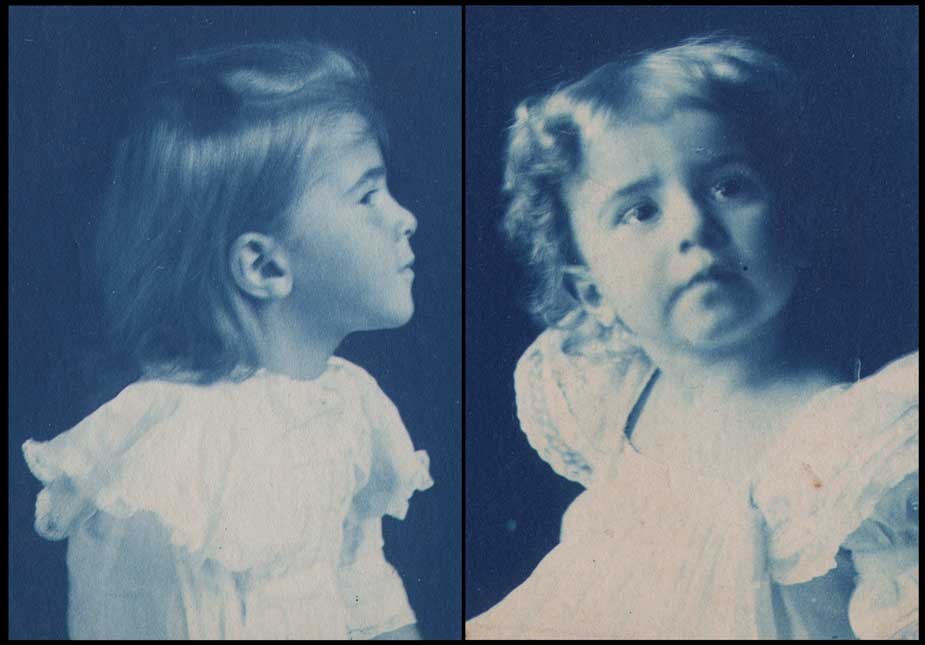 Left: "Dorothy Tucker Profile": Charles Rollins Tucker: American: cyanotype: ca. 1903: 9.9 x 7.2 cm: Right: "Portrait of Dorothy Tucker": Charles Rollins Tucker: American: cyanotype: ca. 1903: 9.3 x 6.9 | 17.8 x 12.8 cm. Born in August of 1899 on New York's Staten Island, Dorothy Tucker was a constant subject for her father-a high school physics teacher at Curtis High School on the island-who trained his camera on her from birth to late teens. Unlike many of the examples of Dorothy held by PhotoSeed that lack a mount, the cyanotype portrait of her at right was center-glued to a gray exhibition card, with another variant example printed in platinum showing evidence of being exhibited. Both from: PhotoSeed Archive
Left: "Dorothy Tucker Profile": Charles Rollins Tucker: American: cyanotype: ca. 1903: 9.9 x 7.2 cm: Right: "Portrait of Dorothy Tucker": Charles Rollins Tucker: American: cyanotype: ca. 1903: 9.3 x 6.9 | 17.8 x 12.8 cm. Born in August of 1899 on New York's Staten Island, Dorothy Tucker was a constant subject for her father-a high school physics teacher at Curtis High School on the island-who trained his camera on her from birth to late teens. Unlike many of the examples of Dorothy held by PhotoSeed that lack a mount, the cyanotype portrait of her at right was center-glued to a gray exhibition card, with another variant example printed in platinum showing evidence of being exhibited. Both from: PhotoSeed Archive
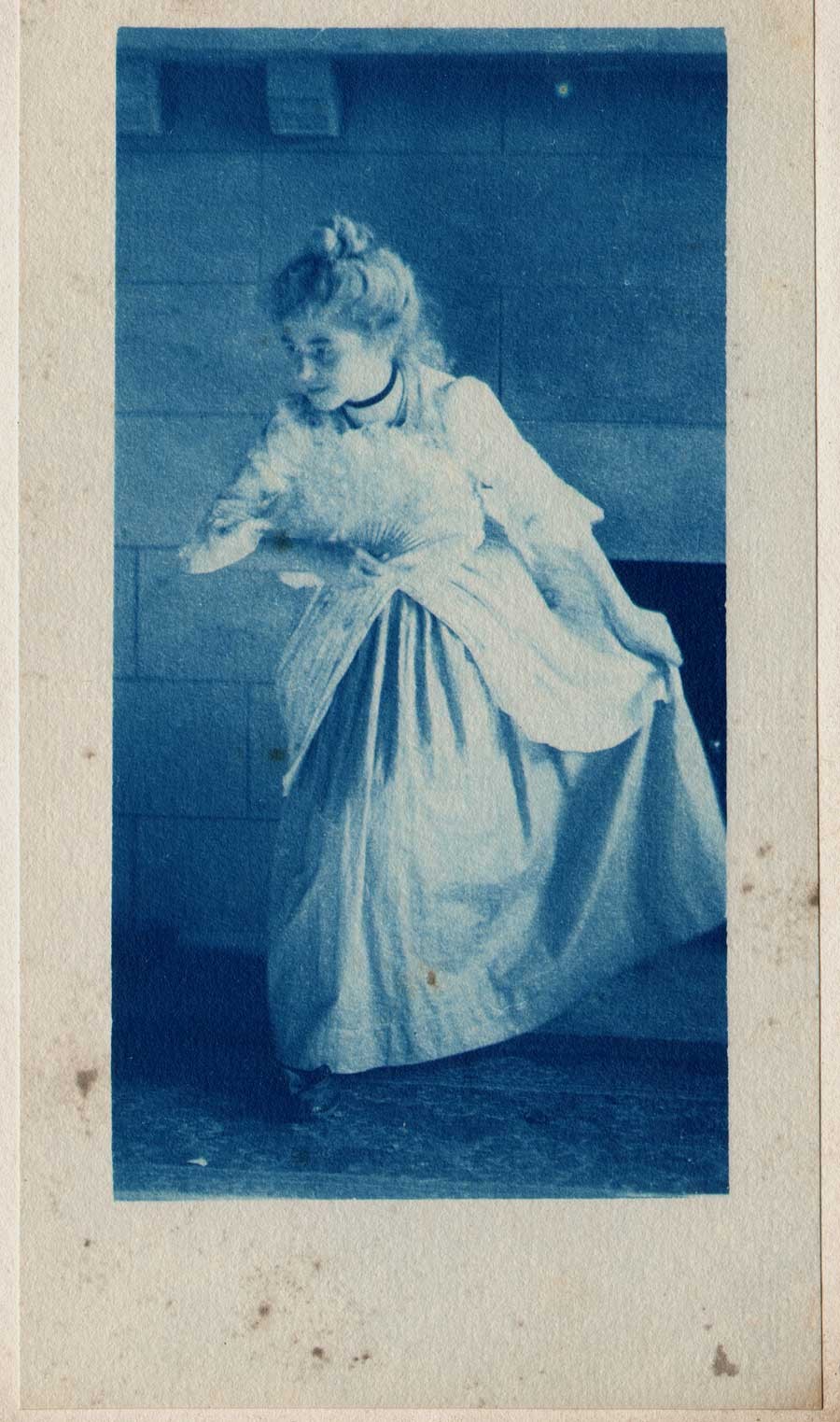 "Dorothy Tucker with Fan": presumed photographer: done in hand-inscribed, block letters: F.L.C.: American?: cyanotype: 1912: 16.5 x 8.6 | 22.0 x 11.3 cm: Shown presented within its tissue-guarded, ribbon tied folder, (22.6 x 12.3 cm) Dorothy Tucker, not quite 13 years old, strikes a pose with a fan inside her home on Staten Island, New York. She was most likely "performing" a part in a school play for "F.L.C.", presumed to be the photographer of this work who was certainly an acquaintance of Dorothy's amateur photographer father Charles Rollins Tucker. The presentation folder additionally dated in blue ink May 18, 1912 & annotated Dorothy Tucker in graphite along lower margin. From: PhotoSeed Archive
"Dorothy Tucker with Fan": presumed photographer: done in hand-inscribed, block letters: F.L.C.: American?: cyanotype: 1912: 16.5 x 8.6 | 22.0 x 11.3 cm: Shown presented within its tissue-guarded, ribbon tied folder, (22.6 x 12.3 cm) Dorothy Tucker, not quite 13 years old, strikes a pose with a fan inside her home on Staten Island, New York. She was most likely "performing" a part in a school play for "F.L.C.", presumed to be the photographer of this work who was certainly an acquaintance of Dorothy's amateur photographer father Charles Rollins Tucker. The presentation folder additionally dated in blue ink May 18, 1912 & annotated Dorothy Tucker in graphite along lower margin. From: PhotoSeed Archive
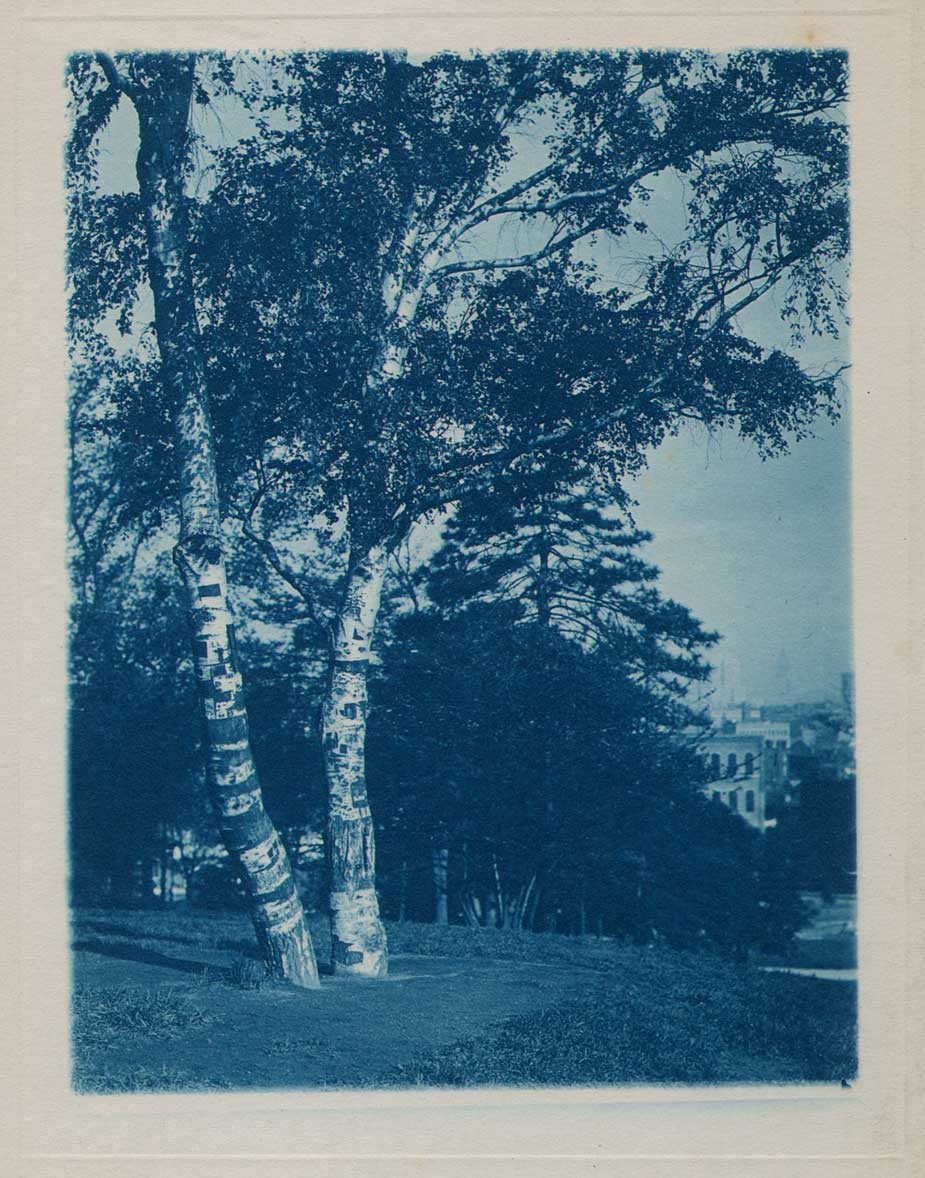 "White Birch Trees on Hill": by Unknown Brooklyn (photographer) : American: cyanotype: ca. 1905-10: 11.6 x 8.8 | 16.8 x 12.3 cm: A tantalizing backdrop of an unknown city can be seen in the distance at right of this cyanotype image featuring several sturdy white birch trees scarred in several places by penknives declaring true love. Possibly with a location of Prospect Park in Brooklyn, this photograph, with title supplied by this archive, is by an Unknown Brooklyn amateur photographer whose surviving work was discovered in a trunk in the American South. Background can be found by searching for this site's 2015 blog post: "No Junk in Trunk". From: PhotoSeed Archive
"White Birch Trees on Hill": by Unknown Brooklyn (photographer) : American: cyanotype: ca. 1905-10: 11.6 x 8.8 | 16.8 x 12.3 cm: A tantalizing backdrop of an unknown city can be seen in the distance at right of this cyanotype image featuring several sturdy white birch trees scarred in several places by penknives declaring true love. Possibly with a location of Prospect Park in Brooklyn, this photograph, with title supplied by this archive, is by an Unknown Brooklyn amateur photographer whose surviving work was discovered in a trunk in the American South. Background can be found by searching for this site's 2015 blog post: "No Junk in Trunk". From: PhotoSeed Archive
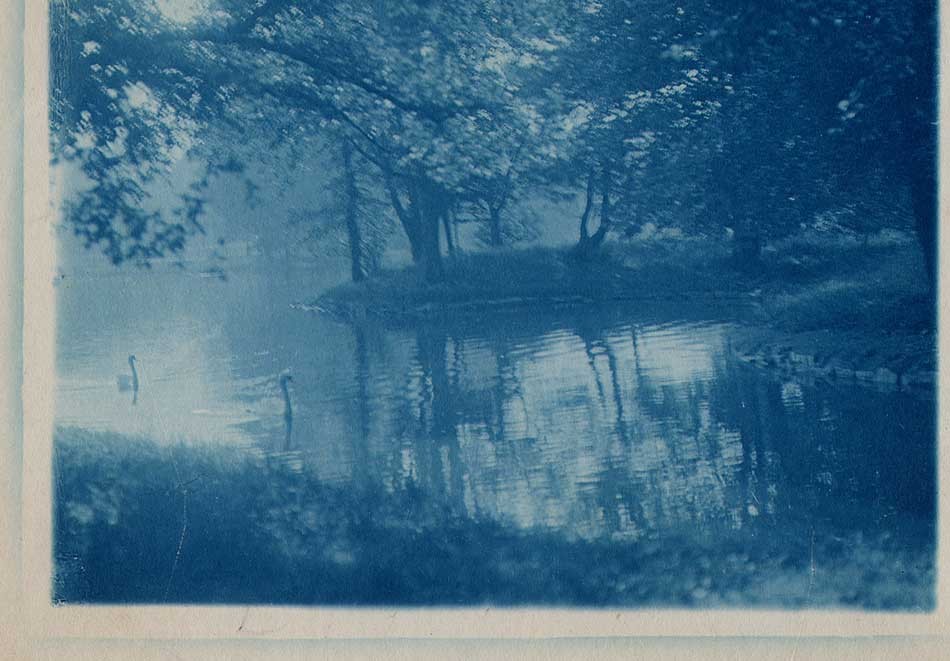 "Swans in Mist": by Unknown Brooklyn (photographer) : American: cyanotype: ca. 1905-10: 8.8 x 11.6 | 12.6 x 17.7 cm: Swans glide through mist on a lake in a park setting-possibly Brooklyn's Prospect Park as many known examples of this location were taken by this photographer. This photograph, with title supplied by this archive, is by an Unknown Brooklyn amateur photographer whose surviving work was discovered in a trunk in the American South. Background can be found by searching for this site's 2015 blog post: "No Junk in Trunk". From: PhotoSeed Archive
"Swans in Mist": by Unknown Brooklyn (photographer) : American: cyanotype: ca. 1905-10: 8.8 x 11.6 | 12.6 x 17.7 cm: Swans glide through mist on a lake in a park setting-possibly Brooklyn's Prospect Park as many known examples of this location were taken by this photographer. This photograph, with title supplied by this archive, is by an Unknown Brooklyn amateur photographer whose surviving work was discovered in a trunk in the American South. Background can be found by searching for this site's 2015 blog post: "No Junk in Trunk". From: PhotoSeed Archive
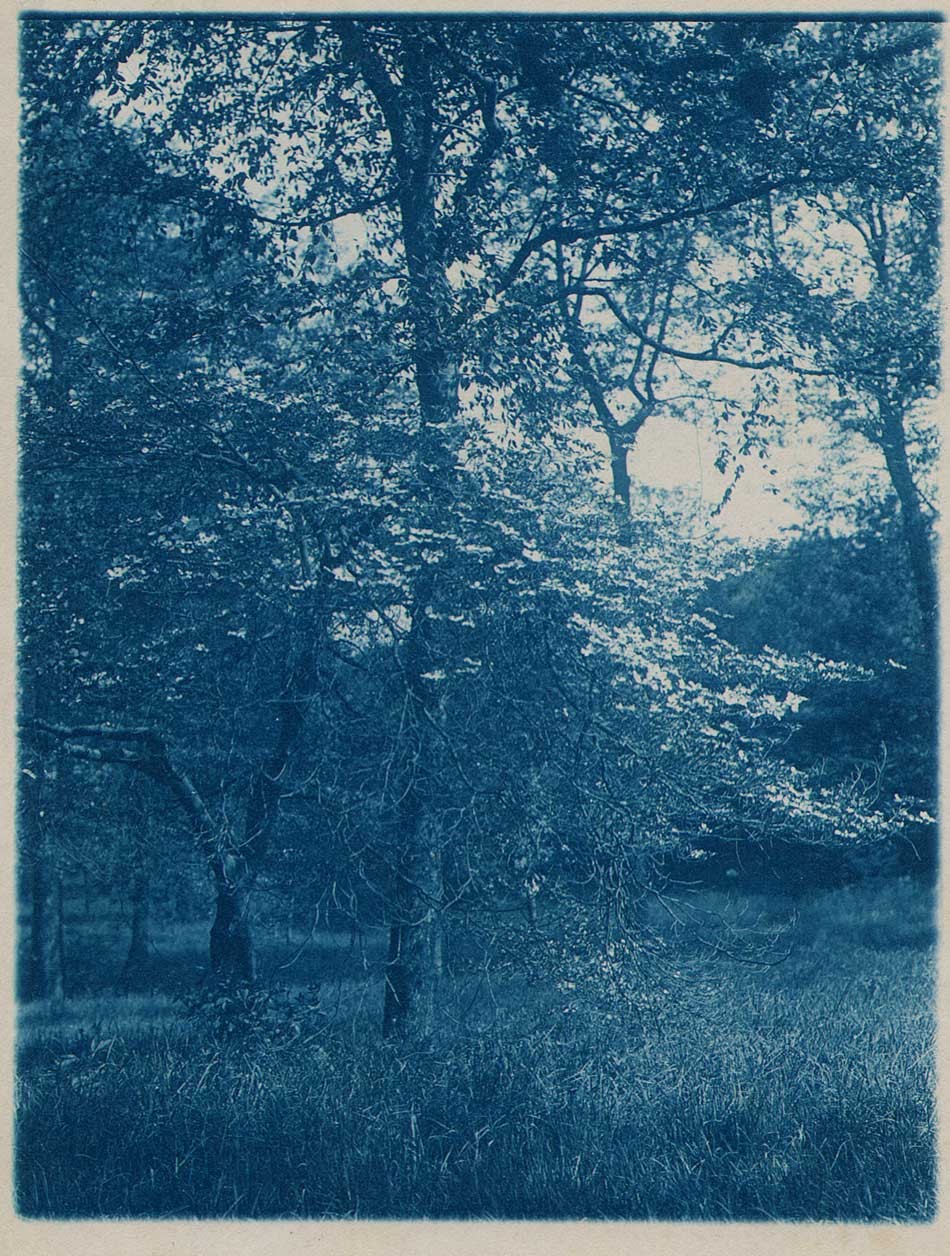 "Dogwood Tree in Bloom": by Unknown Brooklyn (photographer) : American: cyanotype: ca. 1905-10: 11.7 x 8.9 | 16.8 x 11.7 cm: A Dogwood tree blooms on the edge of a meadow in a park setting-possibly Brooklyn's Prospect Park as many known examples of this location were taken by this photographer. This photograph, with title supplied by this archive, is by an Unknown Brooklyn amateur photographer whose surviving work was discovered in a trunk in the American South. Background can be found by searching for this site's 2015 blog post: "No Junk in Trunk". From: private U.S. collection.
"Dogwood Tree in Bloom": by Unknown Brooklyn (photographer) : American: cyanotype: ca. 1905-10: 11.7 x 8.9 | 16.8 x 11.7 cm: A Dogwood tree blooms on the edge of a meadow in a park setting-possibly Brooklyn's Prospect Park as many known examples of this location were taken by this photographer. This photograph, with title supplied by this archive, is by an Unknown Brooklyn amateur photographer whose surviving work was discovered in a trunk in the American South. Background can be found by searching for this site's 2015 blog post: "No Junk in Trunk". From: private U.S. collection.
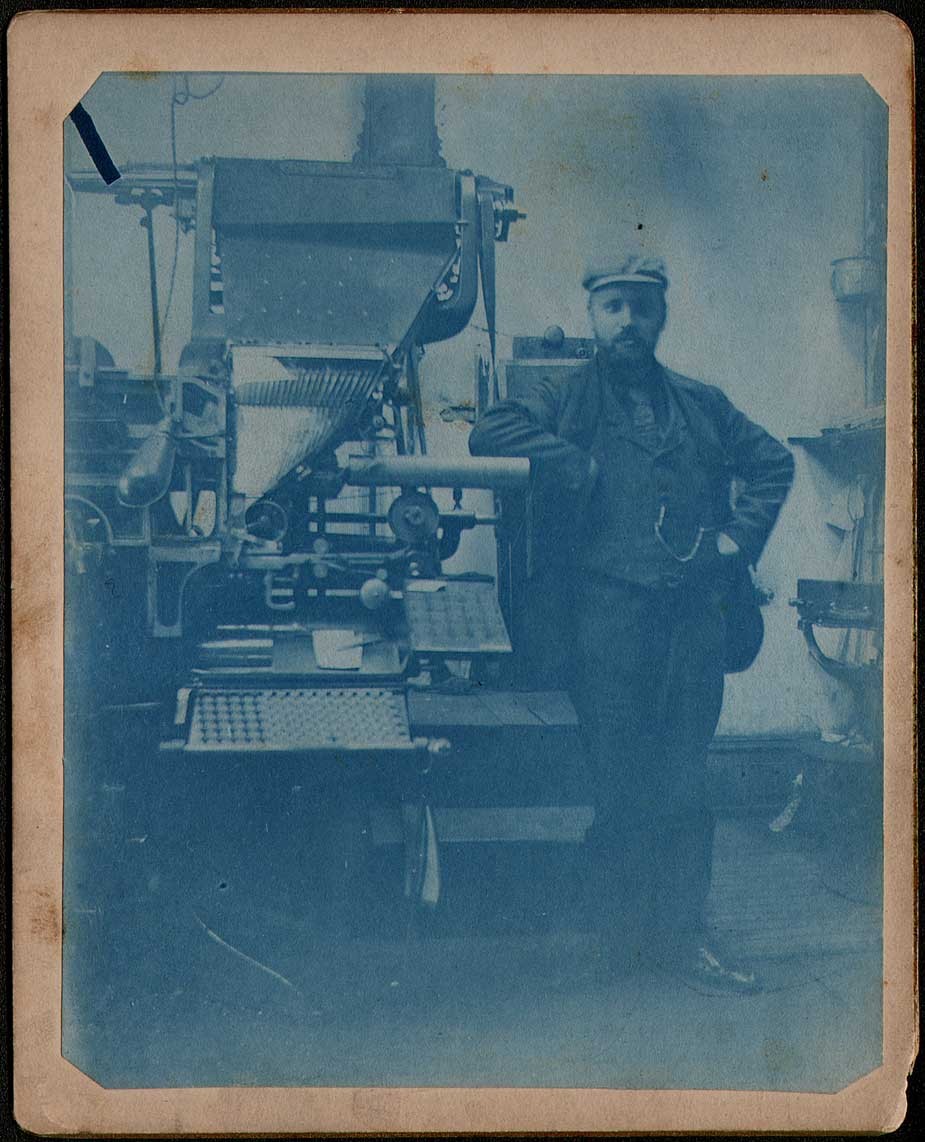 "Man Standing Next to Linotype Machine": unknown photographer: cyanotype: ca. 1895-1905: 11.9 x 9.6 | 13.2 x 10.6 cm: With the only annotation being the word Chicago written on the verso of this intriguing card-mounted cyanotype indicating origin, it's interesting to note that blueprinting, in addition to recording mechanical drawings, was also commonly used to make a record of large machinery like this early Linotype machine, an invention that revolutionized the speed of printing, particularly for newspapers and magazines. Invented by the German-born Ottmar Mergenthaler, (1854-1899) who has an uncanny surviving photographic likeness to the gentleman appearing in this cyanotype, the Linotype was first commercially used by the New York Tribune newspaper in 1886 and was in use into the 1970's, when it was largely replaced by offset lithography printing and computer typesetting. From: PhotoSeed Archive
"Man Standing Next to Linotype Machine": unknown photographer: cyanotype: ca. 1895-1905: 11.9 x 9.6 | 13.2 x 10.6 cm: With the only annotation being the word Chicago written on the verso of this intriguing card-mounted cyanotype indicating origin, it's interesting to note that blueprinting, in addition to recording mechanical drawings, was also commonly used to make a record of large machinery like this early Linotype machine, an invention that revolutionized the speed of printing, particularly for newspapers and magazines. Invented by the German-born Ottmar Mergenthaler, (1854-1899) who has an uncanny surviving photographic likeness to the gentleman appearing in this cyanotype, the Linotype was first commercially used by the New York Tribune newspaper in 1886 and was in use into the 1970's, when it was largely replaced by offset lithography printing and computer typesetting. From: PhotoSeed Archive
And now, examples of “blue prints” owing their roots to the beauty of the cyanotype reproduced using alternate photo-mechanical and photographic processes:
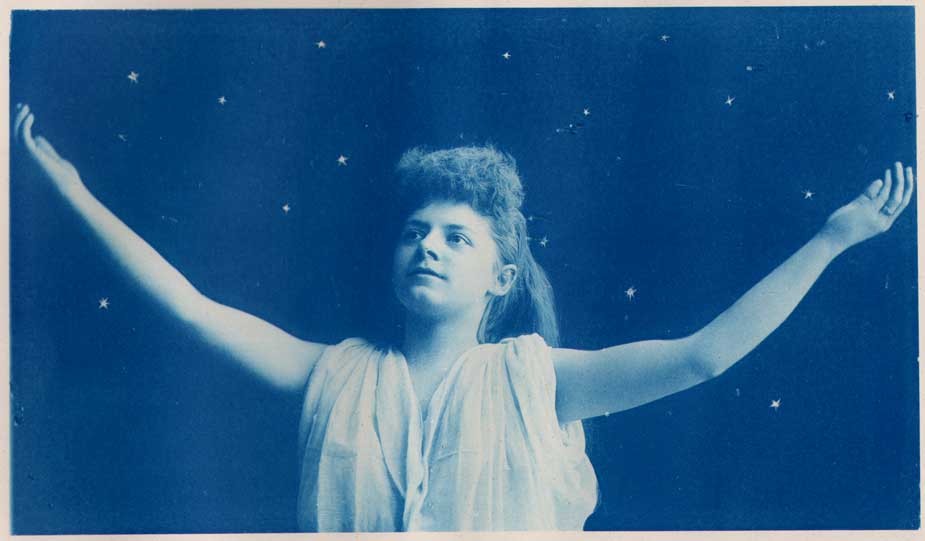 "Starlight": Charles Edward Doty: American 1862-1921: blue-toned collotype published in periodical "Sun & Shade: An Artistic Periodical": New York: January, 1890: whole #17: N.Y. Photo-Gravure Co.: 11.2 x 19.4 cm | 27.6 x 35.0 cm: The popularity of the cyanotype process gave reason for firms like the Photo Gravure Co. of New York to provide print runs for a larger audience of works like "Starlight" whose source imagery was originally a cyanotype. The model, said to be one Miss Emma McCormick, was photographed by Hamilton, Ohio portrait photographer Doty with outstretched arms against a backdrop of stars that were most likely added in the engraving process. Doty, according to the Smithsonian Institution in Washington, which owns hundreds of his original photographs, went on to become the "official photographer of the United States government in Havana," his duties included documenting the modernization of Cuba under American governorship. From: PhotoSeed Archive
"Starlight": Charles Edward Doty: American 1862-1921: blue-toned collotype published in periodical "Sun & Shade: An Artistic Periodical": New York: January, 1890: whole #17: N.Y. Photo-Gravure Co.: 11.2 x 19.4 cm | 27.6 x 35.0 cm: The popularity of the cyanotype process gave reason for firms like the Photo Gravure Co. of New York to provide print runs for a larger audience of works like "Starlight" whose source imagery was originally a cyanotype. The model, said to be one Miss Emma McCormick, was photographed by Hamilton, Ohio portrait photographer Doty with outstretched arms against a backdrop of stars that were most likely added in the engraving process. Doty, according to the Smithsonian Institution in Washington, which owns hundreds of his original photographs, went on to become the "official photographer of the United States government in Havana," his duties included documenting the modernization of Cuba under American governorship. From: PhotoSeed Archive
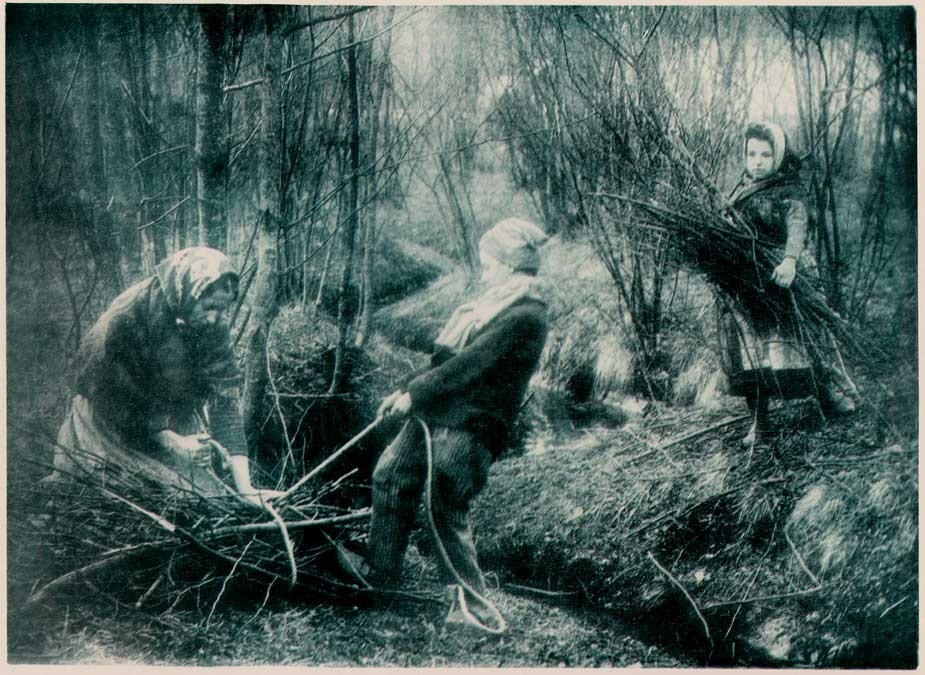 "Bundling and Gathering Faggots": Nestor Stekke: La Louvière, Belgium: blue-tinted collotype published in Sentiment d'Art en Photographie: Brussels,: Vol. II, No. 1, Planche 1: October, 1899: 16.1 x 22.3 | 26.5 x 37.2 cm: Featuring the work primarily of Belgian photographers but open to all, this folio-sized high-quality photographic plate publication, (The Feeling of Art in Photography) under the direction of Camille Smits with reproductions executed in collotype by Jules Liorel, featured the award winning work of pictorialists who entered monthly contests on a given theme judged by painter (M. Titz) and amateur photographer Van Gèle. Short-lived, Sentiment debuted in October, 1898 and ran until January, 1901 when it was renamed L'Art en Photographie . From: PhotoSeed Archive
"Bundling and Gathering Faggots": Nestor Stekke: La Louvière, Belgium: blue-tinted collotype published in Sentiment d'Art en Photographie: Brussels,: Vol. II, No. 1, Planche 1: October, 1899: 16.1 x 22.3 | 26.5 x 37.2 cm: Featuring the work primarily of Belgian photographers but open to all, this folio-sized high-quality photographic plate publication, (The Feeling of Art in Photography) under the direction of Camille Smits with reproductions executed in collotype by Jules Liorel, featured the award winning work of pictorialists who entered monthly contests on a given theme judged by painter (M. Titz) and amateur photographer Van Gèle. Short-lived, Sentiment debuted in October, 1898 and ran until January, 1901 when it was renamed L'Art en Photographie . From: PhotoSeed Archive
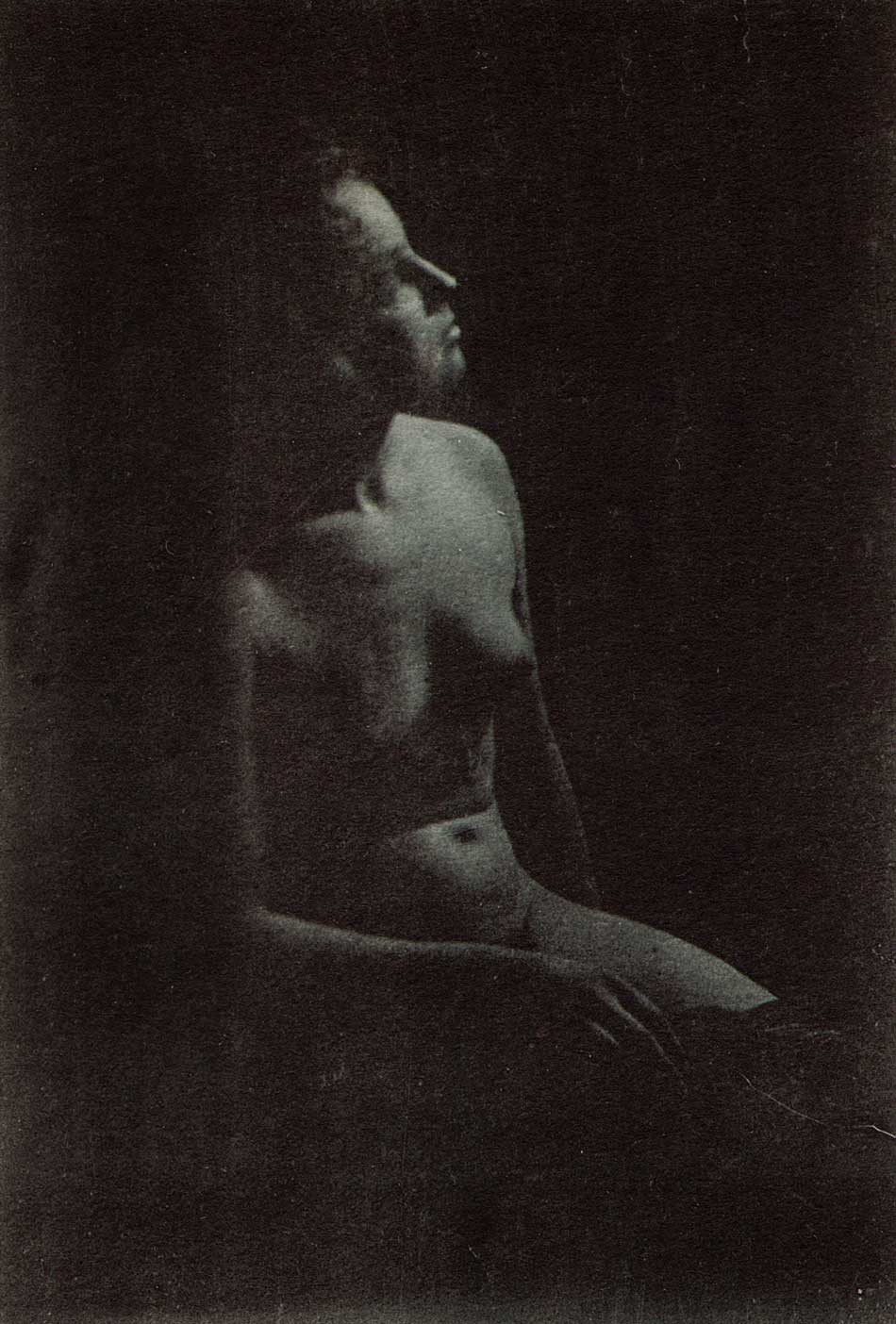 "Nude in Darkness": Léon Sneyers: Belgium:(1877-1949) collotype published in L'Art en Photographie: Brussels: No. 8: August, 1901: 12.4 x 8.3 | 37.0 x 25.5 cm: Translated to "Art in Photography", this folio-sized plate work was a continuation of "Le Sentiment d'Art en Photographie", with primarily Belgian pictorialists entering their work in contests on a given theme. Published by Jules Liorel, who also printed the plates in his Brussels atelier, a bibliography of this monthly work states it was "undoubtedly inspired by "Die Kunst in der Photographie", a German publication, and by "L'Art Photographique" published in Paris". This observation was made in reference to the fine-quality plates issued with it, as in this female nude study by Sneyers taken in the shadows and printed effectively by Liorel in collotype using an ink color combining deep black and violet to compliment the closed eyes of Sneyer's model. From: PhotoSeed Archive
"Nude in Darkness": Léon Sneyers: Belgium:(1877-1949) collotype published in L'Art en Photographie: Brussels: No. 8: August, 1901: 12.4 x 8.3 | 37.0 x 25.5 cm: Translated to "Art in Photography", this folio-sized plate work was a continuation of "Le Sentiment d'Art en Photographie", with primarily Belgian pictorialists entering their work in contests on a given theme. Published by Jules Liorel, who also printed the plates in his Brussels atelier, a bibliography of this monthly work states it was "undoubtedly inspired by "Die Kunst in der Photographie", a German publication, and by "L'Art Photographique" published in Paris". This observation was made in reference to the fine-quality plates issued with it, as in this female nude study by Sneyers taken in the shadows and printed effectively by Liorel in collotype using an ink color combining deep black and violet to compliment the closed eyes of Sneyer's model. From: PhotoSeed Archive
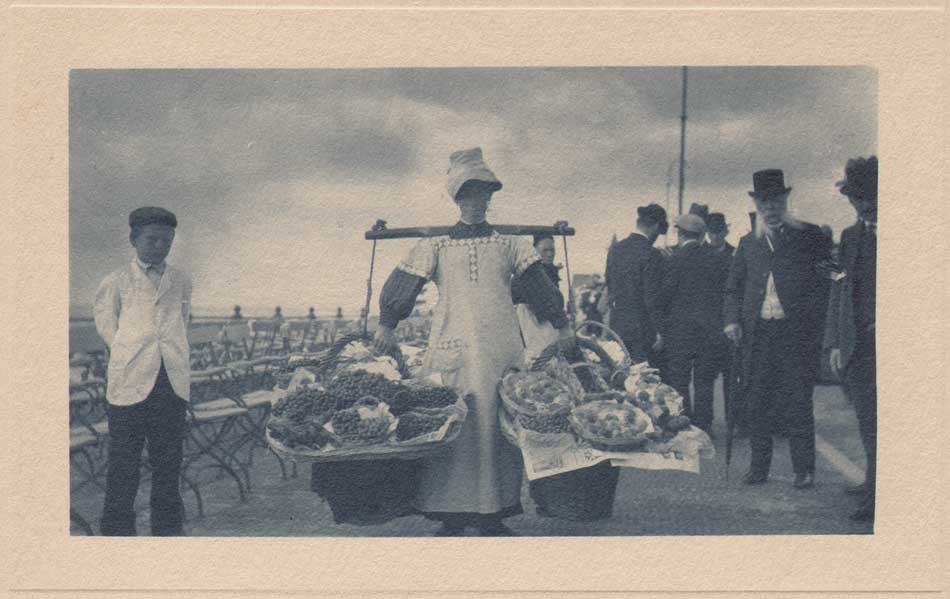 "Fruit Seller on Scheveningen Pier": Frank G.(eorge) Ensenberger, American: 1879-1966: blue-toned bromoil transfer print: 1910: 7.6 x 13.1 | 27.0 x 22.3 cm: A young woman balancing her load of grapes and other fruits for sale with a yoke stands on the Scheveningen Pier at the popular seaside resort located in The Hague in the Netherlands. In May, 1910, amateur photographer Frank Ensenberger of Bloomington, Ill sailed from Boston to Europe with his family, where he spent four months touring Great Britain, the Continent and other countries all while documenting the trip with his camera. On his return, approximately 900 selects were made by him and printed in various tints as bromoil transfer prints by an unknown professional photographer. They were gathered by country in leather-bound volumes, of which PhotoSeed owns nine. A prosperous business merchant and president of Ensenberger's home furnishings store in Bloomington, the Bloomington Pantagraph newspaper wrote of his photographic efforts during the trip in September, 1910, commenting: "The proofs show Mr. Ensenberger possesses the rare instinct of recognizing the setting for a good picture when he sees it, many of the views being truly artistic." Truthfully, his work was competent overall, with many of the plates being more "snapshot" in nature although documentary images scattered throughout the volumes show better than average compositional qualities. From: PhotoSeed Archive
"Fruit Seller on Scheveningen Pier": Frank G.(eorge) Ensenberger, American: 1879-1966: blue-toned bromoil transfer print: 1910: 7.6 x 13.1 | 27.0 x 22.3 cm: A young woman balancing her load of grapes and other fruits for sale with a yoke stands on the Scheveningen Pier at the popular seaside resort located in The Hague in the Netherlands. In May, 1910, amateur photographer Frank Ensenberger of Bloomington, Ill sailed from Boston to Europe with his family, where he spent four months touring Great Britain, the Continent and other countries all while documenting the trip with his camera. On his return, approximately 900 selects were made by him and printed in various tints as bromoil transfer prints by an unknown professional photographer. They were gathered by country in leather-bound volumes, of which PhotoSeed owns nine. A prosperous business merchant and president of Ensenberger's home furnishings store in Bloomington, the Bloomington Pantagraph newspaper wrote of his photographic efforts during the trip in September, 1910, commenting: "The proofs show Mr. Ensenberger possesses the rare instinct of recognizing the setting for a good picture when he sees it, many of the views being truly artistic." Truthfully, his work was competent overall, with many of the plates being more "snapshot" in nature although documentary images scattered throughout the volumes show better than average compositional qualities. From: PhotoSeed Archive
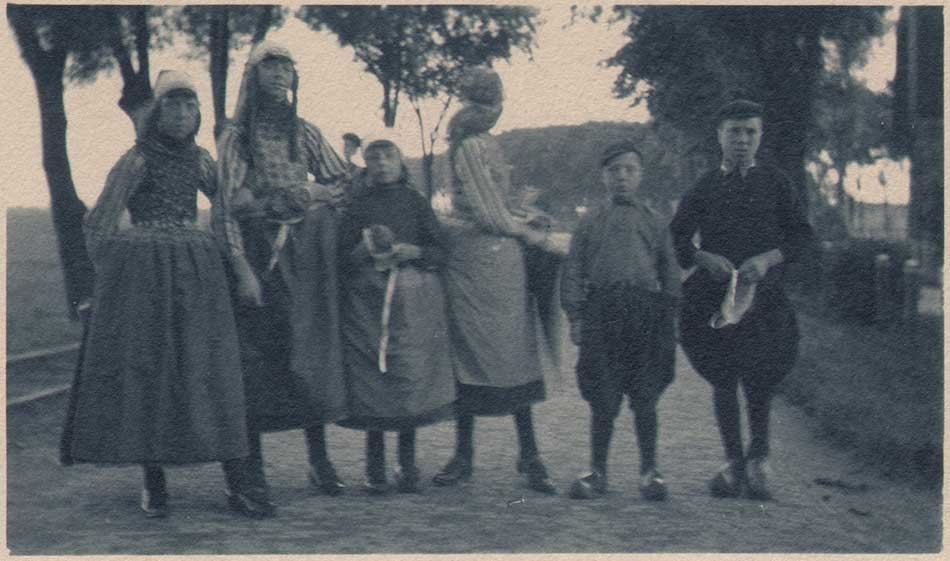 "Children Portrait Group in Holland": Frank G.(eorge) Ensenberger, American: 1879-1966: blue-toned bromoil transfer print: 1910: 7.6 x 13.1 | 27.0 x 22.3 cm: Standing in the middle of a roadway in Holland, a group of six children in their native dress stand for a portrait, the boys at right wearing traditional wooden shoes. In May, 1910, amateur photographer Frank Ensenberger of Bloomington, Ill sailed from Boston to Europe with his family, where he spent four months touring Great Britain, the Continent and other countries all while documenting the trip with his camera. On his return, approximately 900 selects were made by him and printed in various tints as bromoil transfer prints by an unknown professional photographer. They were gathered by country in leather-bound volumes, of which PhotoSeed owns nine. A prosperous business merchant and president of Ensenberger's home furnishings store in Bloomington, the Bloomington Pantagraph newspaper wrote of his photographic efforts during the trip in September, 1910, commenting: "The proofs show Mr. Ensenberger possesses the rare instinct of recognizing the setting for a good picture when he sees it, many of the views being truly artistic." Truthfully, his work was competent overall, with many of the plates being more "snapshot" in nature although documentary images scattered throughout the volumes show better than average compositional qualities. From: PhotoSeed Archive
"Children Portrait Group in Holland": Frank G.(eorge) Ensenberger, American: 1879-1966: blue-toned bromoil transfer print: 1910: 7.6 x 13.1 | 27.0 x 22.3 cm: Standing in the middle of a roadway in Holland, a group of six children in their native dress stand for a portrait, the boys at right wearing traditional wooden shoes. In May, 1910, amateur photographer Frank Ensenberger of Bloomington, Ill sailed from Boston to Europe with his family, where he spent four months touring Great Britain, the Continent and other countries all while documenting the trip with his camera. On his return, approximately 900 selects were made by him and printed in various tints as bromoil transfer prints by an unknown professional photographer. They were gathered by country in leather-bound volumes, of which PhotoSeed owns nine. A prosperous business merchant and president of Ensenberger's home furnishings store in Bloomington, the Bloomington Pantagraph newspaper wrote of his photographic efforts during the trip in September, 1910, commenting: "The proofs show Mr. Ensenberger possesses the rare instinct of recognizing the setting for a good picture when he sees it, many of the views being truly artistic." Truthfully, his work was competent overall, with many of the plates being more "snapshot" in nature although documentary images scattered throughout the volumes show better than average compositional qualities. From: PhotoSeed Archive
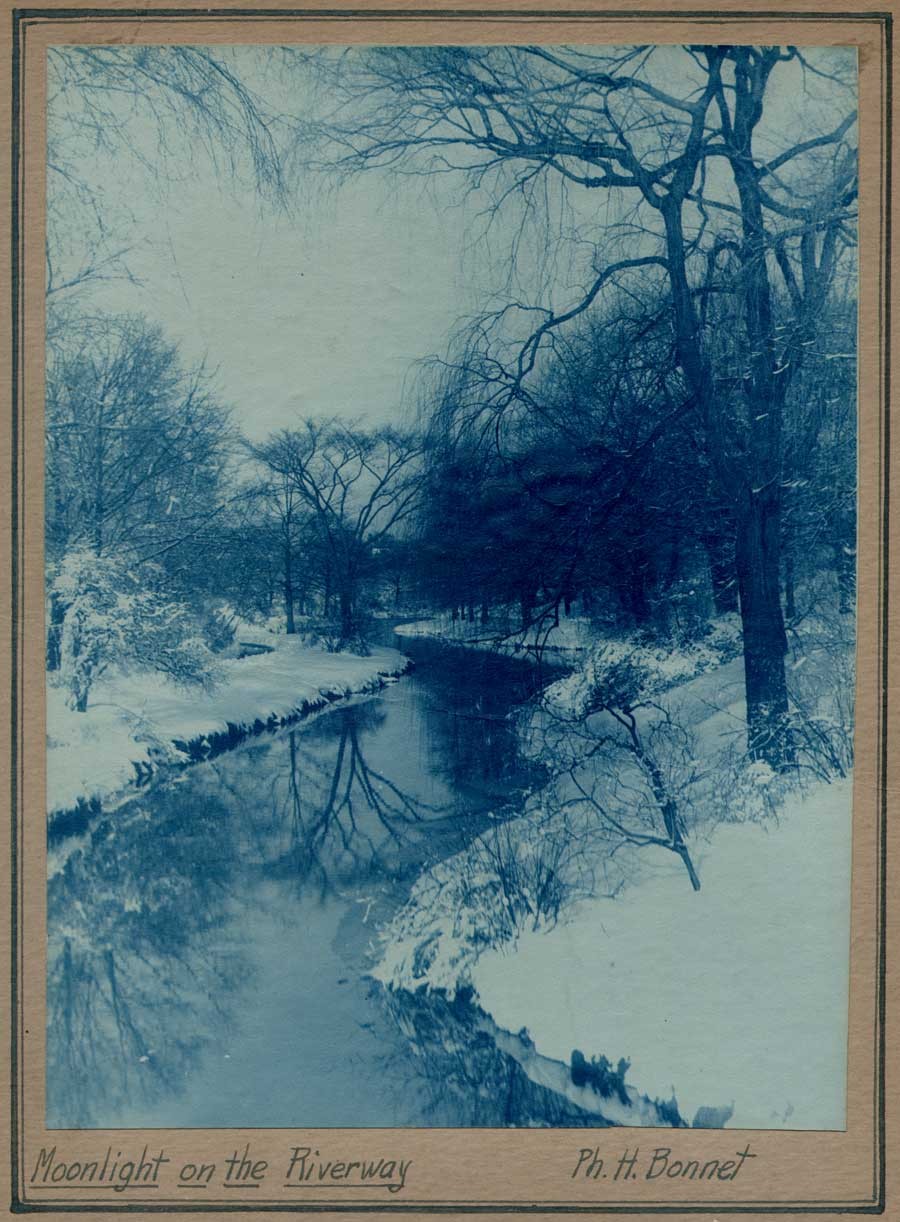 "Moonlight on the Riverway": Ph.(ilippe) H. Bonnet: 1904-1977: American: born France: blue-toned silver bromide print? ca. 1930-40: 24.8 x 18.6 | 38.6 x 26.3 cm: As a younger man, Philippe H. Bonnet was a staff photographer for The Tech, the Massachusetts Institute of Technology's undergraduate student newspaper. He is believed to have graduated from MIT in 1931 as listed in the Tech. In the early 1960's, a newspaper said he was a well known Boston architect. He also later made a name for himself as a railroad photographer-especially of trolley cars- and made his own real photo post cards and stamped them individually as a "Ferroviagraph". This scenic view of a river in Winter is from a series of landscape photographs believed to have been taken by him in the Middlesex Fells Reservation, a 2500 acre natural area located just north of Boston. A double-lined, hand-ruled frame in blue ink compliments the deep-blue effect achieved through the action of blue-toning. From: PhotoSeed Archive
"Moonlight on the Riverway": Ph.(ilippe) H. Bonnet: 1904-1977: American: born France: blue-toned silver bromide print? ca. 1930-40: 24.8 x 18.6 | 38.6 x 26.3 cm: As a younger man, Philippe H. Bonnet was a staff photographer for The Tech, the Massachusetts Institute of Technology's undergraduate student newspaper. He is believed to have graduated from MIT in 1931 as listed in the Tech. In the early 1960's, a newspaper said he was a well known Boston architect. He also later made a name for himself as a railroad photographer-especially of trolley cars- and made his own real photo post cards and stamped them individually as a "Ferroviagraph". This scenic view of a river in Winter is from a series of landscape photographs believed to have been taken by him in the Middlesex Fells Reservation, a 2500 acre natural area located just north of Boston. A double-lined, hand-ruled frame in blue ink compliments the deep-blue effect achieved through the action of blue-toning. From: PhotoSeed Archive
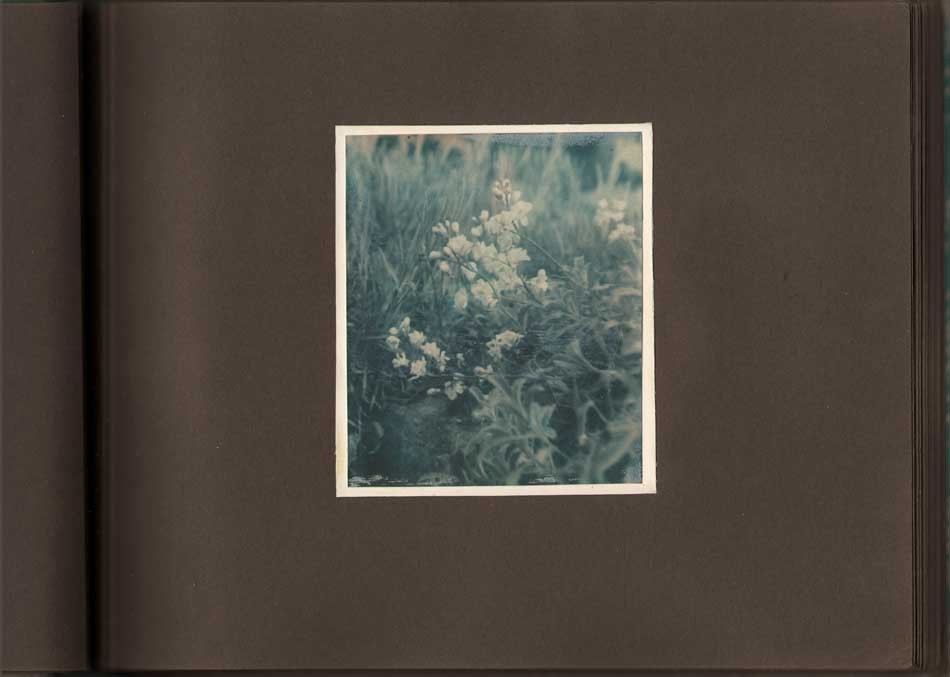 "Baby's Breath Growing in Wild": unknown photographer: blue-toned gelatin silver print: ca. 1930-40: 12.5 x 10.5 | 13.2 x 11.4 | 23.8 x 31.9 cm: This delicate study of what are believed to be Baby's Breath flowers (Gypsophilia, or Das Schleierkraut) is presented here in an album by an anonymous photographer (purchased from a seller in Greece) including a selection of pictorialist works featuring nicely mounted cityscape, mountain, and marine views, several of which show Frankfurt, Germany. From: PhotoSeed Archive
"Baby's Breath Growing in Wild": unknown photographer: blue-toned gelatin silver print: ca. 1930-40: 12.5 x 10.5 | 13.2 x 11.4 | 23.8 x 31.9 cm: This delicate study of what are believed to be Baby's Breath flowers (Gypsophilia, or Das Schleierkraut) is presented here in an album by an anonymous photographer (purchased from a seller in Greece) including a selection of pictorialist works featuring nicely mounted cityscape, mountain, and marine views, several of which show Frankfurt, Germany. From: PhotoSeed Archive
And in conclusion, a final cyanotype:
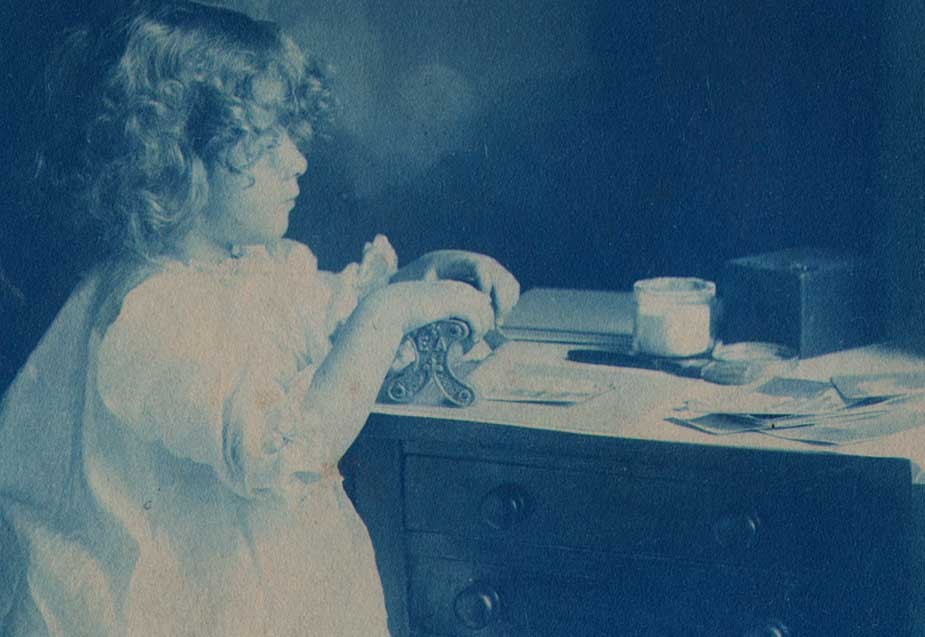 Detail: "Dorothy Tucker Mounting Photographs": Charles Rollins Tucker: American: cyanotype: ca. 1903: 11.3 x 8.6 | 15.0 x 12.6 cm: Seated on a stool, Dorothy Tucker, (1899-1986) the young daughter of amateur photographer Charles Rollins Tucker, is shown using an E. & H.T. Anthony brand Print Mounter to mount a photograph on a work table. Possibly taken for one of the yearly amateur Kodak advertising contests, the work space shows a Kodak Brownie camera at right rear, loose photographs, an album and a jar of what is most likely "Daisy" mounting paste with a brush next to it. Gripping the top of the mounter, young Dorothy prepares to slide the mounter with its two rollers over a print seen just to the right of it. The initials "EA" for Edward Anthony, are engraved on the side of roller. The E. & H.T. Anthony firm was considered the largest manufacturer and distributor of photographic supplies in the United States during the 19th century. From: PhotoSeed Archive
Detail: "Dorothy Tucker Mounting Photographs": Charles Rollins Tucker: American: cyanotype: ca. 1903: 11.3 x 8.6 | 15.0 x 12.6 cm: Seated on a stool, Dorothy Tucker, (1899-1986) the young daughter of amateur photographer Charles Rollins Tucker, is shown using an E. & H.T. Anthony brand Print Mounter to mount a photograph on a work table. Possibly taken for one of the yearly amateur Kodak advertising contests, the work space shows a Kodak Brownie camera at right rear, loose photographs, an album and a jar of what is most likely "Daisy" mounting paste with a brush next to it. Gripping the top of the mounter, young Dorothy prepares to slide the mounter with its two rollers over a print seen just to the right of it. The initials "EA" for Edward Anthony, are engraved on the side of roller. The E. & H.T. Anthony firm was considered the largest manufacturer and distributor of photographic supplies in the United States during the 19th century. From: PhotoSeed Archive
California Pipe Dreamer
Posted January 2016 in Alternate Processes, History of Photography, Journals, New Additions, Publishing, Texts
Sigismund Blumann, (1872-1956) an American who became an important editor and photographer after moving to San Francisco, California from New York City in the early 1880’s is our subject for this post, along with his involvement with and history of Camera Craft magazine. Never heard of him? A few relevant but by no means comprehensive list of details about this gentleman whose friends addressed him as “Sig” for short:
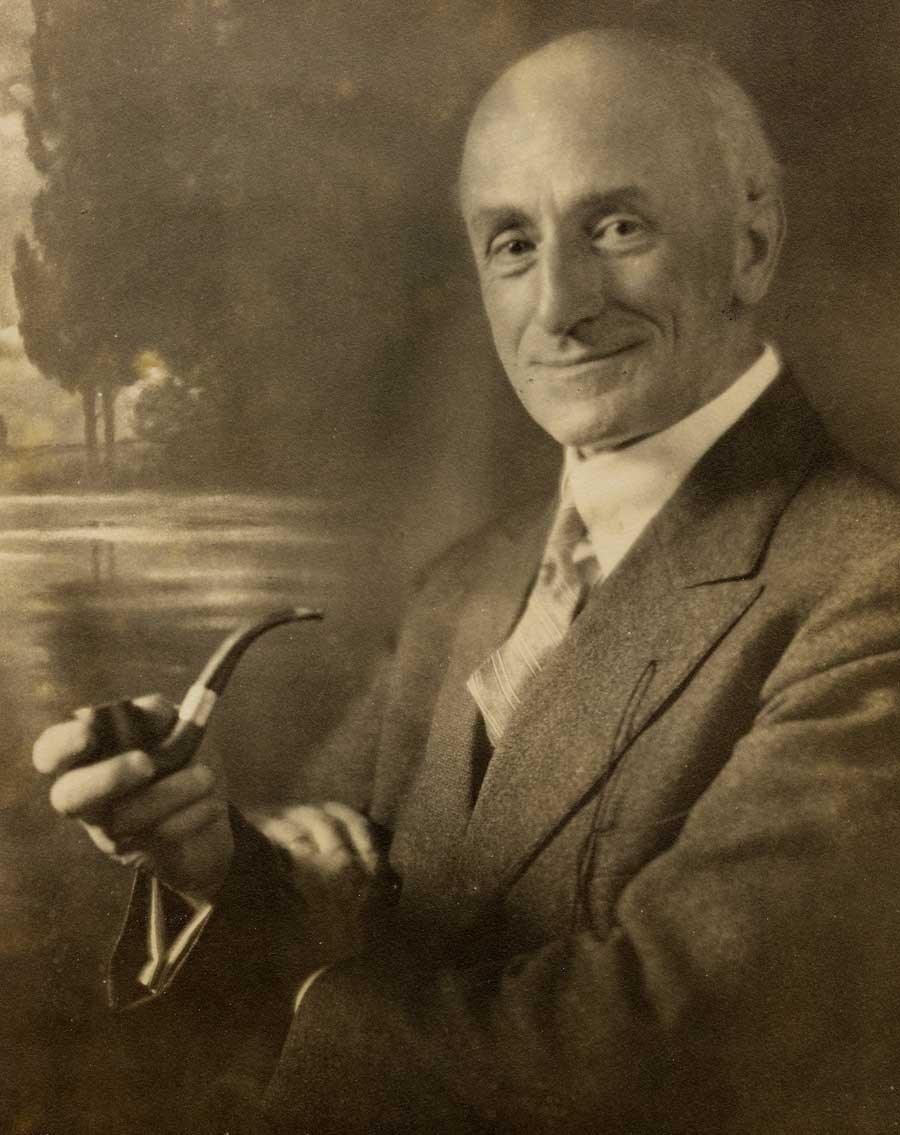 Detail: "Self-Portrait of Sigismund Blumann" (1872-1956) : American: gelatin silver print ca. 1930: Blumann was editor-in-chief of San Francisco-based Camera Craft magazine from 1924-1933: Photograph courtesy Thomas High
Detail: "Self-Portrait of Sigismund Blumann" (1872-1956) : American: gelatin silver print ca. 1930: Blumann was editor-in-chief of San Francisco-based Camera Craft magazine from 1924-1933: Photograph courtesy Thomas High
⌘ West Coast champion for photography in his role as Editor-in-Chief of Camera Craft magazine from 1924-1933. Prolific writer for said journal whose love of language sometimes lead to his mangling of it, but only with the best of intentions.
⌘ Significant pictorialist photographer from the same period and earlier whose darkroom work was equally inventive and important.
⌘ Poet.
⌘ So gregarious in affect, photographic historian Christian A. Peterson duly notes, (1.) that as editor, he personally answered all correspondence sent to him by his 8000 monthly Camera Craft readers in addition to his regular duties of penning multiple articles for each issue.
⌘ Possession of a sly sense of humor: look no further than a ca. 1930 self-portrait in which his suit lapel sprouts a long cable release rather than a floral boutonnière.
⌘ Conservative writer in print who often took a while to accept new ideas: as one example, Peterson notes his use of the made-up word “Sewereelism” included in a 1938 editorial written by him on his feelings towards the failings of the art movements Surrealism and Dada for the magazine Photo Art Monthly, a publication he owned himself. (2.)
⌘ Pipe smoker extraordinaire. Featured not only in the above referenced self-portrait but immortalized by artist W.R. Potter in print every month as artistic caricature shown smoking and reading a book used for his Under the Editor’s Lamp column in Camera Craft beginning in April 1926.
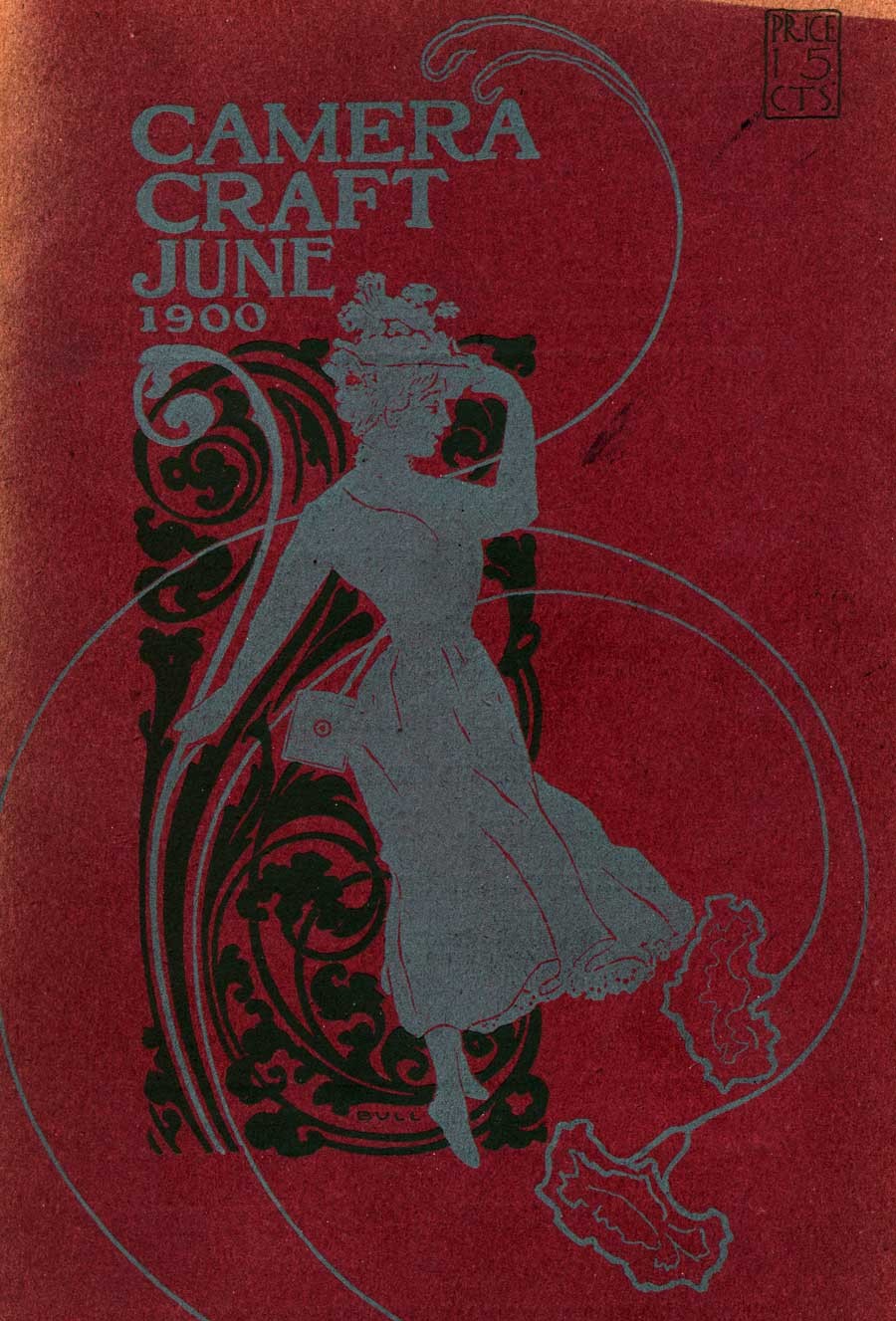 Detail: Cover Design: Camera Craft magazine: June, 1900: William Howell Bull: 1851-1940: American-California: 26.0 x 17.5 cm: two-color wood engraving : Sunset Press & Photo Engraving Company - San Francisco: cover price at upper right corner 15¢. Although this was the second issue of the magazine to appear, the first issue for May used the same cover design showing this stylish woman done in the Art-Nouveau style with small box camera slung on her side. From: PhotoSeed Archive
Detail: Cover Design: Camera Craft magazine: June, 1900: William Howell Bull: 1851-1940: American-California: 26.0 x 17.5 cm: two-color wood engraving : Sunset Press & Photo Engraving Company - San Francisco: cover price at upper right corner 15¢. Although this was the second issue of the magazine to appear, the first issue for May used the same cover design showing this stylish woman done in the Art-Nouveau style with small box camera slung on her side. From: PhotoSeed Archive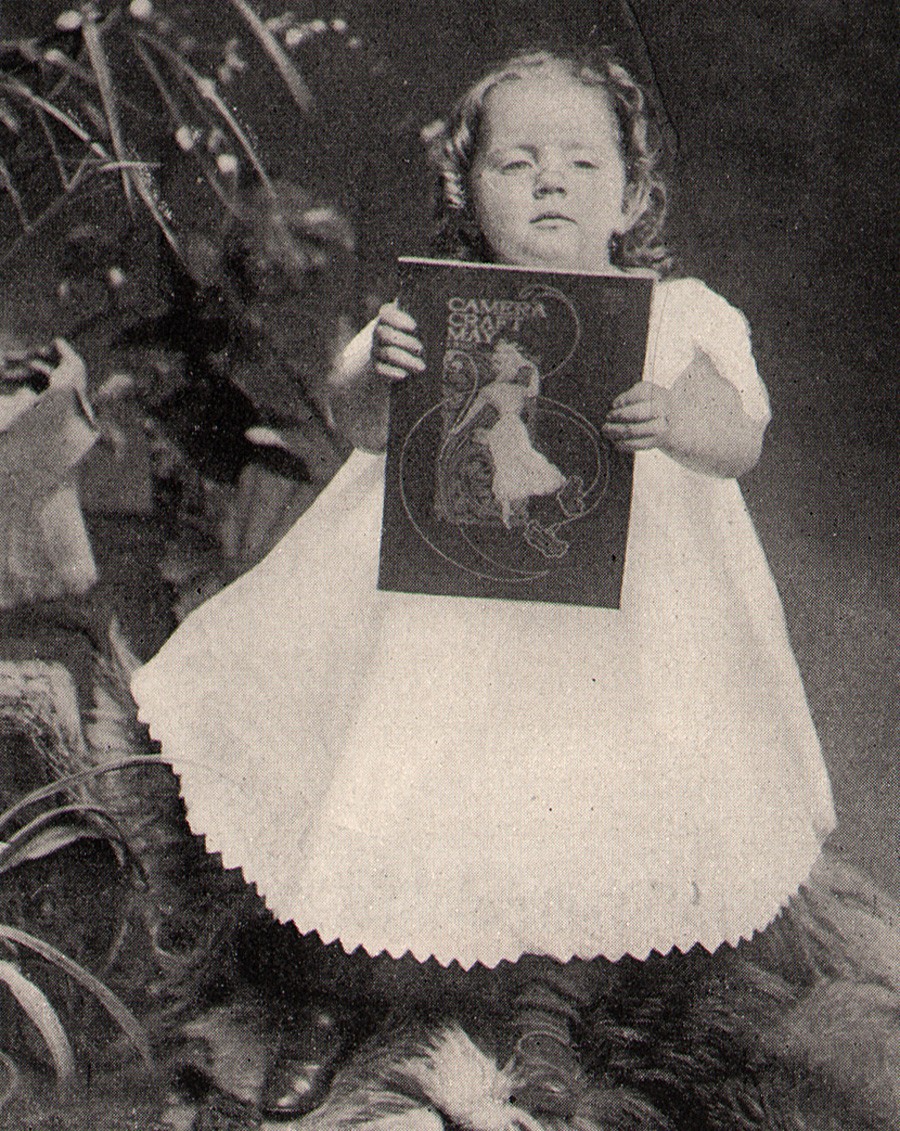 Detail: "Everyone Reads It": Mrs. C.S. Smith, American: Marysville (CA): halftone from June, 1900 Camera Craft magazine p. 57: 10.6 x 8.1 cm: A young girl holds up the very first issue of Camera Craft dated May, 1900. The design by California artist W.H. Bull was also used as the cover for June, 1900. From: PhotoSeed Archive
Detail: "Everyone Reads It": Mrs. C.S. Smith, American: Marysville (CA): halftone from June, 1900 Camera Craft magazine p. 57: 10.6 x 8.1 cm: A young girl holds up the very first issue of Camera Craft dated May, 1900. The design by California artist W.H. Bull was also used as the cover for June, 1900. From: PhotoSeed Archive
Sigismund Blumann: Short Biography
For the past three years, I’ve had the distinct pleasure of corresponding with Thomas High, Sigismund Blumann’s grandson, and been equally fortunate in acquiring a small archive of Sig’s vintage work for PhotoSeed previously kept in the family. Unlike Sig’s friends, Tom tells me, as a boy of perhaps five or six, he would of course address him as Grampa Blumann. Tom goes on to say:
”I only wish I had known him better – he died when I was a child, and my only real memories of him were playing rummy and whist with him.”
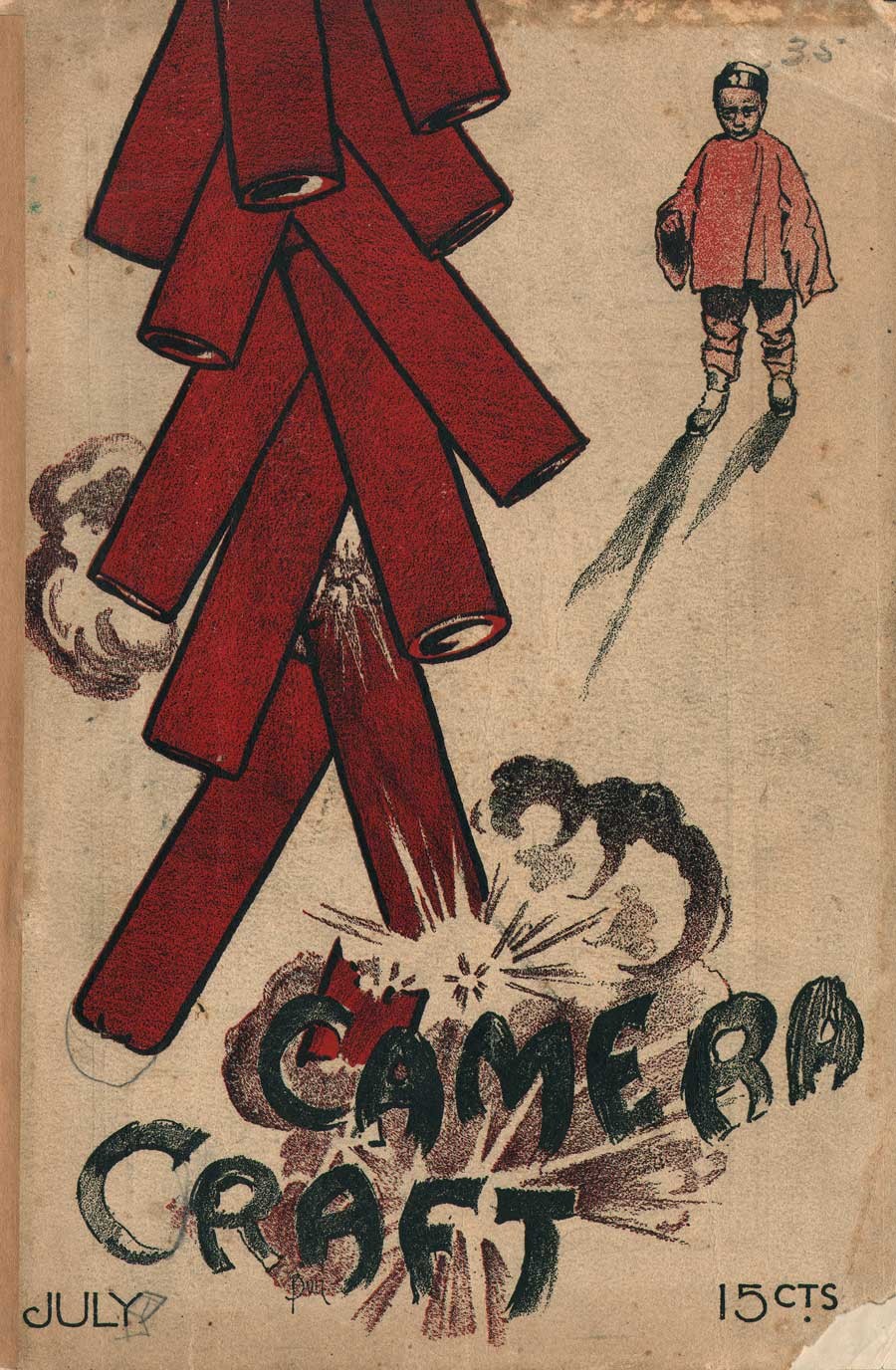 Cover Design: Chinese Firecrackers: Camera Craft magazine: July, 1900: William Howell Bull: 1851-1940: American-California: 26.0 x 17.5 cm: two-color wood engraving : Sunset Press & Photo Engraving Company - San Francisco: cover price at lower right corner 15¢. From: PhotoSeed Archive
Cover Design: Chinese Firecrackers: Camera Craft magazine: July, 1900: William Howell Bull: 1851-1940: American-California: 26.0 x 17.5 cm: two-color wood engraving : Sunset Press & Photo Engraving Company - San Francisco: cover price at lower right corner 15¢. From: PhotoSeed ArchiveTom has also agreed to let me reprint for purposes of introduction the following short biography of his grandfather written in October, 2009, for which I’m very grateful.
Sigismund Blumann (1872-1956) by Thomas High
Sigismund Blumann was born on September 13, 1872, in New York City, the son of Alexander Blumann and Rosalie (Price) Blumann. He came to San Francisco with his parents in late 1881 or 1882, and subsequently became a professional pianist and music teacher.
Sigismund Blumann married first on August 30, 1894, to Adele Morgenstern. They divorced in May of 1895. He married second on June 4, 1901, to Hilda Axelina Johansson and they subsequently had four daughters, Ethel, Amy, Lorna, and Vera.
In the 1890s, Sigismund Blumann became interested in photography and had begun taking photos seriously by 1900 while living in San Francisco. At the time of the San Francisco earthquake on April 9, 1906, he and his wife were still living with his parents on Army Street. He volunteered to help the recovery and, with his official permits, got through the lines and took a number of photographs.
Mr. Blumann was also a prolific writer and he authored numerous articles, commentaries, and poems.
After the 1906 earthquake, the Blumanns moved to Davis Street in Fruitvale (later part of Oakland). From that time, all of his photographic work was done in his darkroom at the Davis Street home.
Photography increased in importance in his life, and at the 1915 Panama-Pacific International Exposition he combined all of his talents: he played in an orchestra, photographed the Fair, and worked as a correspondent for the New York Tribune and other newspapers.
In the early 1920s, Sigismund retired from an active career in music and entered the profession of efficiency engineering, with offices in the Monadnock Building in San Francisco. His principal client was the Forster Music Publishing Company.
He continued his interest in photography and in 1924 he became editor of Camera Craft magazine. In addition to editing the publication and writing numerous articles for it, he also wrote the Photographic Workroom Handbook, published by Camera Craft in 1927.
Mr. Blumann’s last issue as editor of Camera Craft was in August of 1933. Several months later, he launched his own magazine, Photo Art Monthly, which he edited and published until 1940. During this period, he also produced several more manuals for amateur photographers, including the Photographic Handbook, Photographic Greetings - How to Make Them, Enlarging Manual, and Toning Processes.
In 1940, he sold the Photo Art Monthly to his assistant, Franke Unger (who married photographer Adolf Fassbender about the same time). She soon closed the magazine.
The Blumanns continued to live at their Davis Street home for the rest of their lives, joined by their unmarried daughters, Ethel and Lorna Blumann, both librarians. He produced little photographic work in the 1940s and 1950s, contenting himself to dabble in photography and discuss it with his new son-in-law, William A. High, who married his daughter, Vera, in February of 1943. Bill High was a commercial photographer before World War II, a combat photographer for the US Army during the war, and the founder of the photography department at Oakland’s Laney Trade School (later Peralta Junior College) thereafter.
Sigismund Blumann died in Oakland on July 9, 1956, and Hilda Blumann died on February 1, 1958, also in Oakland.
Sigismund Blumann’s photos are in the Oakland Museum, Minneapolis Institute of Art, High Museum in Atlanta, and elsewhere.
For further information, see “Sigismund Blumann, California Editor and Photographer,” by Christian A. Peterson, in History of Photography, vol. 26, no. 1. (Spring 2002).
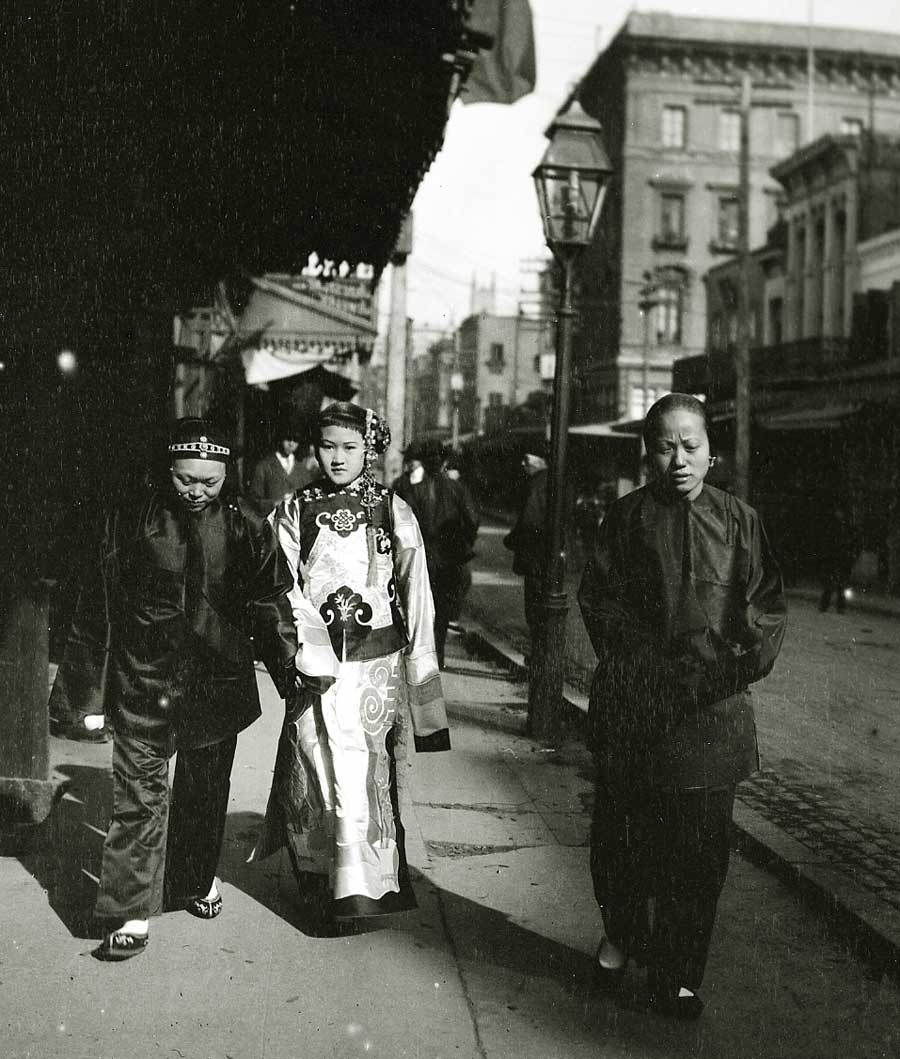 Detail: "Highborn Lady With Duenna": Sigismund Blumann: American: ca. 1901: This view is from a collection of at least 43 documentary photographs, with several corresponding paper negative envelopes dated 1901 by Blumann donated by his family to the California Historical Society. They can be viewed there as part of the collection “The Chinese in California: 1850-1925.” Photograph courtesy Thomas High
Detail: "Highborn Lady With Duenna": Sigismund Blumann: American: ca. 1901: This view is from a collection of at least 43 documentary photographs, with several corresponding paper negative envelopes dated 1901 by Blumann donated by his family to the California Historical Society. They can be viewed there as part of the collection “The Chinese in California: 1850-1925.” Photograph courtesy Thomas High
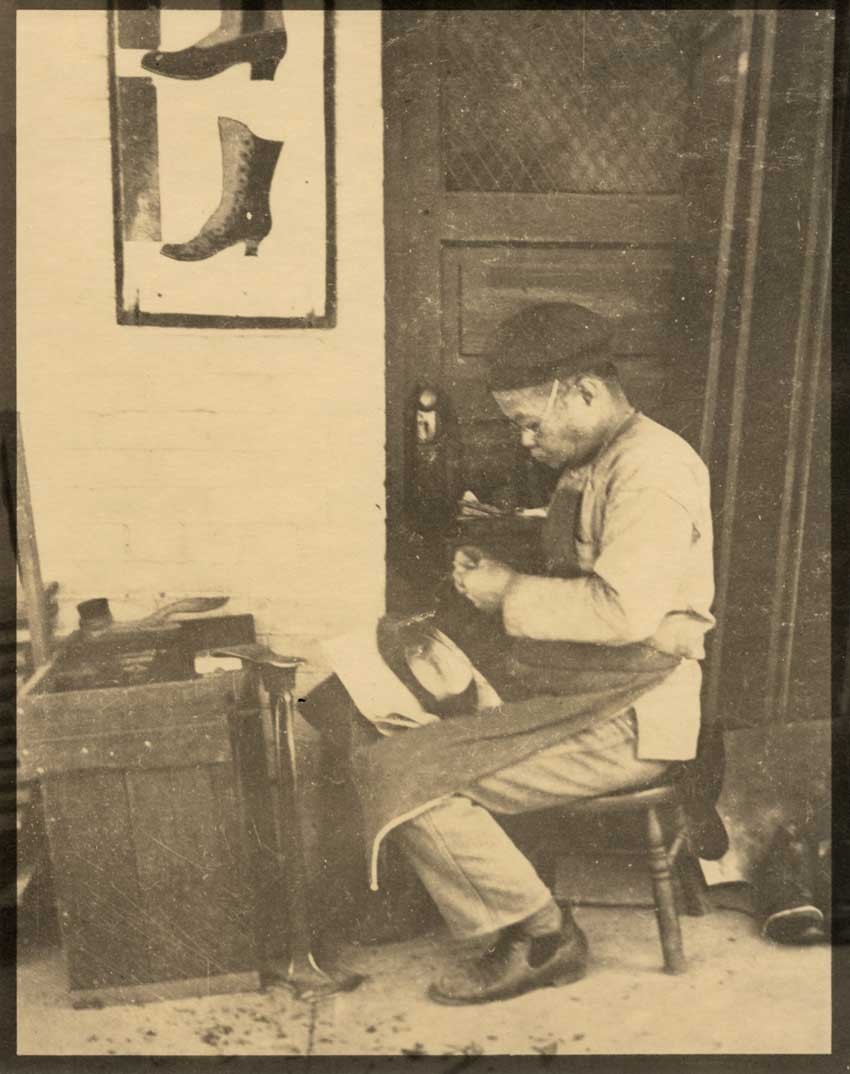 "Chinese Cobbler": San Francisco Chinatown: Sigismund Blumann: American: ca. 1901, printed early 1920s: gelatin silver print- app. 8 7/8 x 7.0": variant: "Shoe Mender": from California Historical Society collection: FN-34374: Photograph courtesy Thomas High
"Chinese Cobbler": San Francisco Chinatown: Sigismund Blumann: American: ca. 1901, printed early 1920s: gelatin silver print- app. 8 7/8 x 7.0": variant: "Shoe Mender": from California Historical Society collection: FN-34374: Photograph courtesy Thomas High
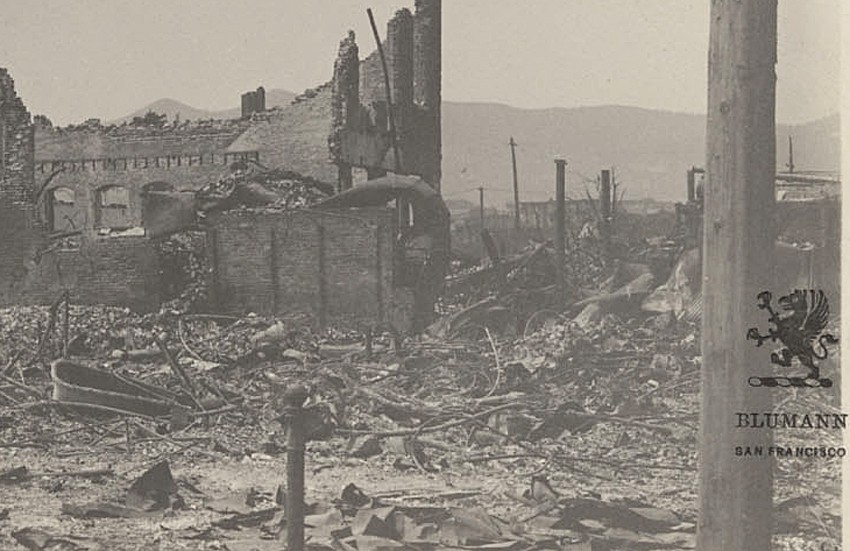 Detail: "Ruins" (San Francisco Earthquake): Sigismund Blumann: American: ca. 1906: gelatin silver print: 13.0 x 18.0 cm: overprinted with Blumann's winged griffin monogram at lower right: Photograph courtesy: California Historical Society: The 1906 San Francisco Earthquake and Fire Digital Collection: Local Call # FN-33293
Detail: "Ruins" (San Francisco Earthquake): Sigismund Blumann: American: ca. 1906: gelatin silver print: 13.0 x 18.0 cm: overprinted with Blumann's winged griffin monogram at lower right: Photograph courtesy: California Historical Society: The 1906 San Francisco Earthquake and Fire Digital Collection: Local Call # FN-33293
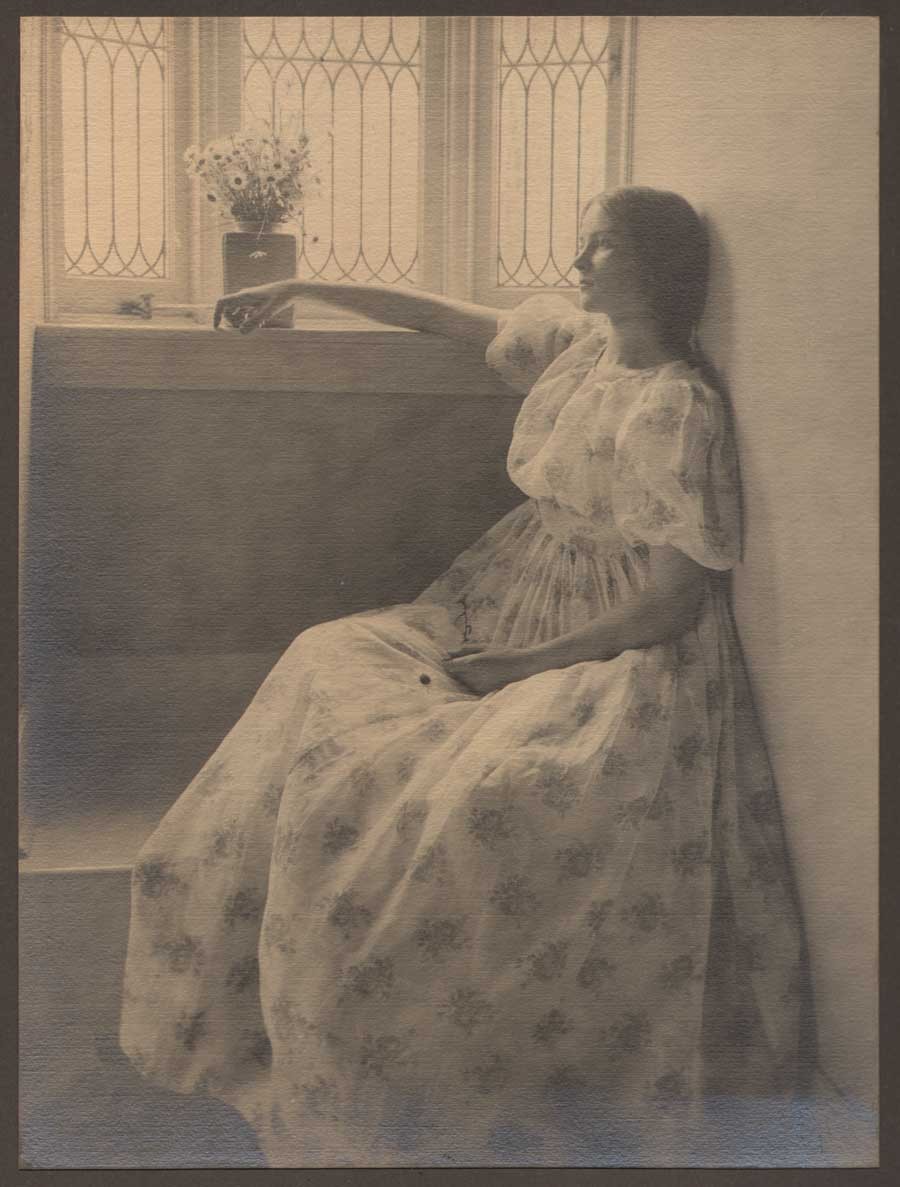 "Day Dreams" : Charles Rollins Tucker 1868-1956: American: gelatin silver print: June, 1906 printed 1915: 27.3 x 20.4 | 43.2 x 35.5 cm : First titled "Study in Home Portraiture" and published full page in the Oct. 1906 Photographic Times, this interior study later appeared as a full-page halftone in the July, 1907 Camera Craft magazine, and is a representative example of the pictorialist work that regularly appeared in its pages. Coincidentally, imagery like this was also gaining popularity during this time among amateur and professional photographers, and Sigismund Blumann was no exception, teaming up with fellow photographer Jacques Tillmany in 1907 on a part-time basis offering in-home photographic portraiture. From: PhotoSeed Archive
"Day Dreams" : Charles Rollins Tucker 1868-1956: American: gelatin silver print: June, 1906 printed 1915: 27.3 x 20.4 | 43.2 x 35.5 cm : First titled "Study in Home Portraiture" and published full page in the Oct. 1906 Photographic Times, this interior study later appeared as a full-page halftone in the July, 1907 Camera Craft magazine, and is a representative example of the pictorialist work that regularly appeared in its pages. Coincidentally, imagery like this was also gaining popularity during this time among amateur and professional photographers, and Sigismund Blumann was no exception, teaming up with fellow photographer Jacques Tillmany in 1907 on a part-time basis offering in-home photographic portraiture. From: PhotoSeed Archive
Beginnings in Word and Photography
Writing under his infrequent pen name Charles H. Fitzpatrick in Camera Craft in 1925, (3.) Sig most likely gives us a small hint of his own beginnings in photography, a passion that would soon evolve into his extensive documentation of life of San Francisco’s bustling Chinatown neighborhood in 1901. (4.) Later in this capacity as street shooter, he played the role of documentarian in the aftermath of the destruction of San Francisco in the 1906 earthquake and subsequent job as part-time portrait photographer after relocating to neighboring Oakland in 1907 due to the destruction. (5.) all while making his living as musical performer and teacher) :
Having become interested in Photography back in 1900 as an amateur with an old style Adlake plate camera, and two years later as a professional with a studio— and almost continuously since in Commercial Photography the author has had a wonderful opportunity to study composition both by experience and observation of the work of others. (6.)
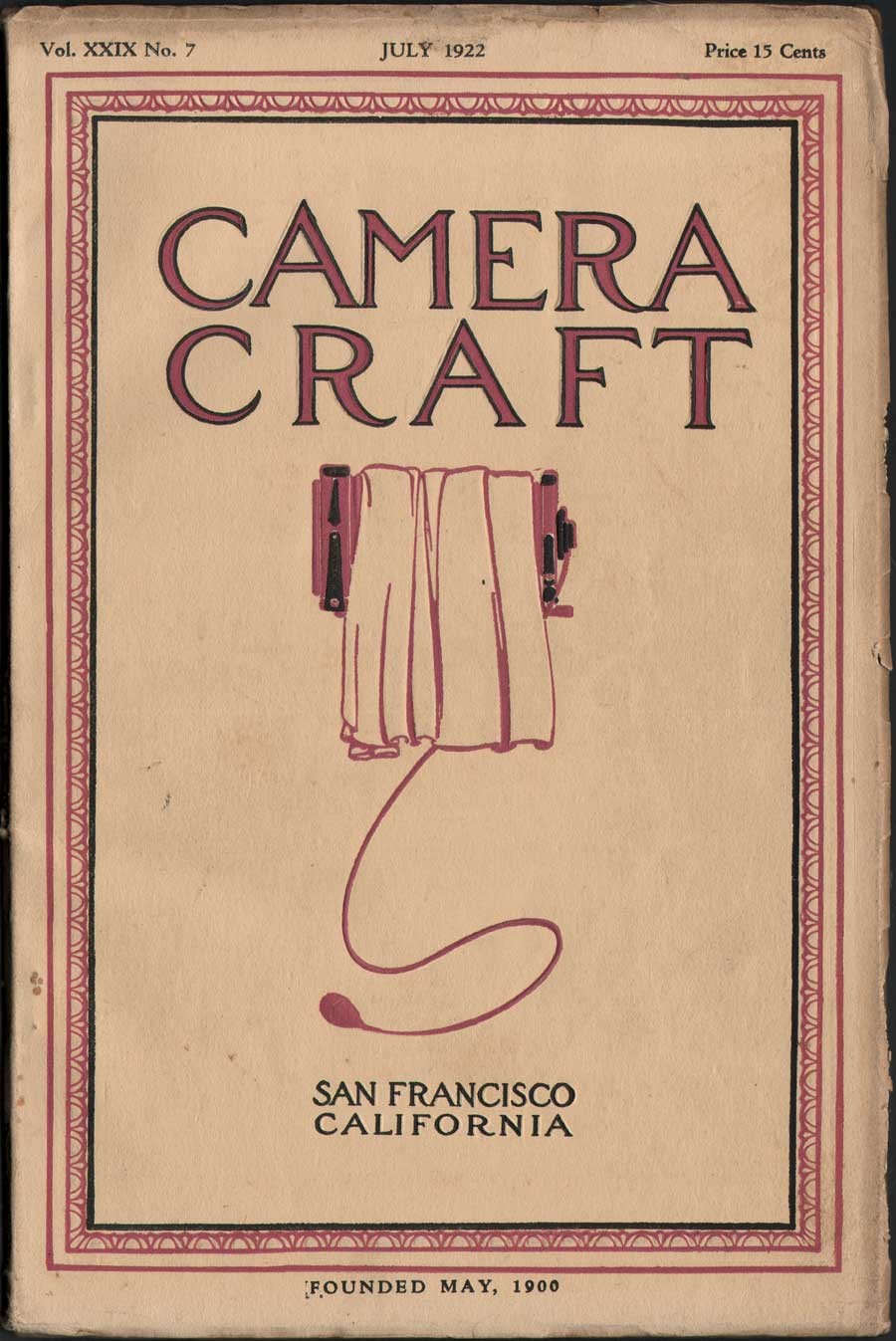 Cover Design: Camera Craft magazine: San Francisco, CA: July, 1922: 26.5 x 17.5 cm: two-color wood engraving : unknown artist and printer: cover price at upper right corner 15¢. This uncredited Camera Craft cover design first debuted with the January 1913 issue and featured a simple design of a plate camera shown in profile(lens board on right side) with dark cloth draped at center and bulb shutter release cable hanging down. This design lasted through the June, 1923 issue and was replaced with illustrations of architectural landmarks, notable western scenery and other thematic drawings done by San Francisco artist W.R. Potter through the September, 1924 issue. From: PhotoSeed Archive
Cover Design: Camera Craft magazine: San Francisco, CA: July, 1922: 26.5 x 17.5 cm: two-color wood engraving : unknown artist and printer: cover price at upper right corner 15¢. This uncredited Camera Craft cover design first debuted with the January 1913 issue and featured a simple design of a plate camera shown in profile(lens board on right side) with dark cloth draped at center and bulb shutter release cable hanging down. This design lasted through the June, 1923 issue and was replaced with illustrations of architectural landmarks, notable western scenery and other thematic drawings done by San Francisco artist W.R. Potter through the September, 1924 issue. From: PhotoSeed Archive
It was sometime in the 1890s, photographic historian Christian A. Peterson notes, that he “first used his wife’s Kodak camera to make snapshots and soon began searching the photographic periodicals for information and advice.” (7.) His editorship of Camera Craft as momentous professional occasion aside, Sig’s immersion in all things Photographic may very well have reached a high-point by 1933, the year he became a charter member of the Photographic Society of America as well as being honored a Fellow of the Royal Photographic Society.
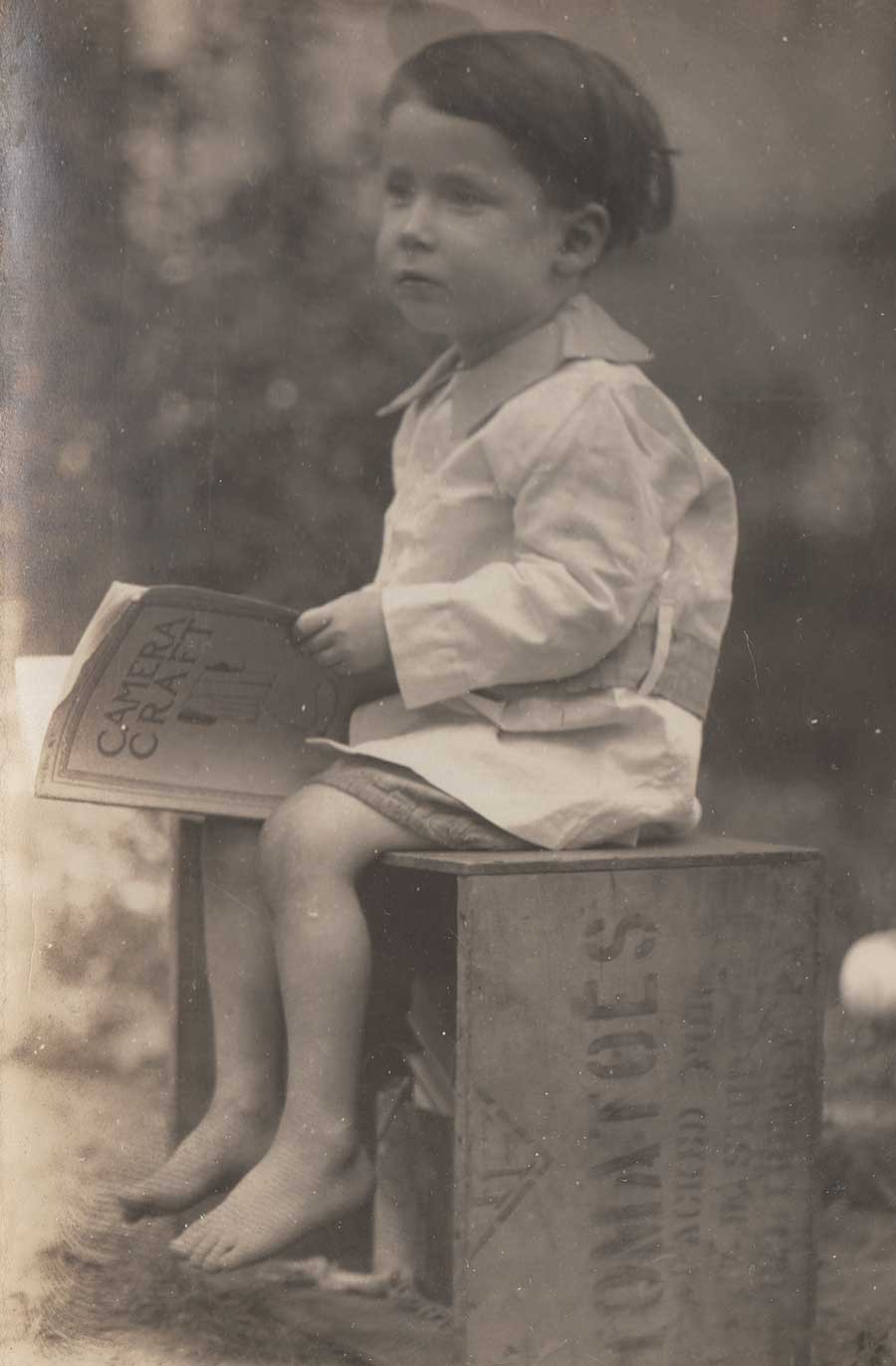 Detail: "Child Sitting on Tomato Crate Holding Camera Craft Magazine": by anonymous American photographer printed as unmailed postcard: gelatin silver print ca. 1920-25: 11.6 x 8.8 | 13.8 x 8.8 cm: written in graphite on verso: "with Love. Ellsworth" with the name "Walter" opposite address field. Child sits on crate stenciled on side as being from Pennsylvania-indicated "Packed For….PA " on side, with photo purchased from Parma, MI collector. From: PhotoSeed Archive
Detail: "Child Sitting on Tomato Crate Holding Camera Craft Magazine": by anonymous American photographer printed as unmailed postcard: gelatin silver print ca. 1920-25: 11.6 x 8.8 | 13.8 x 8.8 cm: written in graphite on verso: "with Love. Ellsworth" with the name "Walter" opposite address field. Child sits on crate stenciled on side as being from Pennsylvania-indicated "Packed For….PA " on side, with photo purchased from Parma, MI collector. From: PhotoSeed Archive
Photography in itself however was not his only reason for being during his professional career as editor, and even earlier as a musician. This was because Sig was a romantic at heart, a dreamer who had a great fondness for language, and the will to commit it to paper. Starting out for example, only in his early 20’s, he composed the following poem for the April, 1895 issue of the California-based magazine Overland Monthly:
PLEASURE.
PLEASURE is like perfect liquor,
Sweet to taste and after taste,
And like, too, in that when gotten
We imbibe too much, then waste,
And we find when pleasure passes
Life is empty as the glasses.
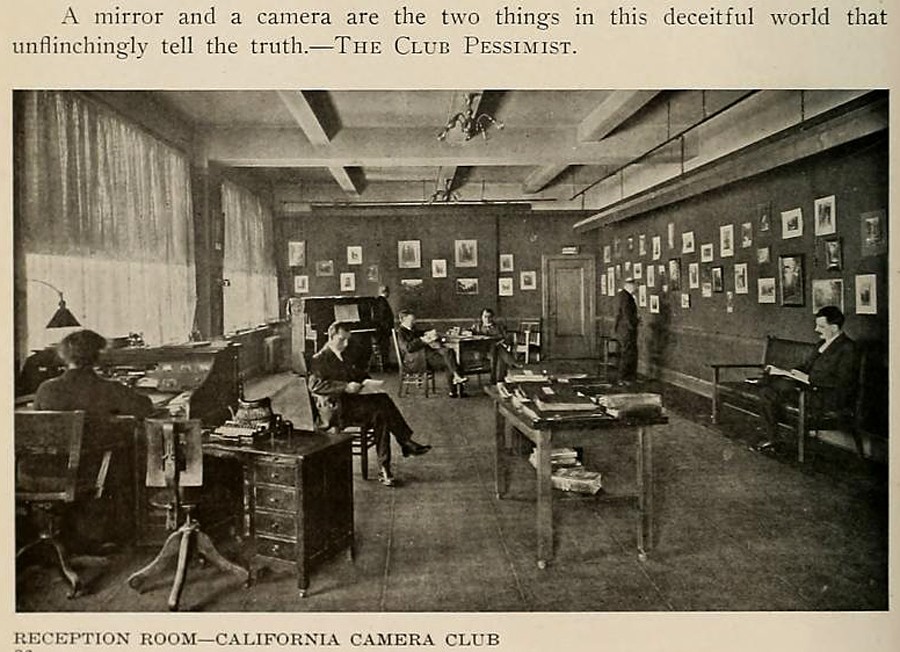 "Reception Room— California Camera Club": 1914: taken by an unknown photographer, this image appeared as a halftone illustration in the February, 1914 issue of Camera Craft for a story on the club, founded in 1890. At the time this appeared the club was located at 833 Market Street in San Francisco. The scene shows members seated with an exhibit of photographs on display at rear and on wall at right. Camera Craft regularly featured news of this important club, and future editor of the magazine Sigismund Blumann, although not a member, attended and was an occasional speaker. Photographic historian Christian A. Peterson notes Blumann spoke at this club in 1916 and much later, between 1934-40 attended gatherings here as well as at the Leica Club of Oakland, East Bay Camera Club, Golden Gate Miniature Camera Club, Photographic Society of San Francisco, San Jose Camera Club, and Western Amateur Camera Conclave. From: California State Library: Archive.org
"Reception Room— California Camera Club": 1914: taken by an unknown photographer, this image appeared as a halftone illustration in the February, 1914 issue of Camera Craft for a story on the club, founded in 1890. At the time this appeared the club was located at 833 Market Street in San Francisco. The scene shows members seated with an exhibit of photographs on display at rear and on wall at right. Camera Craft regularly featured news of this important club, and future editor of the magazine Sigismund Blumann, although not a member, attended and was an occasional speaker. Photographic historian Christian A. Peterson notes Blumann spoke at this club in 1916 and much later, between 1934-40 attended gatherings here as well as at the Leica Club of Oakland, East Bay Camera Club, Golden Gate Miniature Camera Club, Photographic Society of San Francisco, San Jose Camera Club, and Western Amateur Camera Conclave. From: California State Library: Archive.org
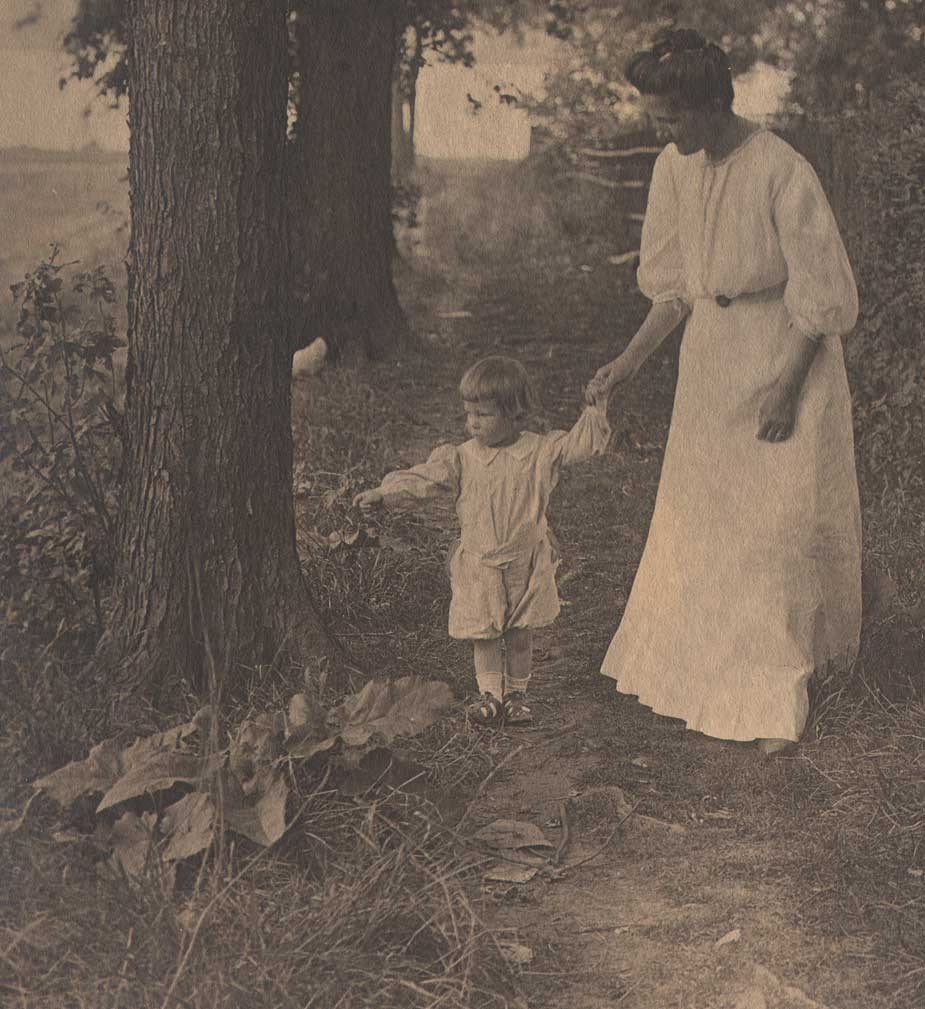 Detail: "Up the Path": Chester Moulton Whitney: American, b. 1873: 1914 or earlier: gelatin silver print: 24.8 x 19.3 cm: This photograph was illustrated as a full-page halftone with printed ornamental Art-Nouveau frame border in the August, 1914 Camera Craft, p. 422, and is a representative example of the pictorialist work that regularly appeared in its pages. From: PhotoSeed Archive
Detail: "Up the Path": Chester Moulton Whitney: American, b. 1873: 1914 or earlier: gelatin silver print: 24.8 x 19.3 cm: This photograph was illustrated as a full-page halftone with printed ornamental Art-Nouveau frame border in the August, 1914 Camera Craft, p. 422, and is a representative example of the pictorialist work that regularly appeared in its pages. From: PhotoSeed Archive
Wearing the hat of Poet-in-Residence at Camera Craft, Sig never neglected this early love of poetry for the publication, often combining his own photographic efforts alongside original compositions. One example, which he titled Lugubrio, though technically not even a real word, appeared in April, 1927, and was his way of simply assigning a mournful, or lugubrious meaning to his own photograph depicting jagged rocks and crashing waves-seen in his dramatic coastal landscape most likely taken on the Pacific coast:
LUGUBRIO
By Sigismund Blumann
The drowned and dead, now turned to stone,
Stand watching by the shore
And you may hear them through the night,
From set of sun to morning light,
As they shall do for evermore,
Weep as they watch, and moan. (p. 177)
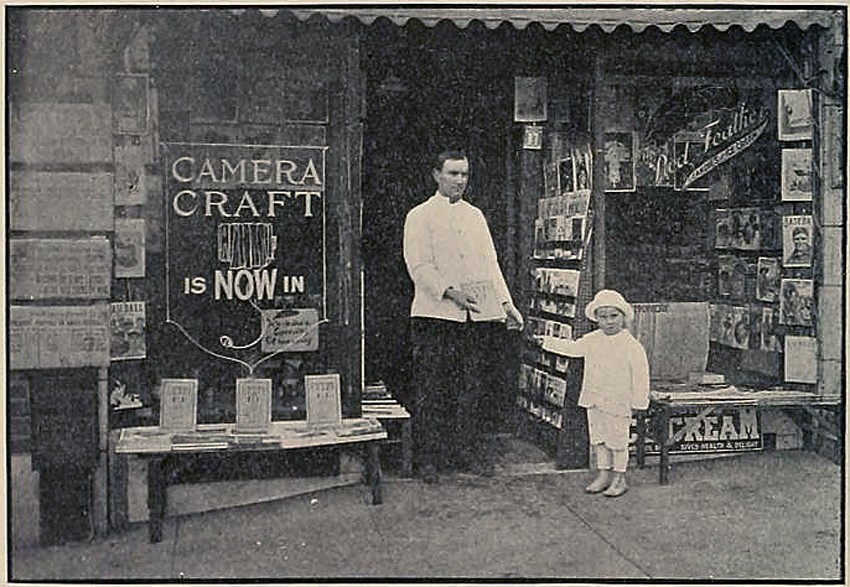 "Camera Craft is Now In": 1914: taken by an unknown photographer and used as a form of soft advertising, this image appeared as a halftone illustration in the June, 1917 issue of Camera Craft. It shows San Francisco business owner J.F. Brandert, owner of the Red Feather Store at 435 Jones Street, handing off a copy of the journal to a young visitor, with a display of three issues propped up on a bench at left in front of a window lettered with a graphic of the journal's cover: "CAMERA CRAFT IS NOW IN". From: California State Library: Archive.org
"Camera Craft is Now In": 1914: taken by an unknown photographer and used as a form of soft advertising, this image appeared as a halftone illustration in the June, 1917 issue of Camera Craft. It shows San Francisco business owner J.F. Brandert, owner of the Red Feather Store at 435 Jones Street, handing off a copy of the journal to a young visitor, with a display of three issues propped up on a bench at left in front of a window lettered with a graphic of the journal's cover: "CAMERA CRAFT IS NOW IN". From: California State Library: Archive.org
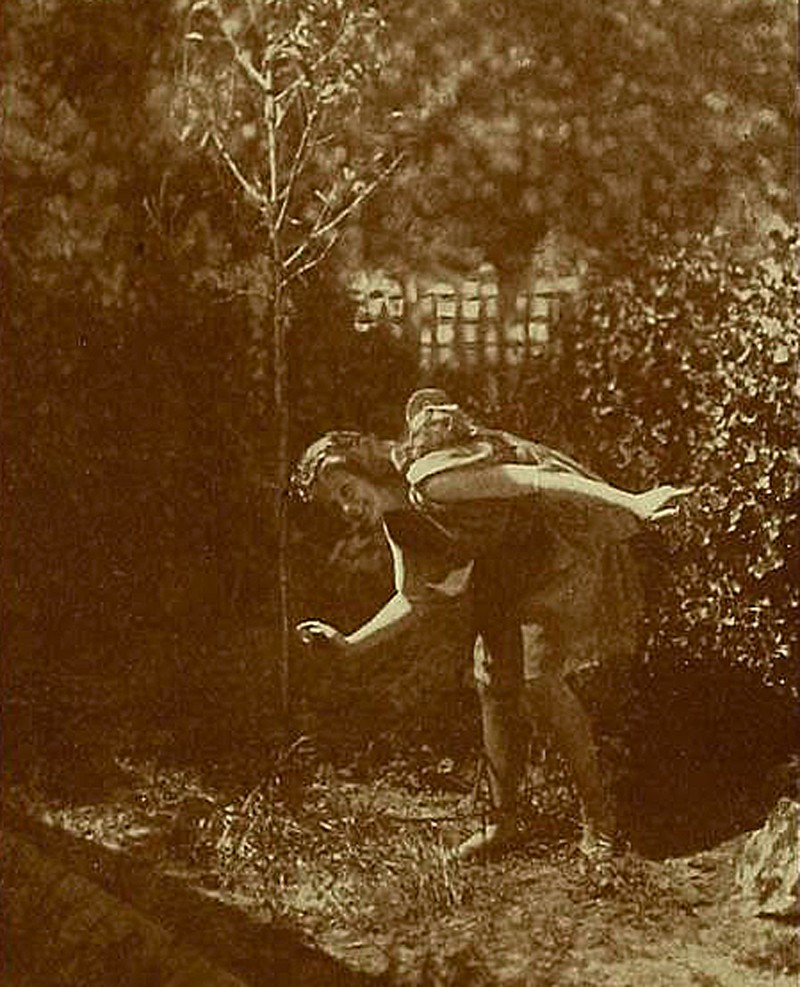 "When From Behind the Moondipt Bush Titania Floated in a Silver Haze": 1917 or before: Sigismund Blumann, American: This photograph was used as the frontis halftone for the July, 1917 issue of Camera Craft helping to illustrate the article "Poetry and Photography" written by Blumann. The photo shows Vera Hahn, a childhood friend of his eldest daughter Ethel Blumann. (b. 1902) He said of the photo: "She was costumed for a pageant and we all wanted a memento of the charming vision she made in our garden, among the green plants." This early example of Blumann's work also included one of his original poems titled "To Childhood": the first stanza: "Oh blessed youth! When from the enchanted page | Fancy stepped forth and made the unreal real, | When from behind the moondipt bush | Titania floated in a silver haze and greeted me! From: California State Library: Archive.org
"When From Behind the Moondipt Bush Titania Floated in a Silver Haze": 1917 or before: Sigismund Blumann, American: This photograph was used as the frontis halftone for the July, 1917 issue of Camera Craft helping to illustrate the article "Poetry and Photography" written by Blumann. The photo shows Vera Hahn, a childhood friend of his eldest daughter Ethel Blumann. (b. 1902) He said of the photo: "She was costumed for a pageant and we all wanted a memento of the charming vision she made in our garden, among the green plants." This early example of Blumann's work also included one of his original poems titled "To Childhood": the first stanza: "Oh blessed youth! When from the enchanted page | Fancy stepped forth and made the unreal real, | When from behind the moondipt bush | Titania floated in a silver haze and greeted me! From: California State Library: Archive.org
Camera Craft: Western Photographic Journal
Although he’d been a contributor to its’ pages in words and photos after the first decade of being founded, it would be 24 years from the journal’s 1900 founding until Sig would begin to establish an enduring legacy in the history of photography via his role as Editor-in-Chief of Camera Craft. Some historical background on the intents and purposes for this ground-breaking publication are in order.
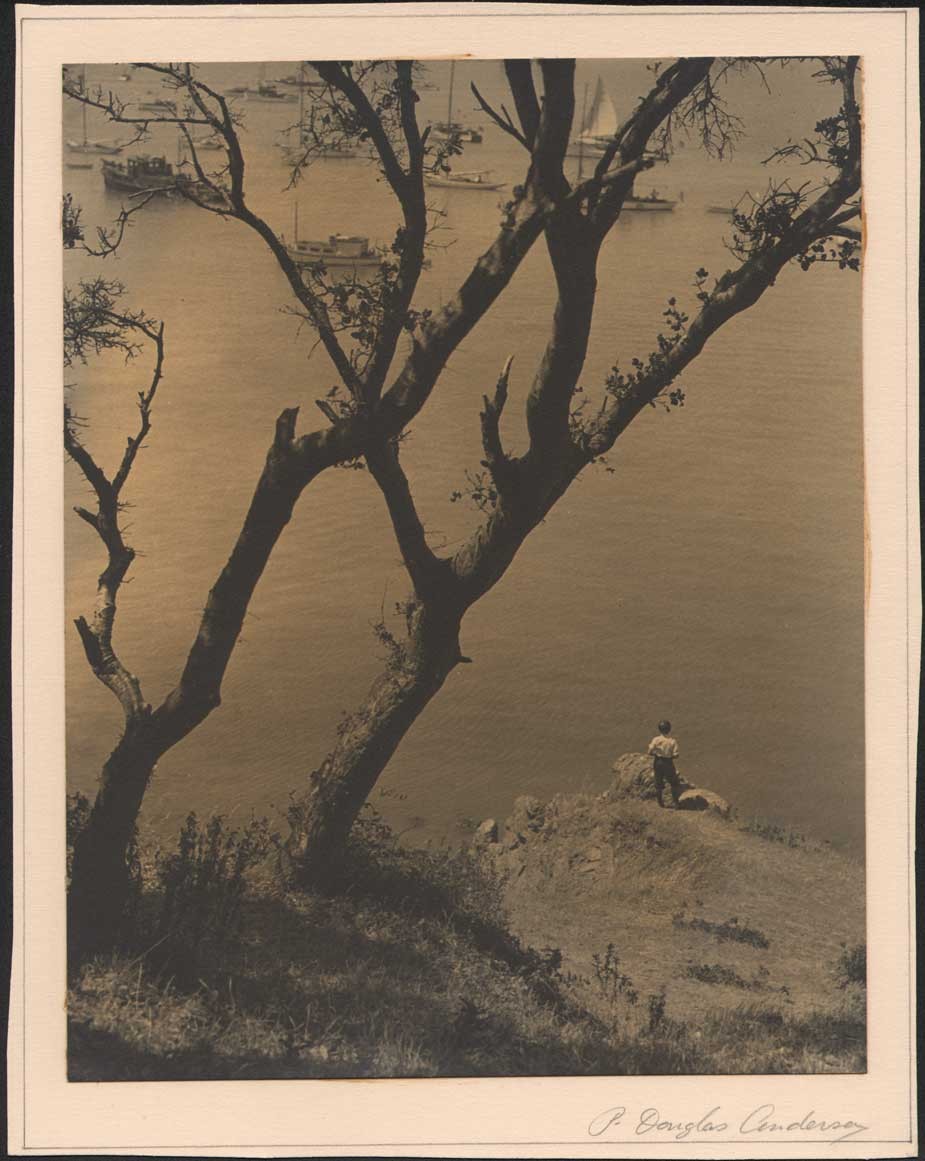 "Boy Looking out onto Bay" (San Francisco?-title supplied by this archive): ca. 1920-25: Paul Douglas Anderson, American 1887-1964: toned bromide or gelatin silver print: 24.2 x 19.0 | 27.5 x 21.6 cm: P. Douglas Anderson was an associate editor of Camera Craft beginning in May, 1923 & became editor-in-chief by January, 1924, continuing through the July issue. He was replaced by Sigismund Blumann the following month. Active in photography between 1910-1940's, Anderson was a member of the Camera Pictorialists of Los Angeles and Pictorial Photographers of America. From: PhotoSeed Archive
"Boy Looking out onto Bay" (San Francisco?-title supplied by this archive): ca. 1920-25: Paul Douglas Anderson, American 1887-1964: toned bromide or gelatin silver print: 24.2 x 19.0 | 27.5 x 21.6 cm: P. Douglas Anderson was an associate editor of Camera Craft beginning in May, 1923 & became editor-in-chief by January, 1924, continuing through the July issue. He was replaced by Sigismund Blumann the following month. Active in photography between 1910-1940's, Anderson was a member of the Camera Pictorialists of Los Angeles and Pictorial Photographers of America. From: PhotoSeed Archive
First based in San Francisco at 120 Sutter Street and issued monthly by the Camera Craft Publishing Company under the direction of editor W.G. Woods, the photographic journal Camera Craft was founded on the principles the West Coast of the United States should have an equal geographical mouthpiece of influence to counter that of the East Coast in promoting photography-for both professional and amateur workers. (to this end a separate page was devoted monthly to the happenings of many California amateur clubs) For the first issue of May, 1900, the following observations and arguments were made by the journal in support of these ideals:
The growth of photography, the introduction of simplifying methods in scientific picture-making, during the past twenty-five years is one of the wonders of the century. The phenomenal strides made by the photographic inventors of the world, resulting in the production of simple devices and convenient appliances, have made photography in all of its branches an almost universal fad. The Pacific Coast, ever ready to appreciate the merits of an innovation, has kept well abreast in the steady march of progress.
The wonderful climate of California lends itself enthusiastically to the wants of the photographer. The hand of Nature has reared, in eternal beauty, scenic effects unequaled elsewhere on earth. The very atmosphere of the Far West encourages the artistic impulse of its people. With such great natural advantages it is small wonder that when the western photographer has seen fit to cross the continent to compete with the eastern brotherhood he returns with laurels upon his brow. Not less wonderful is the existence of the largest Camera Club in the world in the city of the Golden Gate.
Yet, strange as it may seem, this great class of enthusiasts, this immense body of earnest workers has never been represented by a publication worthy of its trust. The photographers of the West have for years depended upon the journals of the East for enlightenment, but have looked in vain for recognition in their columns. It is to remedy this condition that Camera Craft now makes its bow to the public.
As to the scope of Camera Craft nothing can be said; it will have to speak for itself. The only promise made is the sincere intent on the part of the publishers to improve with each succeeding issue. The one hope of the magazine is that it may be so conducted as to meet the approbation of its readers and lend its aid to the material welfare of all interested in photography, whether for pleasure or for profit. (p. 26)
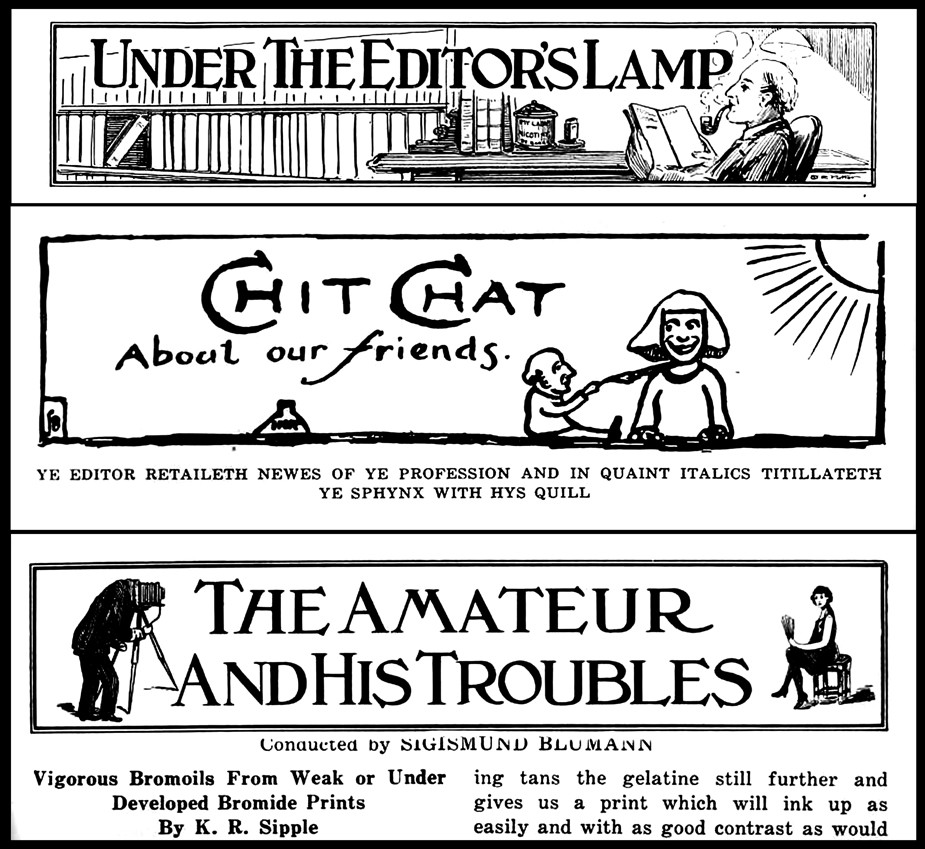 This triptych shows the three different Camera Craft magazine columns editor-in-chief Sigismund Blumann was involved with during his tenure at the journal from 1924-1933. "Under The Editor's Lamp" at top featured a caricature of the editor puffing a way on his trusty pipe while "Chit Chat About our Friends" at middle is comically subtitled "Ye Editor Retaileth Newes of Ye Profession And In Quaint Italics Titillateth Ye Sphynx With Hys Quill". "The Amateur And His Troubles", "conducted", appropriately enough by the man who had once made his living as a musician and orchestra leader, who already a feature of the publication when Blumann took over. From: PhotoSeed Archive
This triptych shows the three different Camera Craft magazine columns editor-in-chief Sigismund Blumann was involved with during his tenure at the journal from 1924-1933. "Under The Editor's Lamp" at top featured a caricature of the editor puffing a way on his trusty pipe while "Chit Chat About our Friends" at middle is comically subtitled "Ye Editor Retaileth Newes of Ye Profession And In Quaint Italics Titillateth Ye Sphynx With Hys Quill". "The Amateur And His Troubles", "conducted", appropriately enough by the man who had once made his living as a musician and orchestra leader, who already a feature of the publication when Blumann took over. From: PhotoSeed Archive
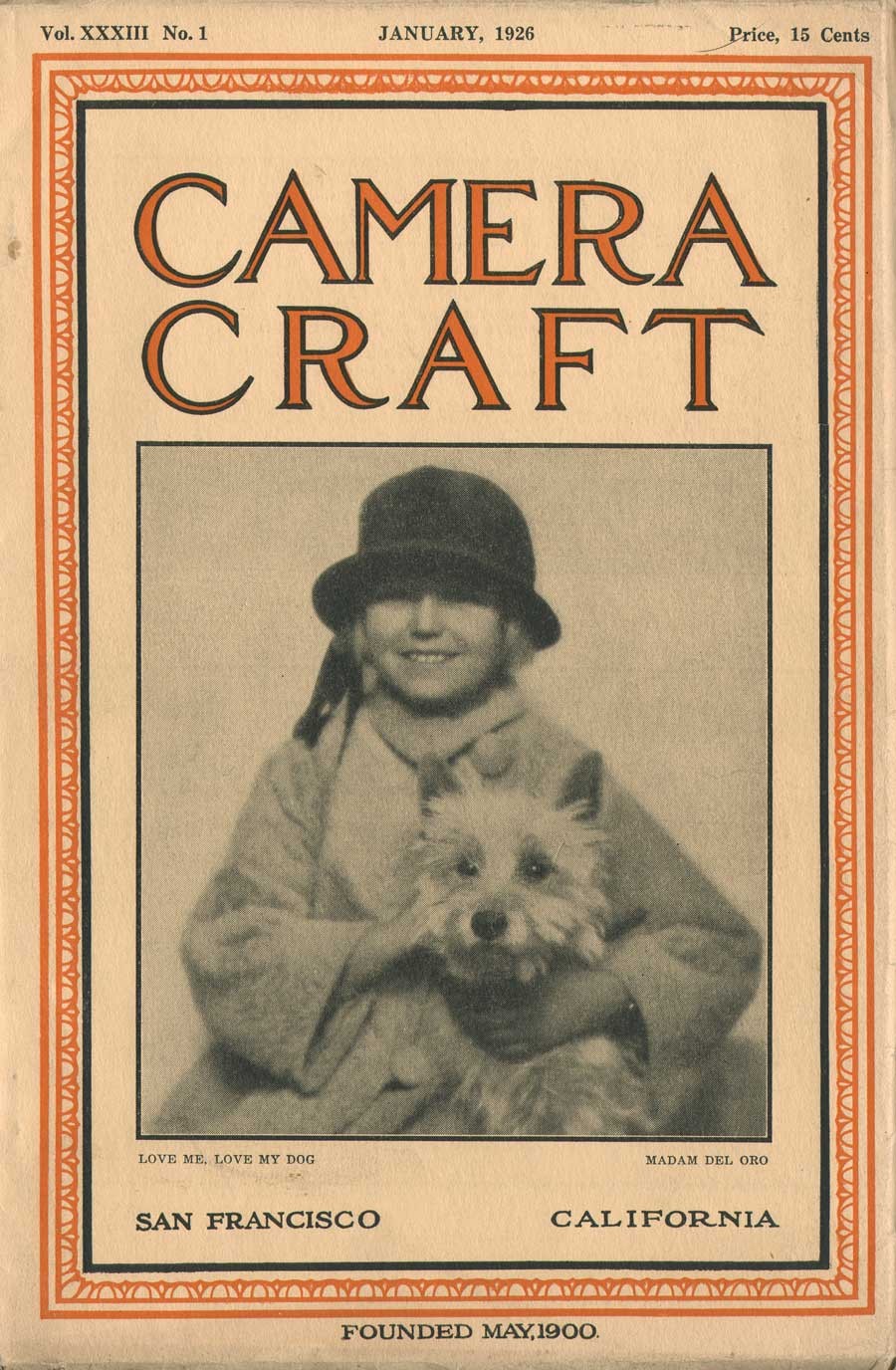 Cover Design: Camera Craft magazine: San Francisco, CA: January, 1926: Press of the Hansen Company, San Francisco: 26.5 x 17.5 cm: two-color wood engraved border design with inset halftone photograph: "Love Me, Love My Dog" by Madam Del Oro: American? 13.3 x 12.1 cm : cover price at upper right corner 15¢. One of the journal's seemingly obvious decisions, at least for the time, was to feature an actual photograph as a cover illustration for Camera Craft. Editor Blumann made this decision beginning with the October, 1924 issue. From: PhotoSeed Archive
Cover Design: Camera Craft magazine: San Francisco, CA: January, 1926: Press of the Hansen Company, San Francisco: 26.5 x 17.5 cm: two-color wood engraved border design with inset halftone photograph: "Love Me, Love My Dog" by Madam Del Oro: American? 13.3 x 12.1 cm : cover price at upper right corner 15¢. One of the journal's seemingly obvious decisions, at least for the time, was to feature an actual photograph as a cover illustration for Camera Craft. Editor Blumann made this decision beginning with the October, 1924 issue. From: PhotoSeed Archive
With its second issue for June, ambitions quickly shifted in support of the establishment of a West-Coast professional organization:
“Camera Craft intends to agitate the question of a Pacific Coast Convention of photographers. General inquiry throughout the state has led to the belief that such a convention is not only desirable but an actual need to those who make their living through the lens and shutter.” …We recall instances where photographers of this coast have attended conventions in the East and have returned with easy honors. Camera Craft would be pleased to learn of a serious consideration of the idea. A convention held in San Francisco with a first-class salon as an adjunct would undoubtedly lead to a permanent organization, and result in the advancement of the craft in a manner hitherto untried.” (p. 68)
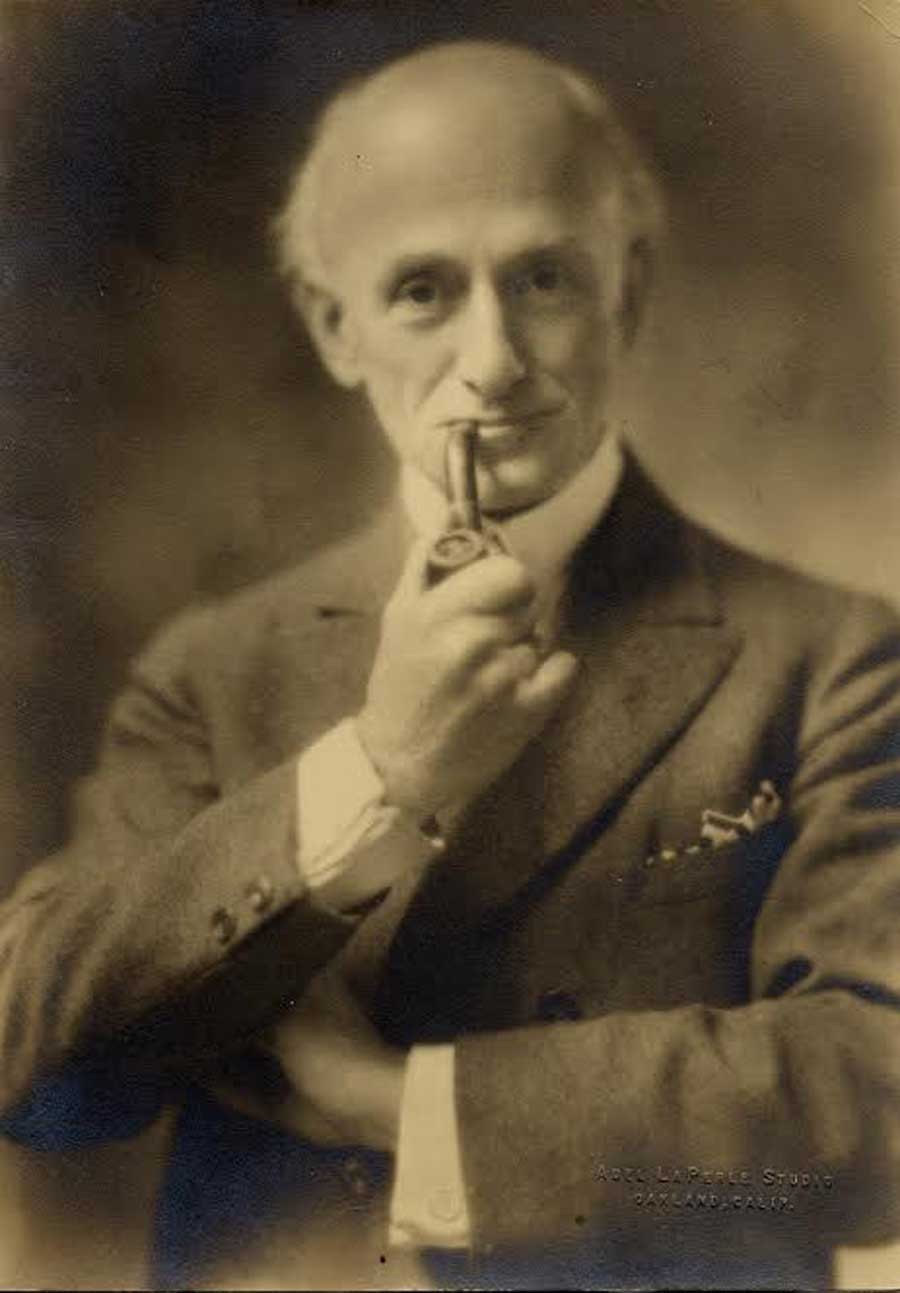 "Portrait of Sigismund Blumann": ca. 1928: Adel LaPerle Studio, Oakland, CA: gelatin silver print: Blumann was editor-in-chief of San Francisco-based Camera Craft magazine from 1924-1933: Photograph courtesy Thomas High
"Portrait of Sigismund Blumann": ca. 1928: Adel LaPerle Studio, Oakland, CA: gelatin silver print: Blumann was editor-in-chief of San Francisco-based Camera Craft magazine from 1924-1933: Photograph courtesy Thomas High
Although preceded geographically and in scope by the Pacific Coast Photographer, a short-lived monthly established in 1892 and believed to have ceased publication several years later, Camera Craft thrived as a robust Western photographic journal for the next 41 years. It first accomplished this under the capable tenure of editor Fayette J. Clute in the early decades of the publication before Sig took over in 1924, and was carried forward by him and others until the economic and human realities of World War II forced it’s hand. This occurred after the March, 1942 issue, when Camera Craft ironically headed back East so to speak, when it was absorbed by the Boston-based American Photography magazine. An editorial appearing in the final issue stated the decision to cease publishing was made because editor George Allen Young was taking his place in the armed services among other realities.
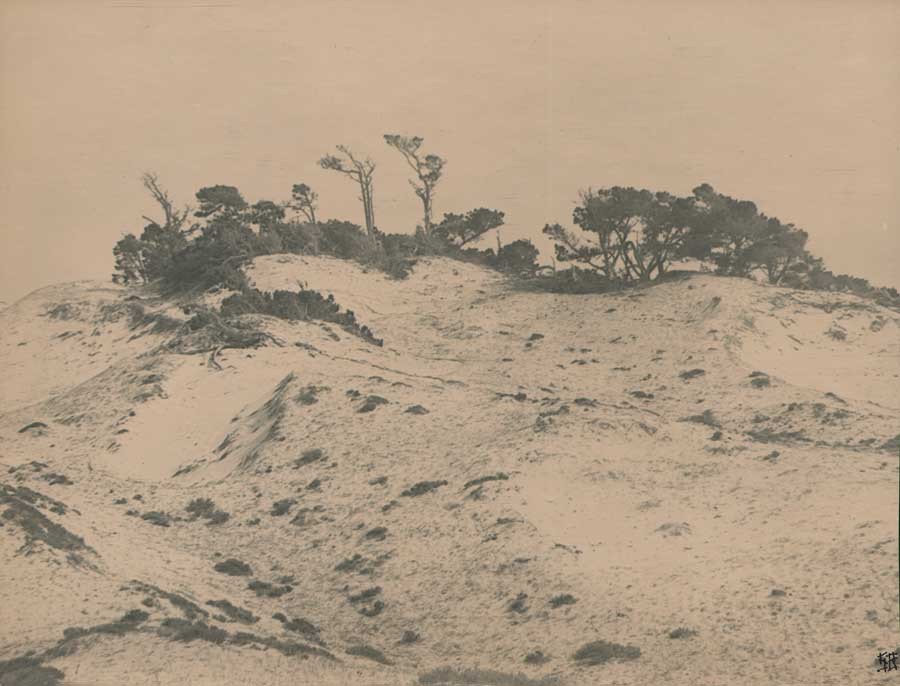 "Japonica" : Sigismund Blumann, American: ca 1920-40. gelatin silver print: 17.2 x 22.3 cm : This is a fine example of Blumann's pictorialist landscape work showing sand dunes and scrub trees, and was most likely taken on the West coast of the United States. Variants of this photograph have been similarly titled by the artist "Dune Pattern" and "Japanesque". This example signed in stylized Japanese initials at lower right corner: "SB". Three variants held by Minneapolis Institute of Arts: Accession #s: 99.230. (13-15) : From: PhotoSeed Archive
"Japonica" : Sigismund Blumann, American: ca 1920-40. gelatin silver print: 17.2 x 22.3 cm : This is a fine example of Blumann's pictorialist landscape work showing sand dunes and scrub trees, and was most likely taken on the West coast of the United States. Variants of this photograph have been similarly titled by the artist "Dune Pattern" and "Japanesque". This example signed in stylized Japanese initials at lower right corner: "SB". Three variants held by Minneapolis Institute of Arts: Accession #s: 99.230. (13-15) : From: PhotoSeed Archive
Sig As Camera Craft Editor: 1924-33
Photographic historian Christian A. Peterson, who called Camera Craft “the leading West Coast photographic monthly” and whose in-depth reassessment of Sigismund Blumann’s life and career was cited at the conclusion of Tom High’s short biography of his grandfather, called Sigismund Blumann:
”a prominent tastemaker in Californian photography during the 1920s and 1930s”. (8.)
Having an audience of 8000 monthly Camera Craft readers after coming aboard as chief editor in 1924 was surely a great start to becoming a tastemaker, but Sig proved his worth during the following nine years for his ability to impart to readers the essential knowledge of the ever-changing progress of photography. This took place in conjunction with his maintaining the vision of remaining true to himself-no matter how quirky some of his readers undoubtedly perceived him- while unashamedly promoting photographic talent in the pages of the magazine where he saw fit.
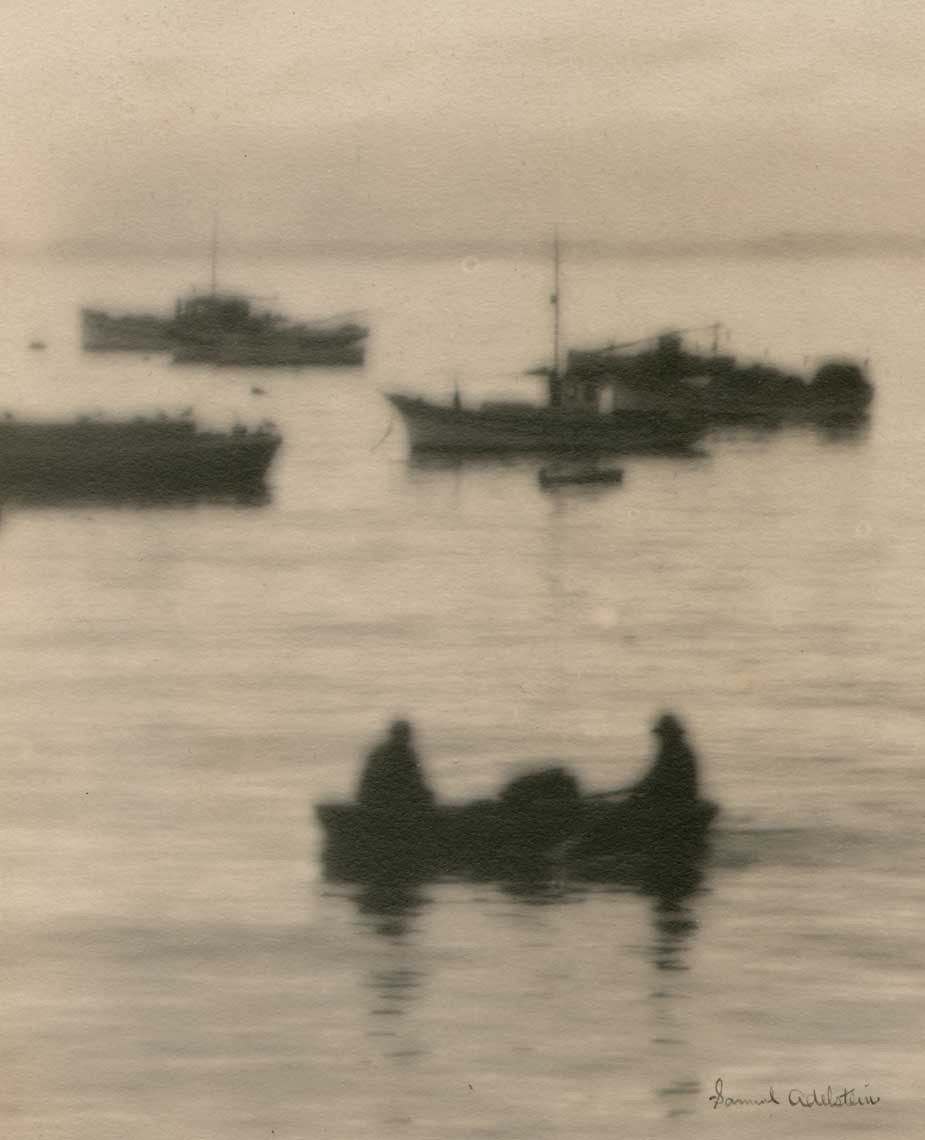 Detail: "Fishing Boats at Anchor" (probably Monterey Bay, CA) Samuel Adelstein, American, California: b. 1866?-d. 1934: silver bromide print ca. 1920-25: 18.5 x 13.6 | 40.6 x 25.4 cm: Adelstein was an active member of the California Camera Club whose pictorial works including a series of nude studies were published in Camera Craft in January, 1918 as part of the article: "An Enthusiast's Experience". The year before, the journal stated he was "an enthusiastic amateur photographer, a native son, a Director of the California Camera Club, and one of the Board of Governors of the Civic League of Improvement Clubs and Associations": Immersing himself in the art of photography around 1916, he specialized in making enlargements (from sharp negatives) with a soft-focus Verito lens. From: PhotoSeed Archive
Detail: "Fishing Boats at Anchor" (probably Monterey Bay, CA) Samuel Adelstein, American, California: b. 1866?-d. 1934: silver bromide print ca. 1920-25: 18.5 x 13.6 | 40.6 x 25.4 cm: Adelstein was an active member of the California Camera Club whose pictorial works including a series of nude studies were published in Camera Craft in January, 1918 as part of the article: "An Enthusiast's Experience". The year before, the journal stated he was "an enthusiastic amateur photographer, a native son, a Director of the California Camera Club, and one of the Board of Governors of the Civic League of Improvement Clubs and Associations": Immersing himself in the art of photography around 1916, he specialized in making enlargements (from sharp negatives) with a soft-focus Verito lens. From: PhotoSeed Archive
But some things remained the same after he took over. One, perhaps appropriate considering his musical background, was his retention of the subhead: “Conducted by Sigismund Blumann” for the journal’s long-established editorial column The Amateur And His Troubles previously edited by Paul Douglas Anderson. This time, an actual orchestra conductor was indeed stepping in to conduct editorial affairs! Keeping this personal touch intact-especially to those who knew him as someone passionate of music his entire life, was just one way of his remaining connected with readers as well as professional and social acquaintances in the Bay Area. Under Sig’s moderation, the column continued to offer advice dispensed by any number of well regarded authors who broke down and offered solutions to problems encountered by amateurs in the field relating to anything from photographic equipment to darkroom dilemmas.
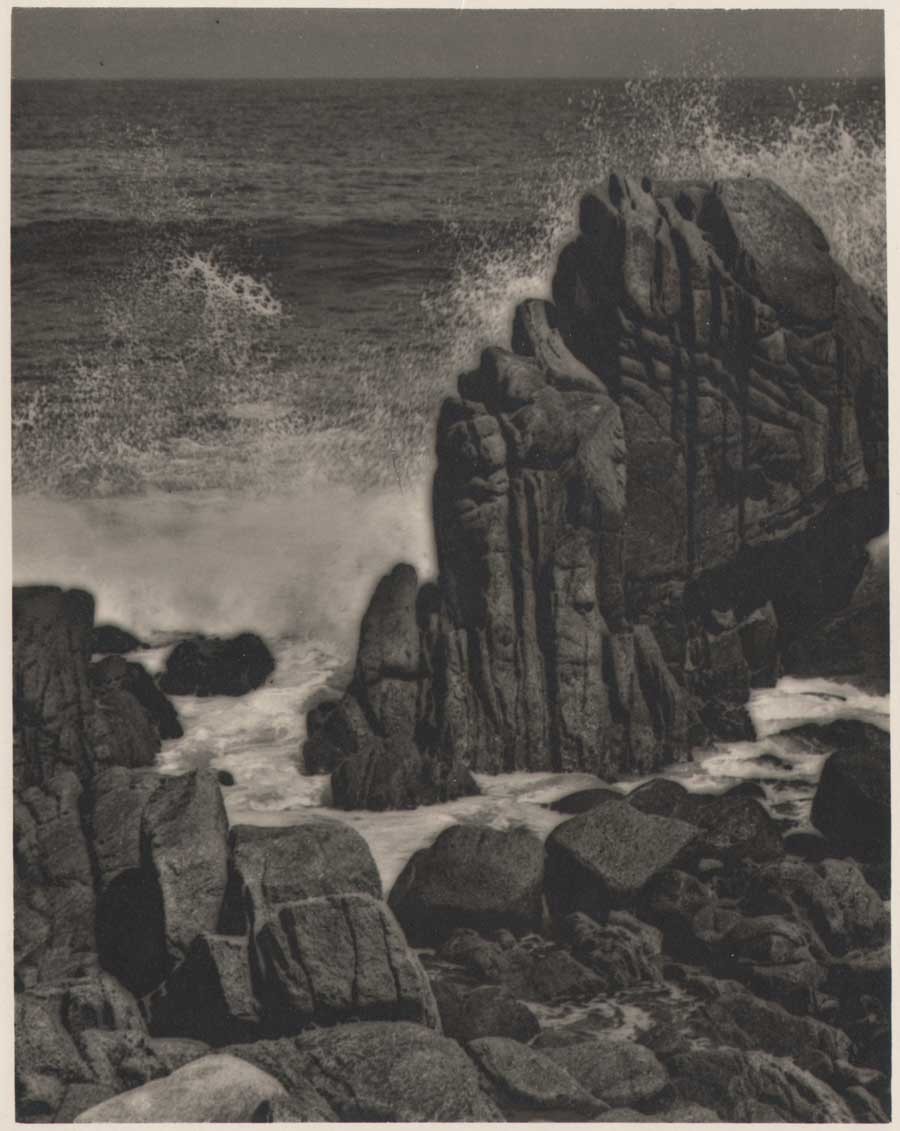 "Lugubrio": Sigismund Blumann, American: 1927 or before: gelatin silver print: 20.8 x 16.4 | 25.3 x 20.1 cm: This image, reproduced as a large halftone, was published on the same page as an accompanying poem of the same title for the April, 1927 issue of Camera Craft. The scene was most likely taken along the Pacific coastline. From: PhotoSeed Archive
"Lugubrio": Sigismund Blumann, American: 1927 or before: gelatin silver print: 20.8 x 16.4 | 25.3 x 20.1 cm: This image, reproduced as a large halftone, was published on the same page as an accompanying poem of the same title for the April, 1927 issue of Camera Craft. The scene was most likely taken along the Pacific coastline. From: PhotoSeed Archive
His second column, a new feature which debuted with the November, 1924 issue, was called CHIT CHAT About our friends. A vehicle for Sig’s effusive boosterism of photography in general, both professional and amateur, it was written in a style that might best be described, amusingly, as slightly syrupy in tone but delivered with erudition. Profiles on photographers he found interesting, and news of California camera clubs were a constant monthly feature of the column in addition to news of major upcoming exhibitions as well as critiques and results from those salons happening not only on the West Coast but throughout the United States and beyond. Comically subtitled: “Ye Editor Retaileth Newes of Ye Profession And In Quaint Italics Titillateth Ye Sphynx With Hys Quill”, the column’s “titillations” were often just longish aphorisms managing implied or direct associations to something photographic. Appearing rather infrequently at the column’s outset and disappearing altogether by August, 1931 when this inventive take on the English language was eliminated, they appeared from time to time, with several reprinted below for his January, 1926 column:
“Every time you get the best of a customer you have cheated yourself.”
“The most expensive lens may not be the best but the cheapest is pretty sure to be the worst.”
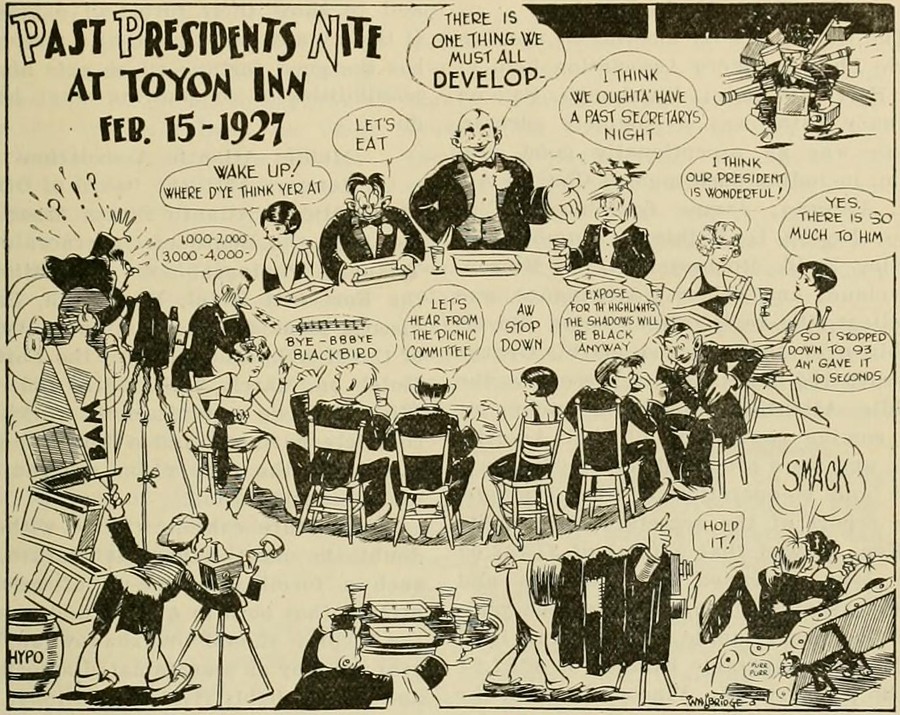 "Past Presidents Nite At Toyon Inn Feb. 15- 1927" : by artist W.A. Bridge, American -California? : Used as a halftone in the March, 1927 issue of Camera Craft, this humorous cartoon illustrated a dinner dance commemorating a gathering of past presidents of the Pacific International Photographers' Association which took place at San Leandro's Toyon Inn on Feb. 15, 1927. Sigismund Blumann, who served as host of the event, made sure to comment in the pages of Camera Craft magazine that "refreshments" of a most unusual kind: ie: inebriating, were served at the event during the era of American Prohibition. From: California State Library: Archive.org
"Past Presidents Nite At Toyon Inn Feb. 15- 1927" : by artist W.A. Bridge, American -California? : Used as a halftone in the March, 1927 issue of Camera Craft, this humorous cartoon illustrated a dinner dance commemorating a gathering of past presidents of the Pacific International Photographers' Association which took place at San Leandro's Toyon Inn on Feb. 15, 1927. Sigismund Blumann, who served as host of the event, made sure to comment in the pages of Camera Craft magazine that "refreshments" of a most unusual kind: ie: inebriating, were served at the event during the era of American Prohibition. From: California State Library: Archive.org
Lastly, and most importantly, one of the most personal reasons for Camera Craft’s success under Sig was his entirely self-written Under the Editor’s Lamp column, debuting with the April, 1926 issue. Already a fixture by means of the pen to his many readers-in prose as well as poetry- the column gave a final say so to speak to his personal views-conservative to be sure-on just about anything going on regarding photography and musings on current events. With accompanying column artwork by California artist W.R. Potter portraying Sig kicking back while puffing his pipe and seated at a library desk, the column became an effective way for this journal’s Editor-in-Chief to assume the role of oracle and brand ambassador. Sig’s short forward for his first Under the Editor’s Lamp :
When the desk is cleared of paste-pot and shears and the lamp is lit, it is good to put a match to the freshly loaded, old pipe and take a puff or two, letting the mind’s mind relax into mere dreams. The lamp is a sentimental fiction, of course, being a standardized glass bowl with a bulb glowing through, but the pipe is real, the mood is sincere, and we hope the mind exists, more or less.
Out go our thoughts to readers unseen, perhaps never to be met except as a large, critical, voracious body of men and women who consume the forty-eight pages of pictures and text and off-hand decide the fare has been very good, fair, or rotten. Little do they care what labor, what hopes, what ambitions went into every line and every illustration. Why should they. The best is no better than their due. (p.180)
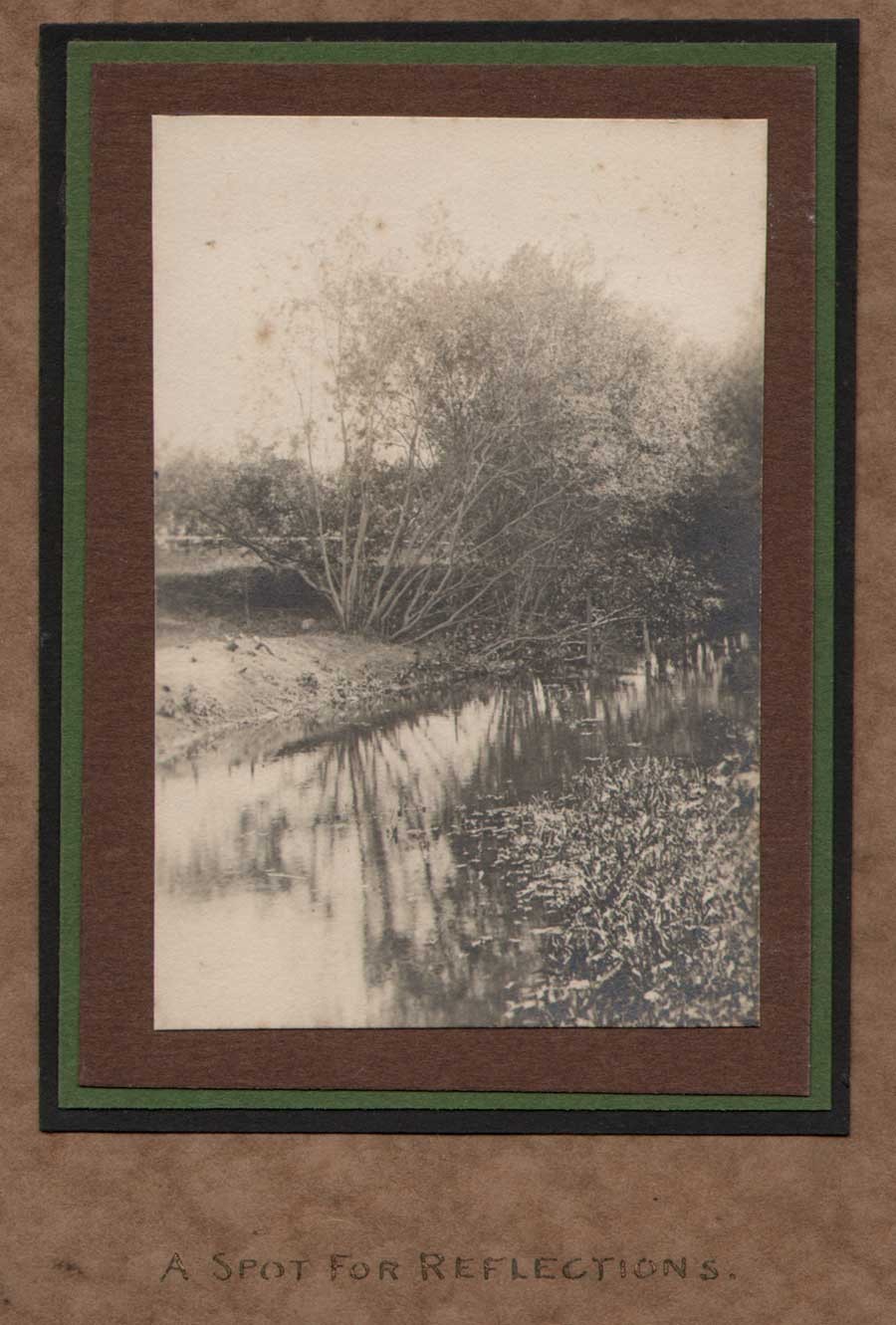 "A Spot for Reflections": Sigismund Blumann, American: ca. 1925-30: gelatin silver print : 9.8 x 6.5 | 18.2 x 14.5 cm : perhaps taken in Oakland or the Inverness area of Marin County, CA, this is a fine example of Blumann's pictorialist work in which he has titled the composition in gold lettering and triple-mounted the image onto fine art paper supports. From: PhotoSeed Archive
"A Spot for Reflections": Sigismund Blumann, American: ca. 1925-30: gelatin silver print : 9.8 x 6.5 | 18.2 x 14.5 cm : perhaps taken in Oakland or the Inverness area of Marin County, CA, this is a fine example of Blumann's pictorialist work in which he has titled the composition in gold lettering and triple-mounted the image onto fine art paper supports. From: PhotoSeed Archive
M.Q. Developer to Develop Good Feeling
Because Camera Craft billed itself the official organ of the Pacific International Photographers’ Association, (PIPA) with owner Ida M. Reed acting as Secretary and headquartered in the same San Francisco offices as the journal, (703 Market in Claus Spreckles Building) news of the Association-which covered a wide western geographic area including membership from Alaska, Alberta, Arizona, British Columbia, California, the Hawaiian Islands, Idaho, Montana, Nevada, Oregon, Utah and Washington states- became a regular monthly feature of the previously discussed Chit-Chat column. By 1927, Sig was hitting full-stride at Camera Craft, his writing skills undoubtedly honed through his reminisces featured in the Editor’s Lamp column.
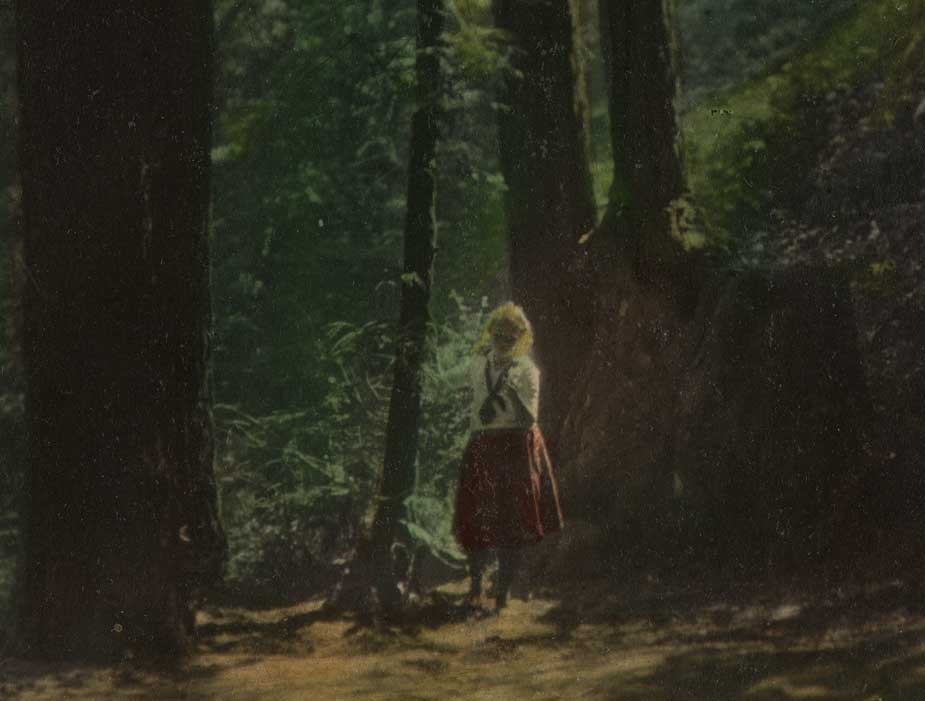 Detail: "Vera in the Woods": Sigismund Blumann, American: 1920-25: hand-colored gelatin silver print: 24.2 x 18.6 cm: Taken among a stand of Redwood trees, perhaps in the present-day Muir Woods National Monument in Marin County, CA, the subject of this photograph is believed to show the photographer's youngest daughter Vera Blumann, b. 1911. Blumann was in love with the outdoors, and frequently took part in extended camping trips with family members to hike and photograph areas of beauty in California and the Pacific Northwest-trips he wrote about in the pages of Camera Craft. See variant: Minneapolis Institute of Arts: Accession #99.231.15. From: PhotoSeed Archive
Detail: "Vera in the Woods": Sigismund Blumann, American: 1920-25: hand-colored gelatin silver print: 24.2 x 18.6 cm: Taken among a stand of Redwood trees, perhaps in the present-day Muir Woods National Monument in Marin County, CA, the subject of this photograph is believed to show the photographer's youngest daughter Vera Blumann, b. 1911. Blumann was in love with the outdoors, and frequently took part in extended camping trips with family members to hike and photograph areas of beauty in California and the Pacific Northwest-trips he wrote about in the pages of Camera Craft. See variant: Minneapolis Institute of Arts: Accession #99.231.15. From: PhotoSeed Archive
The following account is a result of this, of Sig’s prodigious social engagement with members active in the Bay-area camera club scene. In a humorous yet telling example of his own admission to preserve the rightful history of one particular PIPA (often referred to as a club) meeting for Chit-Chat, the March, 1927 issue duly reported on the Past Presidents Night dinner dance at San Leandro’s Toyon Inn on Feb. 15, 1927. Taking place when Prohibition was still the law of the land in America, (9.) Sig’s account made sure to include the lengths employed at the soirée in order for those attending to enjoy the social, and inebriating benefits of some “liquid cheer”:
But hold, before we close it must be chronicled as it shall be inscribed in the archives of the club that each guest found a developing tray and two glass graduates before him. It was a paper tray, so that when dropped the falling tray might not raise the deuce. In one of the two ounce graduates water was served and in the other M.Q. developer to develop good feeling. A bucket of Hypo was kept in the ante-room to fix the police, and everything was provided to make a perfect picture except bromide. If any was needed it was the next morning. (p. 145: M.Q. was an alkaline developer for gelatine emulsions combining Metol and hydroquinone)
 "Yosemite Falls | Yosemite Valley": Sigismund Blumann, American: dated 1926 & signed: "Dry Point Etching" ie: most likely a Kallitype or bleached and toned print on Vitava E (tching) chlorobromide paper: 13.1 x 9.0 | 23.7 x 16.5 cm: A specialist in alternative darkroom processes, particularly Kallitype, Blumann perfected his "Dry Point Etching" process and described it in lengthy articles in Camera Craft in 1925 and later in July, 1934 for his own Photo Art monthly using the pen name "Charles H. Fitzpatrick." This finished etching showing Yosemite Falls was originally taken as a photograph by Blumann in the Spring of 1925. Both photo and etching were illustrated side-by-side as halftones in the October, 1925 Camera Craft article titled "Making Photographs Into Dry Point Etchings". See the following citation at end of this caption in Notes field for a working description of the "Dry Point Etching" process. (11.) From: PhotoSeed Archive
"Yosemite Falls | Yosemite Valley": Sigismund Blumann, American: dated 1926 & signed: "Dry Point Etching" ie: most likely a Kallitype or bleached and toned print on Vitava E (tching) chlorobromide paper: 13.1 x 9.0 | 23.7 x 16.5 cm: A specialist in alternative darkroom processes, particularly Kallitype, Blumann perfected his "Dry Point Etching" process and described it in lengthy articles in Camera Craft in 1925 and later in July, 1934 for his own Photo Art monthly using the pen name "Charles H. Fitzpatrick." This finished etching showing Yosemite Falls was originally taken as a photograph by Blumann in the Spring of 1925. Both photo and etching were illustrated side-by-side as halftones in the October, 1925 Camera Craft article titled "Making Photographs Into Dry Point Etchings". See the following citation at end of this caption in Notes field for a working description of the "Dry Point Etching" process. (11.) From: PhotoSeed Archive
Camera Nut to the End
Considering he was having an awfully good time in his position as Editor-in Chief, an observation certainly not witnessed by this writer but most obvious by the written evidence left for posterity, Sig’s resignation at the end of July, 1933 does seem a bit abrupt. Historian Christian A. Peterson speculates he and owner Ida M. Reed “parted ways over deep differences.” (10.) But with the installation of Camera Craft veteran George Allen Young to replace him, Sig was none the less given deserved praise by owner Ida Reed the following month:
Since 1924 we, and the readers of this magazine, have enjoyed his contagious enthusiasm, and his wide technical knowledge of photography,. He leaves with our best wishes for success and happiness. (p. 387)
Earlier, for his final Under the Editor’s Lamp column written in July, 1933 and published the next month, his nine-year run at the journal concludes with a perhaps knowing, but certainly wistful remembrance of his good times spent there. Recounting adventures in photography that summer while traveling the California High Sierra, Sig first gives accolades to the efforts U.S. President Theodore Roosevelt was giving to get American industry moving again during the ongoing Great Depression before concluding by stating his own continued love affair with photography:
Does thinking of Yosemite and speaking of photography seem like reductum ad absurdum to you? It should not for I can allow myself so very short a time in that garden of The God and I can so effectively carry some of its glory and inspiration over the rest of the year with what my camera has enabled me to bring home, that it is natural to raise the picture, as near as imagination makes possible, to the original.
As I look at the screen and project the pictures, studying how to express my reactions when on the spot, I once again smell the pines and hear the rush of the Merced as it boils over the Happy Isles. In the quiet and the benignancy of the red light fancy builds Half Dome, El Capitan, and the Domes anew.
The old rags that made us free. The open spaces that made us immortal in spiritual disembodiment. The camera that vitalized every hour of the day with its assurance of creative picture making. Friends, I am glad, very glad, to be a camera Nut. (p. 343)
With that, a poem by Sig somehow seems a good fit in ending this remembrance about the young boy who moved to California and proceeded through hard work and perseverance to embrace the Golden State as his own. Along with possessing the gift of innumerable talents and more than a few dreams, he managed to share them with many others.
THE QUIET CORNER by Sigismund Blumann
A PIPE, some books, a flower or two,
The picture of one gone before
Who stands without the open door
And shall not die.
When work is through
Some day, some day, when rest is won
And the long, long duty-season done,
I’ll sit me down to taste the best
Of books, tobacco, men and things:
To listen when the spring-bird sings—
Looking in peace toward the West.
Against that day, and I am spared,
My quiet corner stands prepared.
To see all work by Sigismund Blumann in the PhotoSeed Archive please go here.
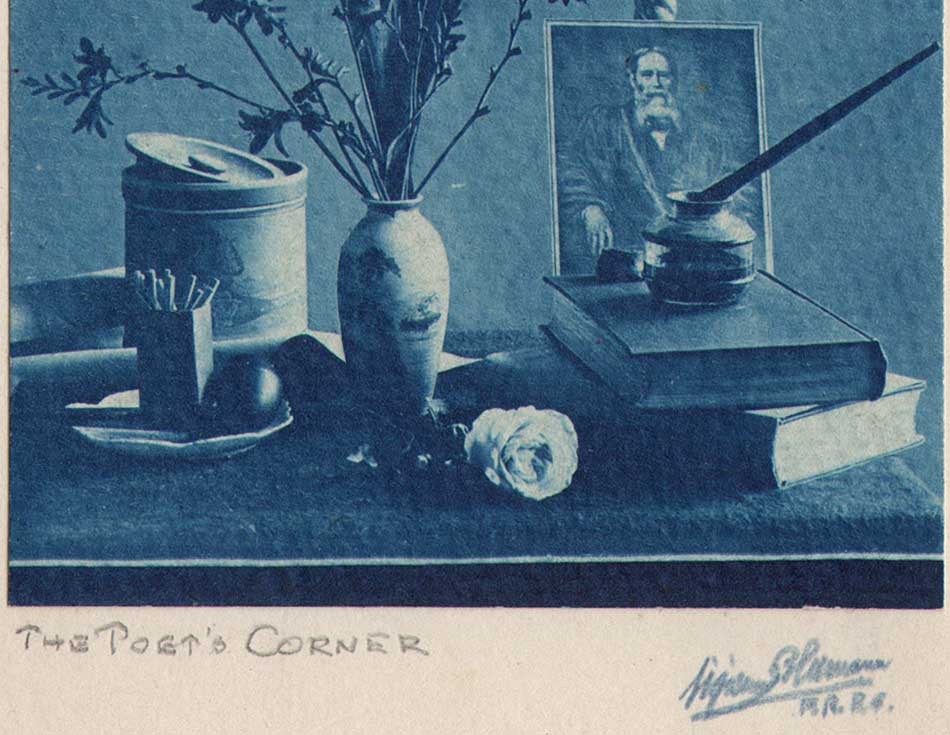 Detail: "The Poet's Corner" or "The Quiet Corner": Sigismund Blumann, American: 1933 or later: toned pigment print: 10.6 x 7.5 | 16.9 x 11.6 cm: The author's trusty pipe can be seen at left in this still-life table top study reproduced as the frontis halftone illustration for the August, 1927 issue of Camera Craft. From: PhotoSeed Archive
Detail: "The Poet's Corner" or "The Quiet Corner": Sigismund Blumann, American: 1933 or later: toned pigment print: 10.6 x 7.5 | 16.9 x 11.6 cm: The author's trusty pipe can be seen at left in this still-life table top study reproduced as the frontis halftone illustration for the August, 1927 issue of Camera Craft. From: PhotoSeed Archive
NOTES:
1. see: Early Years in Photography: “Sigismund Blumann, California Editor and Photographer”, by Christian A. Peterson in History of Photography, vol. 26, no. 1. (Spring 2002) p. 59.
2. Ibid: in: Photo Art Monthly, 1933-40: p. 73
3. It would not be until July, 1934, in an updated version of this 1925 Camera Craft article on describing the process of turning photographs into dry point etchings in Photo-Art Monthly, that evidence of Fitzpatrick and Blumann being the same person would seem to be confirmed. In it, the illustrated example of Blumann’s credited photograph titled “Land’s End” is also shown reproduced into the converted dry point etching with credit given to Fitzpatrick. Editorially, it might seem odd to continue this pen-name fiction with Blumann even going to lengths to construct a suspect history in 1925 of “Fitzpatrick’s” own beginnings although the reason was most likely intended as another way of imparting education on a topic deemed worthy and educational enough in the eyes and mind of the editor himself.
4. Copies of at least 43 documentary photographs, with several corresponding paper negative envelopes dated 1901 by Sigismund Bluman, were donated by his family to the California Historical Society where they can be viewed as part of the collection “The Chinese in California: 1850-1925.” The following link includes a smaller sampling of later printed examples, (some hand-colored) along with a rare surviving example titled “Ruin” (a detail included with this post) from 1906 of earthquake damage taken by the photographer as well as several portraits of Sig taken by others.
5. see: citation #1: p. 54.
6. excerpt: introduction: Making Photographs Into Dry Point Etchings: by Charles H. Fitzpatrick Illustrated by the Author: in: Camera Craft: October, 1925: San Francisco: p. 485.
7. see: citation #1 p. 54
8. Ibid: introduction: p. 53
9. American Prohibition was a nationwide constitutional ban on the sale, production, importation, and transportation of alcoholic beverages.
10. see: citation #1 p. 65
11. In order to make one of these etchings, the article instructs that after first selecting a printed photograph with little detail, the next step is to: “draw as much as he can on the photograph, using Higgins’ Water Proof India Ink. When this is absolutely dry the silver is completely bleached out with Bichloride of Mercury or Iodine-Iodide bleachers. The pen shading and finishing is then done with care, when the bleached and washed print has been dried.” From here, the article states a copy negative must then be made which is used to make the final second-generation finished (and reduced for effect) “etchings” using various grades of photographic paper: “The method of reproducing drawings is very simple. Place drawing on wall or easel and camera on firm support exactly centering lens on drawing, making exposure on a slow copy plate by diffused daylight or electric light, and develop for contrast. In copying it is advisable to reduce the image one-third smaller than the original as a finer line is thus secured which improves the finished print. The writer prefers a buff stock, matt paper of medium grade and heavy; and has found Vitava E just right: This is a matter of choice, however, as good prints may be secured on Azo, Velox, Cyco, Kruxo, Defender, Haloid, Barston, Charcoal Black or other matt papers. Proceed as in ordinary photographic printing then tone by re-development, using whatever process you prefer. I use Royal-Re-developer with pleasing results.” In the later 1934 article: “Etchings From and With Photographs”, “Fitzpatrick”goes further in depth on this etching process, adding that after the second-generation reduced copy print is made, the print could be “treated through all the usual solutions in the usual way and may be developed in any of the prescribed formulae for blue-black, jet-black, warm-black, or dark brown tones. Or it may be subsequently toned by the bleach and redevelop methods. The particular brown of an etching is easily gotten on Vitava Athena with a developer containing Athenon. Azo P-2 or 3, Vitava Athena E, Novira in the matt smooth or rough are all fine for the purpose. Gevalux gives a wonderful image in a true carbon black color and velvet crayon patine.” Continuing, the article offers a summary of the entire process: “That is all there is to the whole thing. You could not complicate it if you tried. Just make an enlargement, work on it with pen and ink, bleach out the silver leaving the ink image, photograph the line drawing, make as many etching-prints from the copy negative as you wish. Where can you go wrong? How can you fail?” He concludes by saying the maker of these etchings could also go “one step further by using hand-sensitized photographic papers for this final second-generation completed “etching”: “Furthermore, should you desire to print on colored papers or card- board of such surface as cannot be bought ready sensitized it will be a simple matter to sensitize any stock with the well known Blue Print solutions, or if the various shades of brown and black are wanted to resort to Kallitype. These processes are as cheap as they are easy to compound and use; they work on any paper not too saturated with chlorides or unfixed dyes. Kallitype is moreover a beautiful process in itself and prints endure according to the care in making them.”
